ICHNOLOGY-the study of animal traces (tracks,
burrows, etc.) Page 4
This
page was born 04/09/2024. Rickubis designed it.
(split it off from an older page.) Last update: 05/04/2024
Images
and contents on this page copyright ©2001-2024
Richard M. Dashnau
Go to Ichnology page 3
Go to Ichnology page 2
Go to Ichnology page 1
Go
back to my home page, Welcome
to rickubis.com
Go
back to the RICKUBISCAM
page.
----------------------------------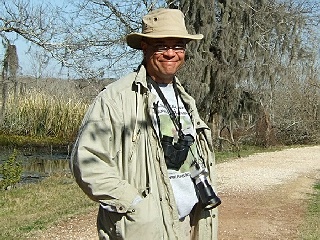
That's
me on the 40-Acre Lake Trail at Brazos Bend State Park (12/31/2007).Over the
years that I've been keeping these pages, making new observations and
learning
new things, I have met some
interesting people.
Two of them are Dr. Anthony Martin and Dr. Lisa Buckley, whom
I met online.
They study ichnology--animal
traces.
While the term is commonly used in relation to
fossils
(such as dinosaur tracks), it also applies to living creatures as well
(sometimes called "neoichnology"
with "paleoichnology" for fossils). One major
aspect of this study is that such traces can show animal behavior.
For instance, a single footprint might not say much,
except
what
kind of animal made it; but a series them might tell if the
animal
was running, or jumping etc. There are three basic factors
that
help to interpret traces: A) Substrate (the
material that holds the
trace) ; B) Anatomy (the part of the animal that affected the
substrate) and C) Behavior (what the animal was doing with the anatomy
that affected the
substrate). (see "The Three Pillars of
Ichnologic Wisdom" page 9 in Life Traces of the Georgia Coast
by
Anthony J. Martin) I admit that I am not very good at finding
and
interpreting
such traces. But, it is still fun to look and try to piece together the
mystery of what transpired at that spot before I got there. I
usually capture images of animals
activity. But every now and
then I've taken pictures of traces. I'll begin collecting
them
here. I will eventually arrange them in chronogical order of
some
kind. Many, many
thanks to Dr. Martin and Dr. Buckley for many
conversations via email and online; and for being supportive of my
amateurish efforts.
One
more thing: Although alligator burrows (or dens) and nests would be
considered ichnological traces. I've only got one example of an
alligator den on this page. I have
many observations of alligator dens, and have already gathered
them onto other
pages, starting here.
This page
is arranged with the newest entries at the bottom to follow the story
as it unfolded.
07/21/2023
(added 04\09\2024)While I was walking on my exercise path at Memorial
Park, I noticed tracks in the very fine grains of the dirt of the
trail. I stopped for a while to
take a short video showing the
tracks in the dirt before continuing the exercise and walking over
them. The images here are frame grabs from the video.
The round
holes are from emerged Cicada nymphs. Some of the tracks are probably
from Cicada nymphs. I've shot video of one crossing the dirt before,
and recogized the
wavy line in the center as being from the tip of
the abdomen being dragged through the dirt as the nymph crawled along.
Images and video of the crawling nymph
are on
ichnology page 1.
Since
I'd already walked in the dirt, the impressions of my shoe soles were
also captured in the fine grains. On the shoe sole impressions, each
square is about 7mm on each side, or
about .275 inches. While
filming the video, I had noticed the larger tracks--mostly from large
insects. When I reviewed the video for imaging use I noticed other,
smaller tracks
also criscrossing the others. I was there at
10am, so I assume most of the activity happened at night or early
morning. After this day, for some weeks after, I examined the
dirt
before I started my exercises. In the
pictures below, there are two parallel trails with another
crossing over both. Cicada hole in the closer views.
Interesting
"pinprick" traces that I can only
guess at. They aren't something
crawling, since they don't make a trail. Did something land at thos
spots and then fly off?

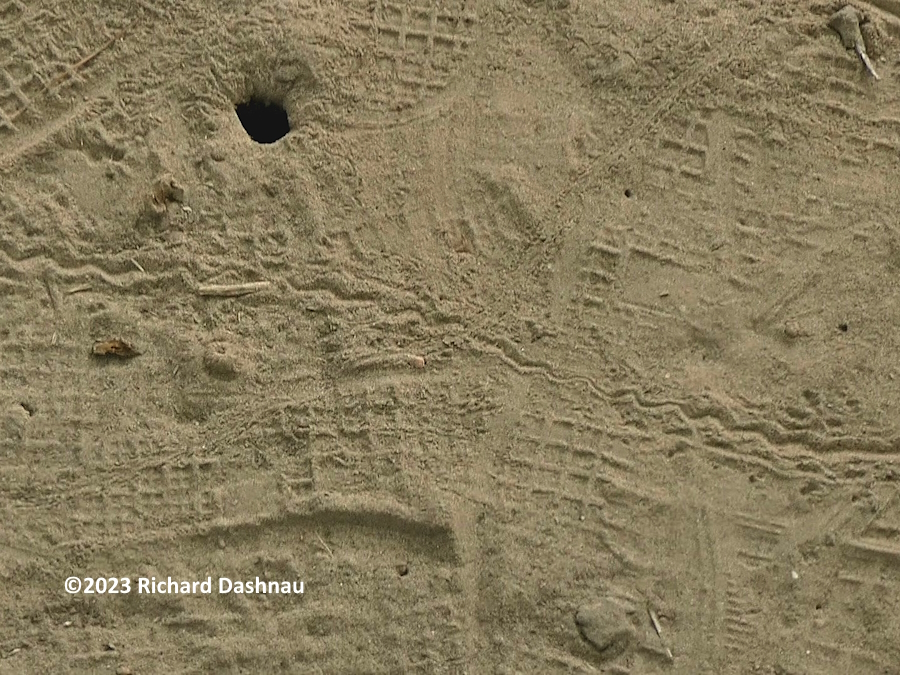
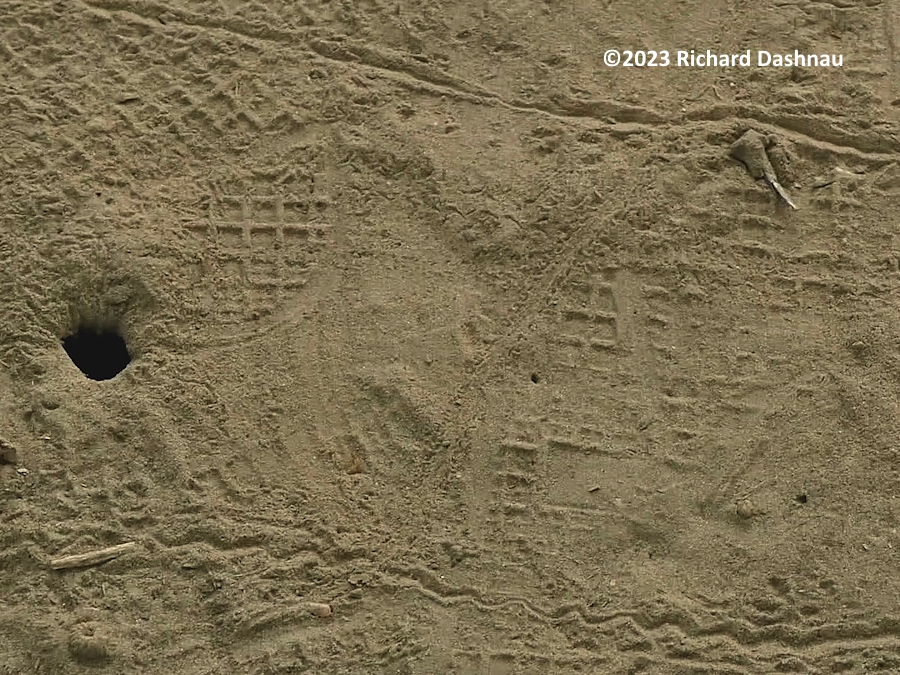
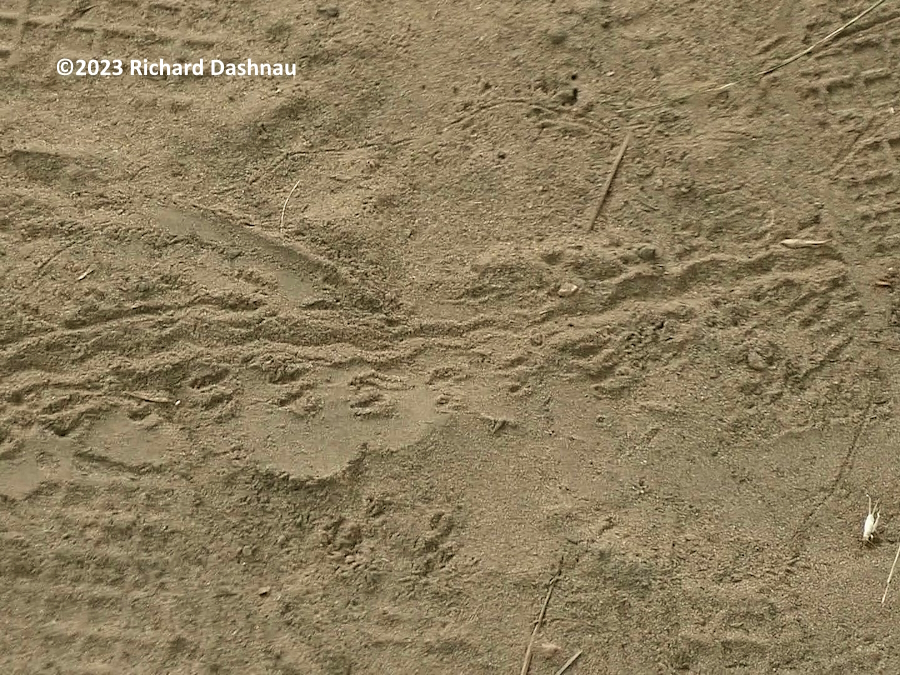
Some
history about this "path": Some of the exercises that I do by
walking in a circle that I usually make by using a tree as the
center point. It generally works out to be a circle with a
radius
of about 7 feet, or a 14-foot diameter circle. I started walking around
this tree in 2014--at
least I have video clips showing that. The exercises from then to now
(2024) have made a cleared
dirt
circle around the tree. When conditions are right (enough
time
for the area to remain dry), then I can see worm castings on the
surface, and the dirt becomes a finely-grained powder. As
best as I
can tell, I'm usually the only one that walks in the area (usually no
other human tracks are there.) Over the last few years I've
started paying more attention to the tracks in the dirt.
When
I did, I was surprised by the amount of activity that seems to be going
on there while I'm not around. I've aleady described some of what I've
found in previous years on the other
three ichnology pages (links
are on top and bottom of this page). This is the first of a
series of fun observations that I made there over the next few weeks.
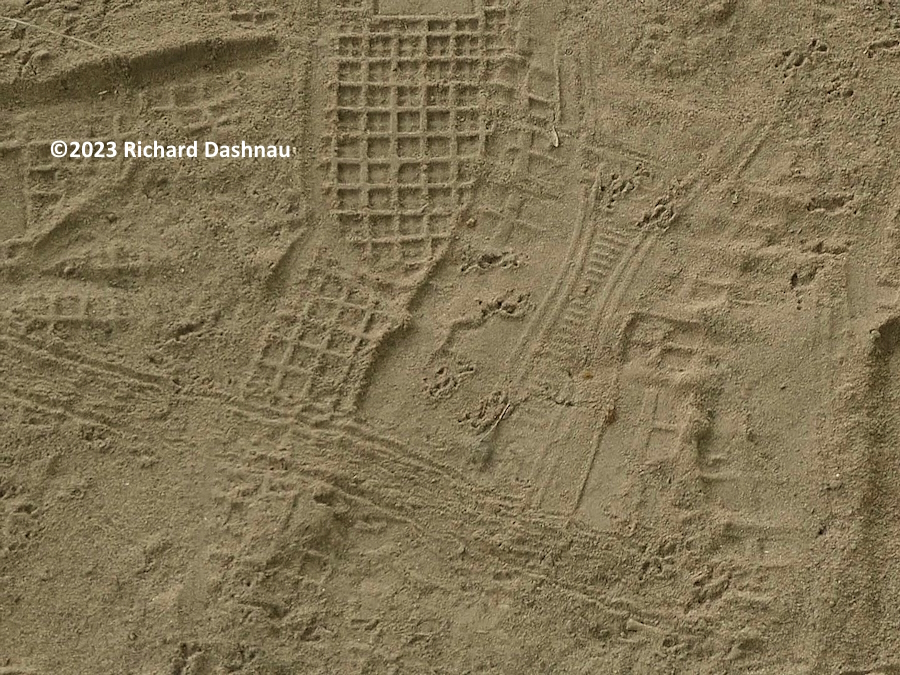
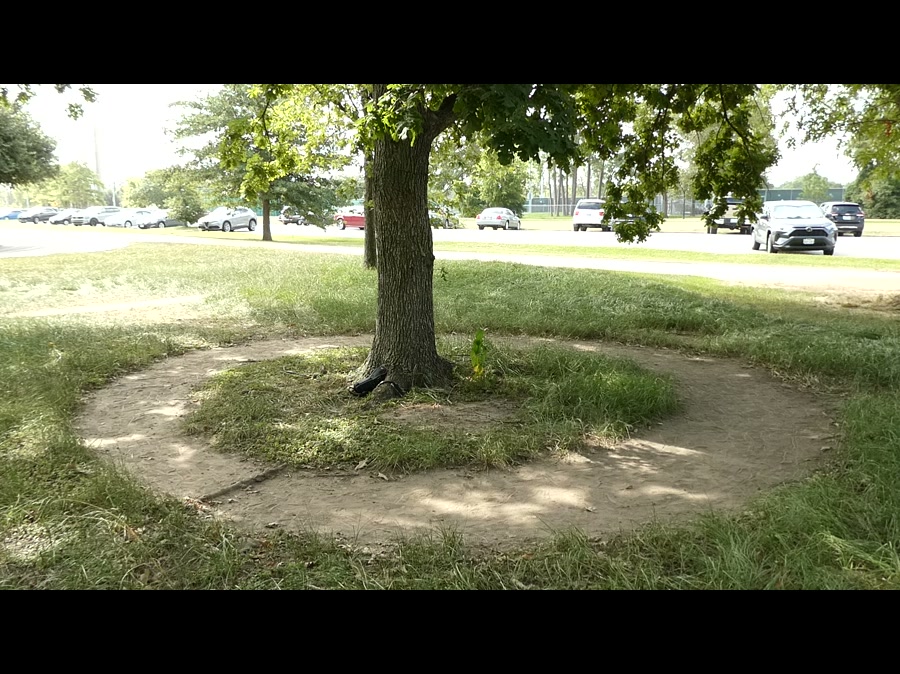
07/27/2023
(added 04\09\2024) I started inspecting my walking path before doing
exercise. I didn't record images every day. It seemed like there was a
lot of new traffic this morning, so I
took took some pictures. The round
holes are from emerged Cicada nymphs. Some of the tracks are probably
from Cicada nymphs. I've shot video of one crossing the dirt before,
and
recogized the wavy line in the center as being from the tip of
the abdomen being dragged through the dirt as the nymph crawled along.
Images and video of the crawling
nymph are
on ichnology page 1.
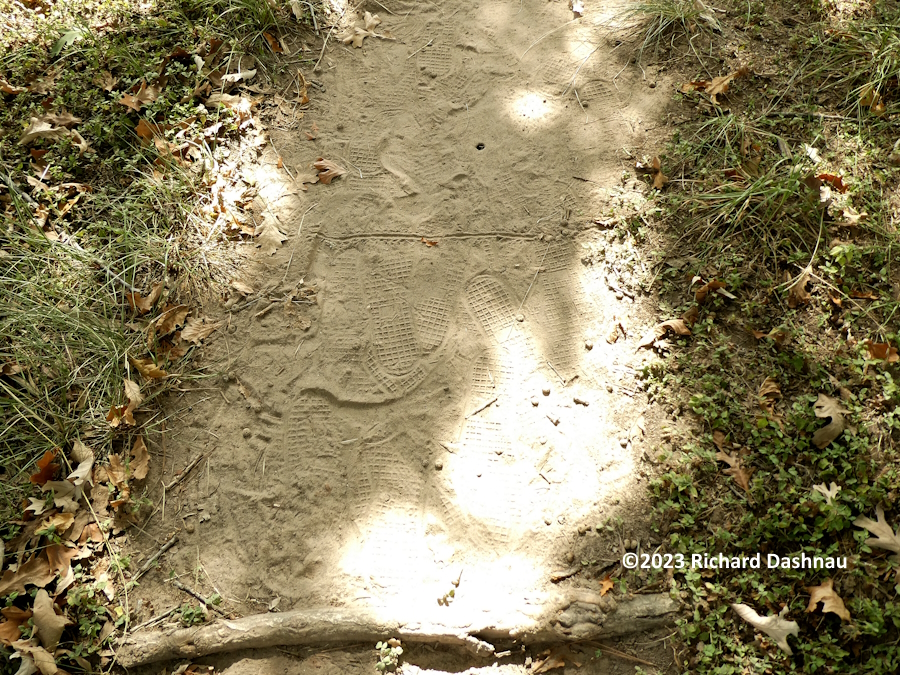
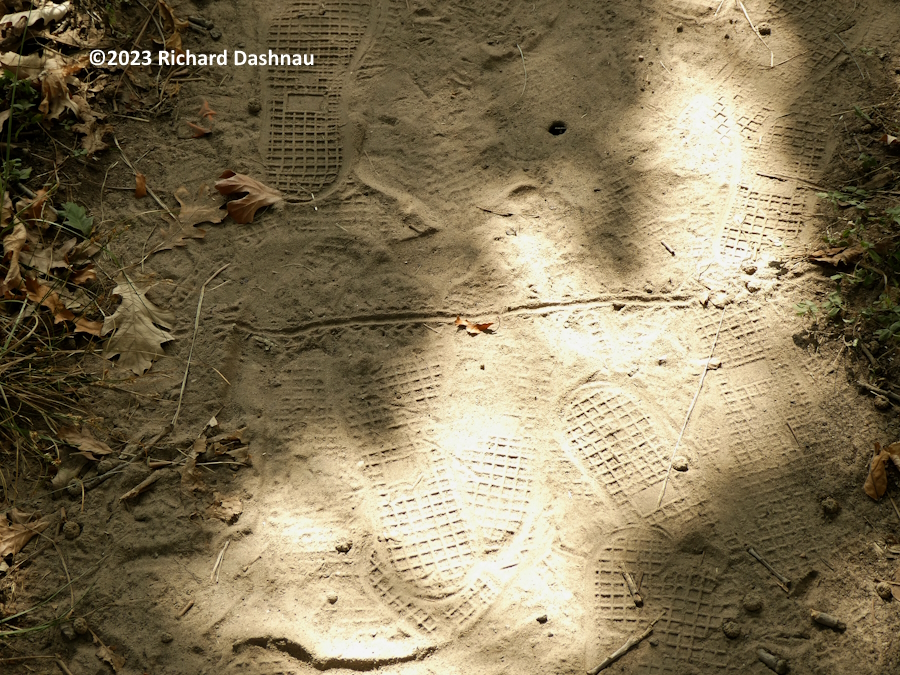
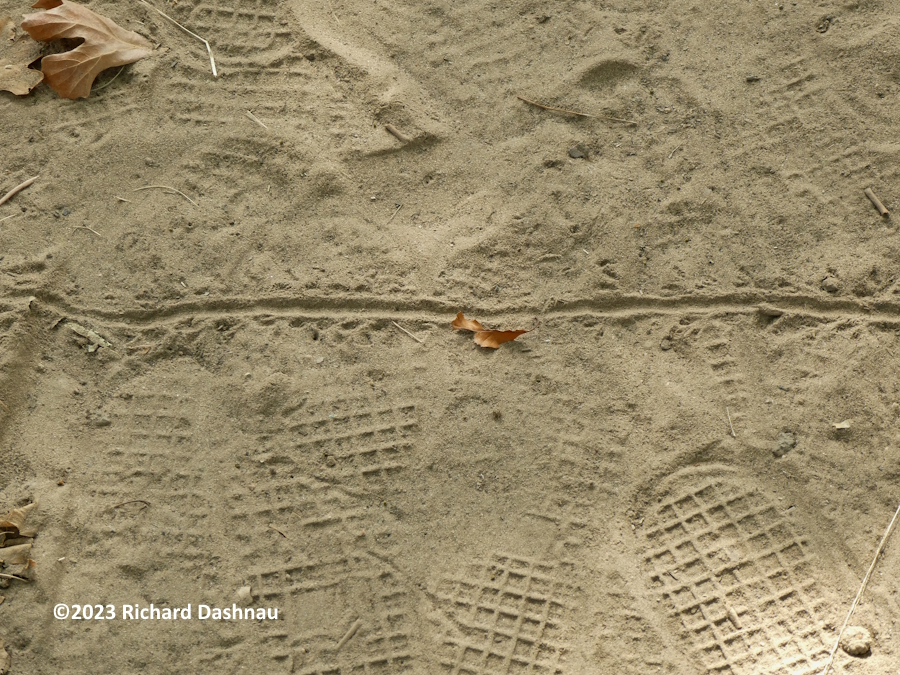
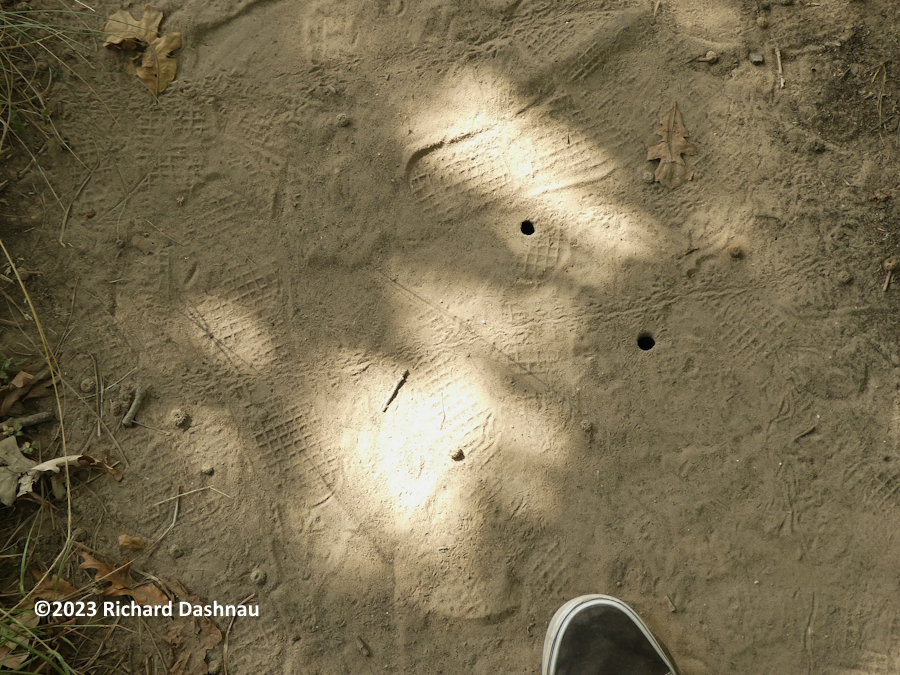
Once
the cicadas start to emerge, it's amazing how many holes appeared
around the path. Close examination shows that these tracks are actually
going over my
own footprints from the
previous
day. I believe that most of this traffic happens overnight. One reason
is that I don't see anything trying to cross my trail while I'm there.
This could be because I'm walking arund and
keeping the critter
under cover. Most of the tracks feature many impressions on each side,
probably indicating more than 4 feet were used. The last image below
right shows a trail that
angles down from the "tractor" style
track at the top. There seems to be no extra impressions along each
side from feet, and it seems like something was dragged to make that
track. The
resolution of the images doesn't help, but I think a
snake would leave a smoother track--and also one that wasn't as
straight. Perhaps an invertebrate like a caterpillar might leave
something
like that. For comparison, each of the square impressions in my
footprints is 7mm on each side. Mysteries!
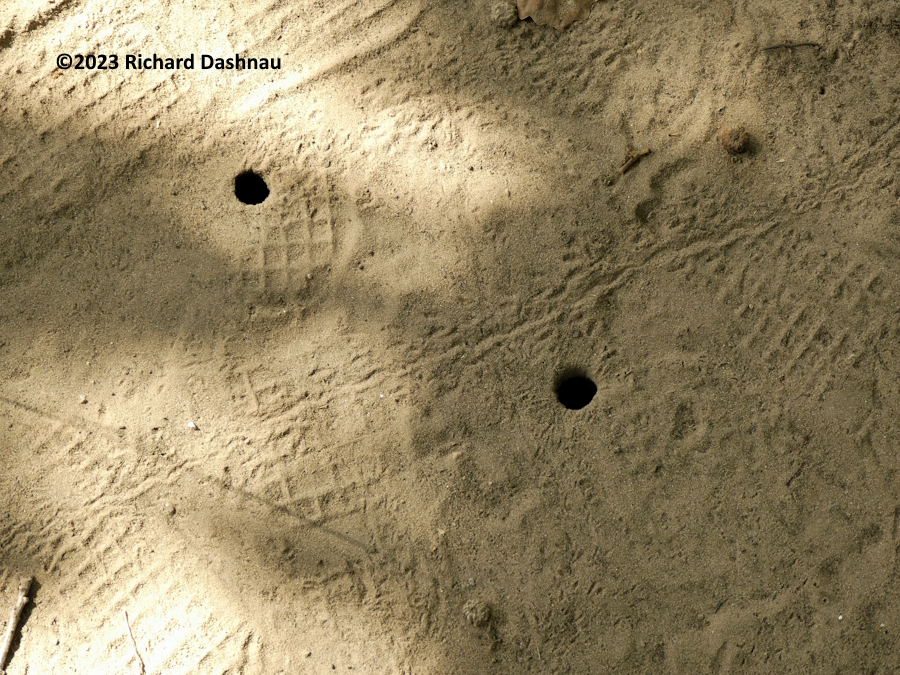
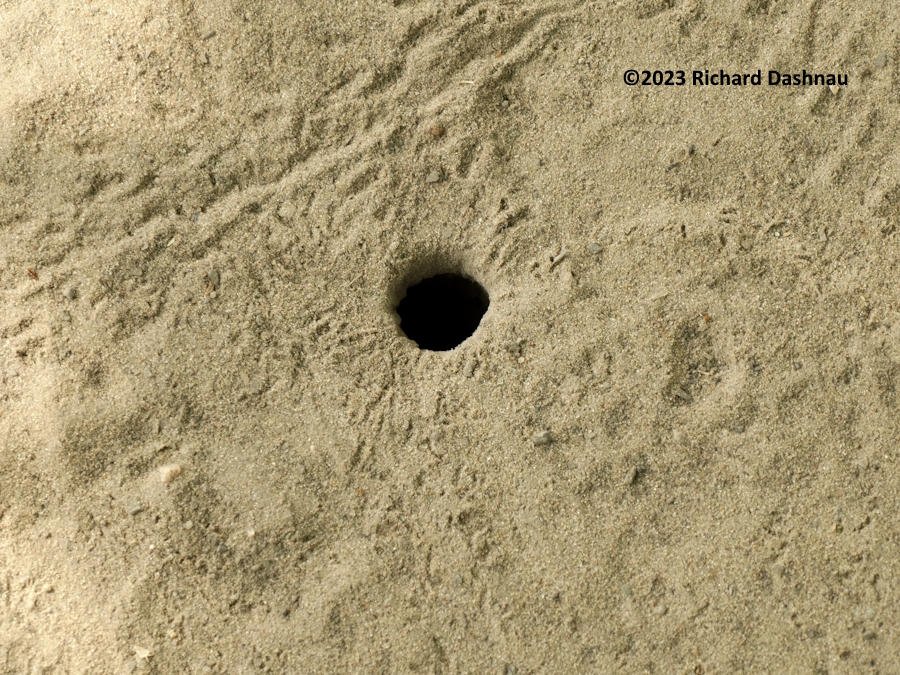
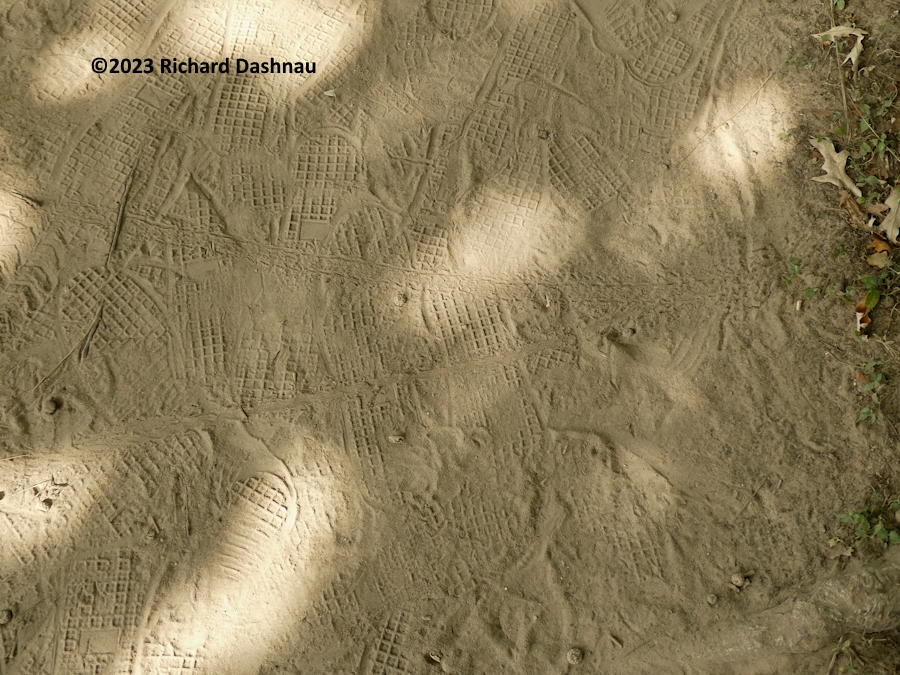
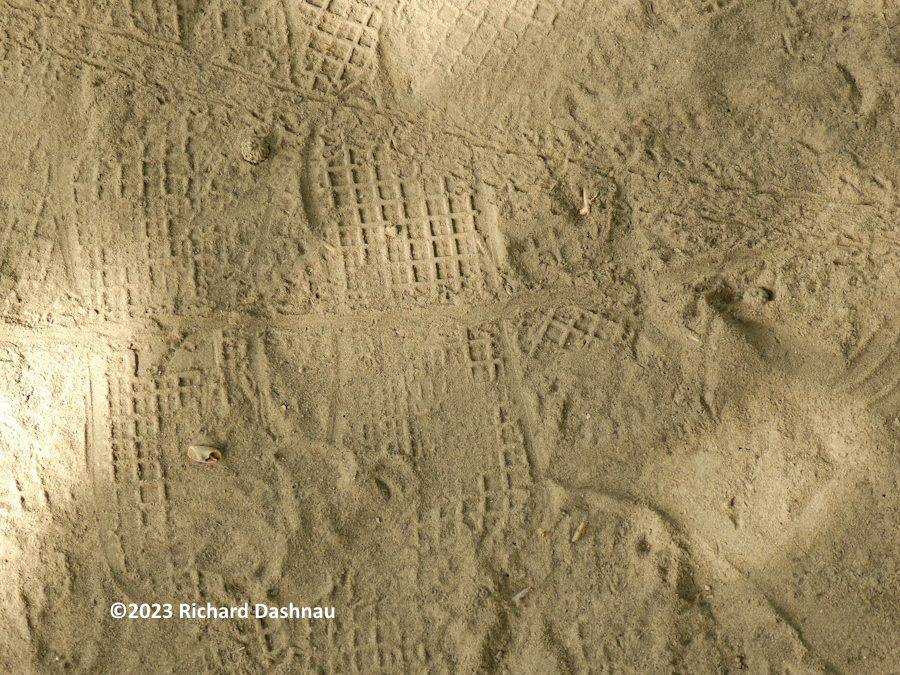
The
last image below right shows something a bit different. When I took the
photo, I had some suspicions about what might have made it. In this
case I thought it might be a snake.
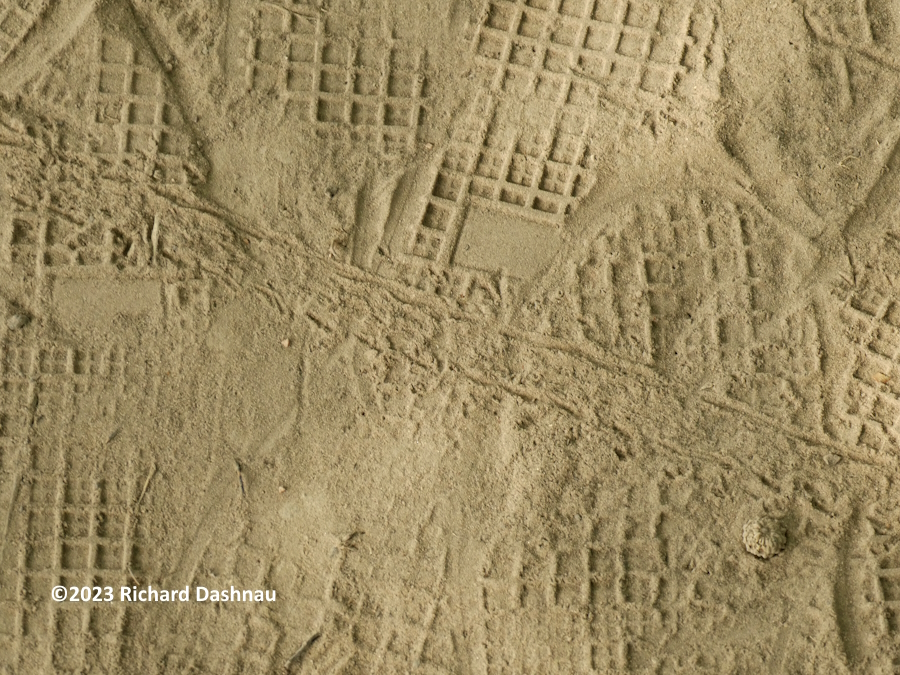
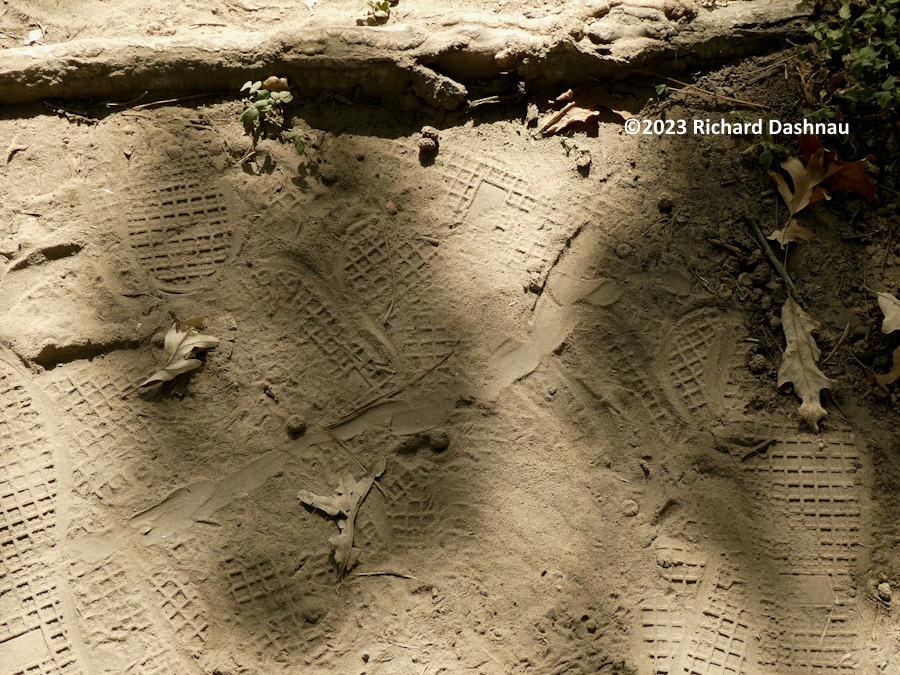
07/28/2023
(added 04\09\2024) When I returned the next day, there were some
different tracks! These wandering tiny grooves were
probably
made by antlion larvae
(aka
"doodlebugs" because these lines resemble random "doodles" drawn in the
dirt.). Along with the grooves scattered through the dirt, there were
small circular pits, which are the traps
made by antlion larvae.
Since I hadn't noticed the trails or the pits the day before,
I
believe that the antlion larvae had hatched recently.


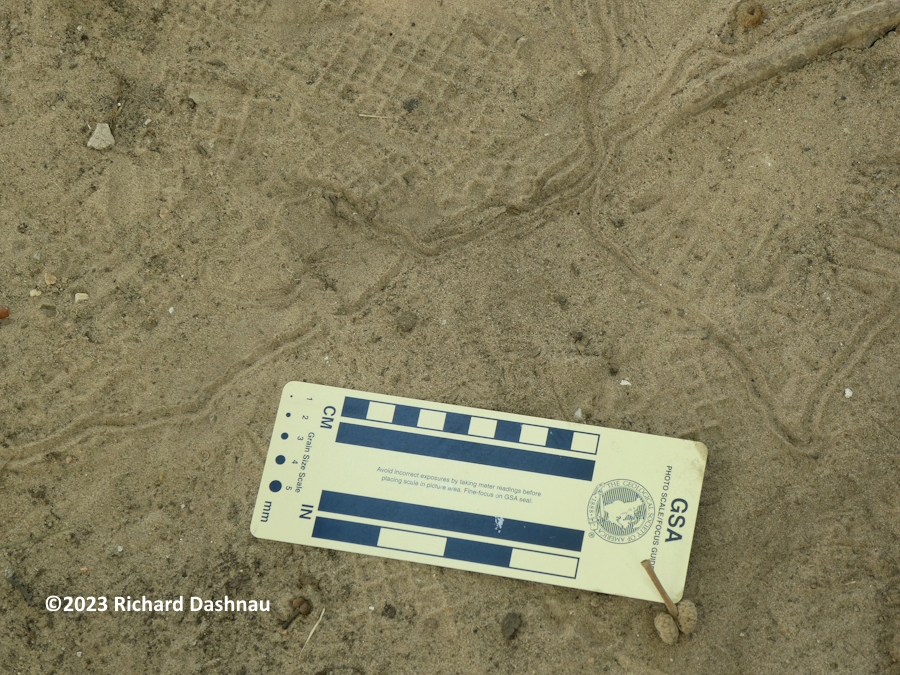
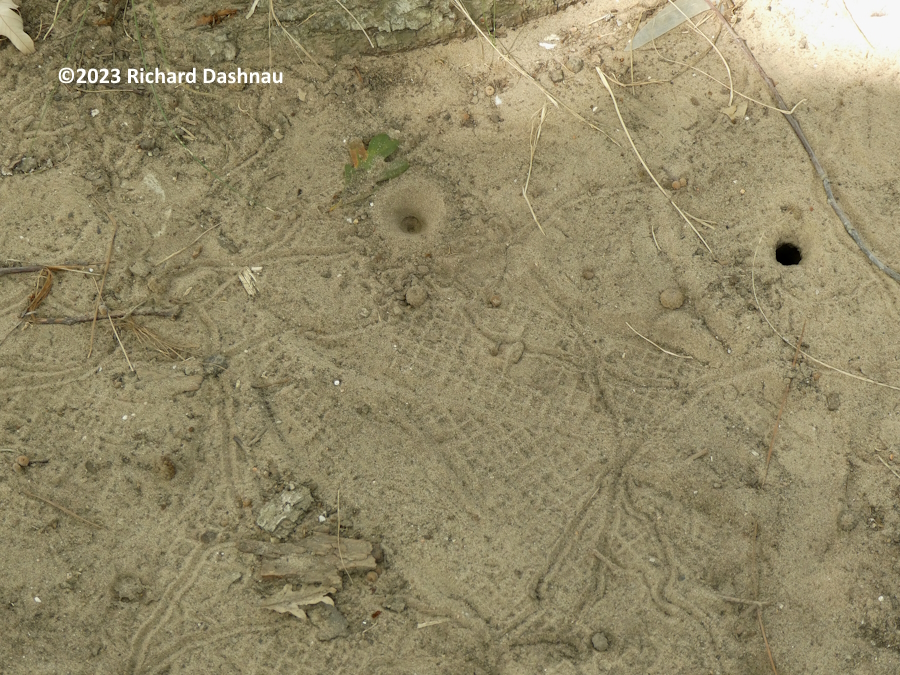
These
tracks were mostly concentrated at the base of a tree that is about 10
feet West of my usual tree. There's a cleared dirt patch around it from
my workouts there, also.The animated gif
shows one of the larvae subduing an
ant that it had trapped by beating it back-and-forth. I have
other
observations of antlions that I made many years ago (2005 - 2011) on this page.
The
amount of traffic around both tree was amazing!
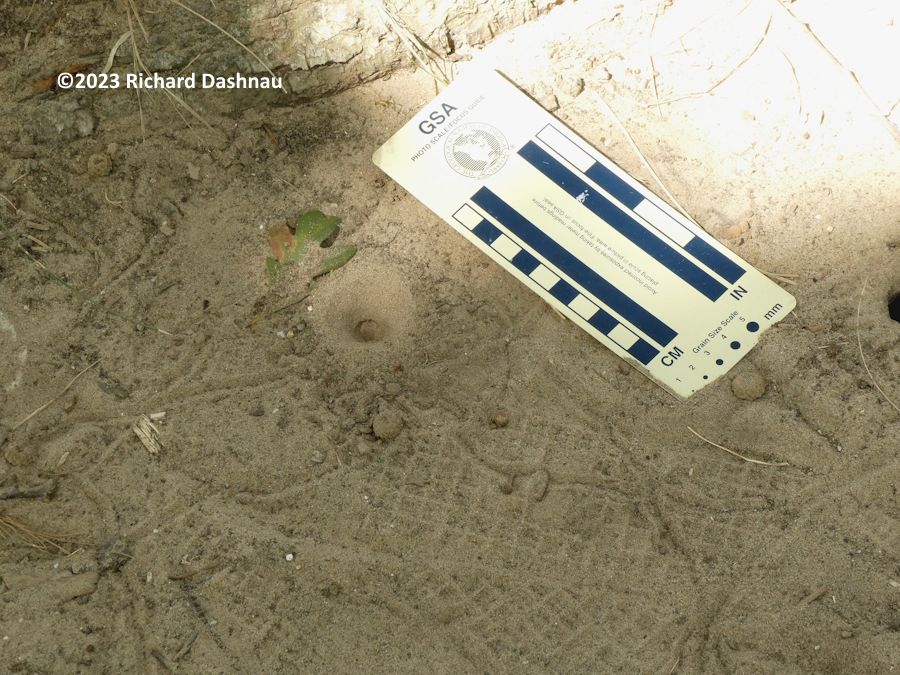
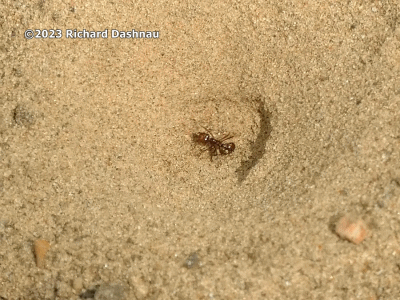
08/01/2023
(added 04\10\2024) This time
in noticed this wide, flat track in the dirt. It crossed the circle in
two places. The first 2 pictures show one crossing mark. The next two
images
show another crossing mark. I don't know the
order that the marks were made, I'm just numbering them to tell them
apart. There are interesting ridges of pushed-up dirt at curves on the
flat
trail marks. I guess that these were made by a snake that
crossed the trail moving in towards the center of the circle, then
crossed the trail again when it moved out of the circle. I looked
for
impressions of snake scales in the fine grains--but couldn't find any.
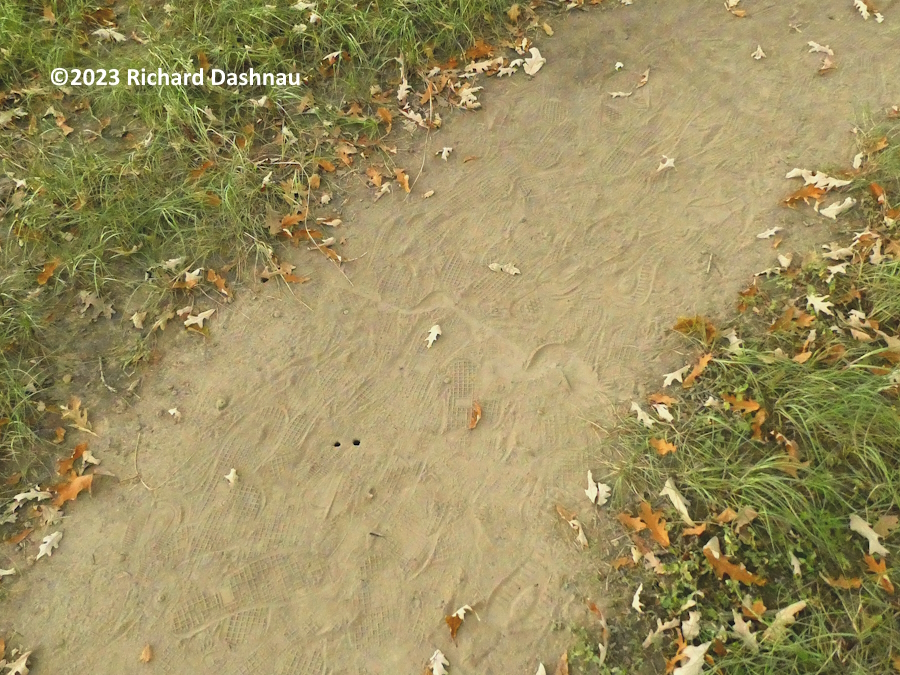
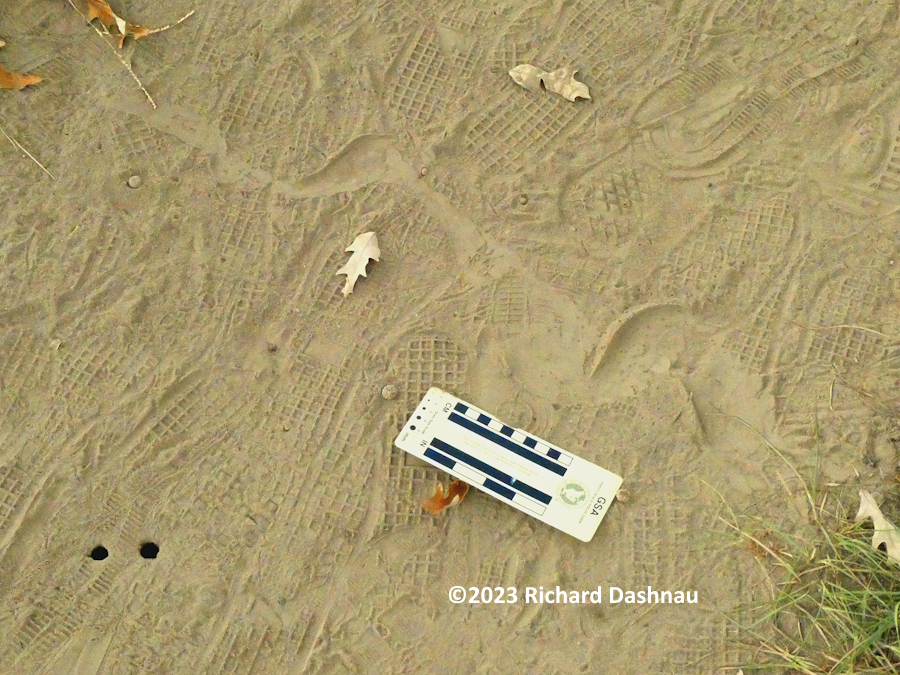
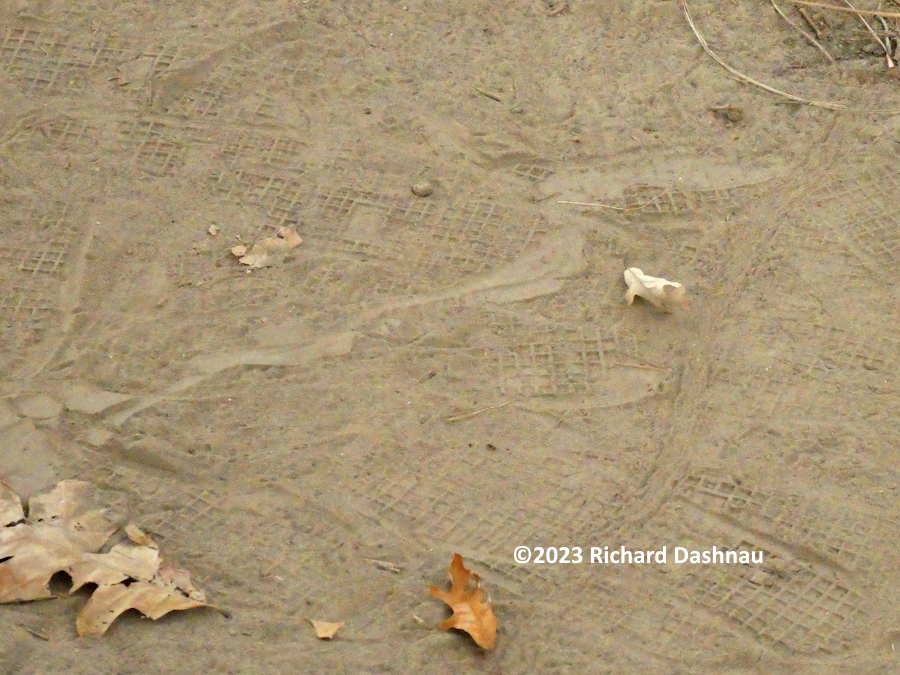
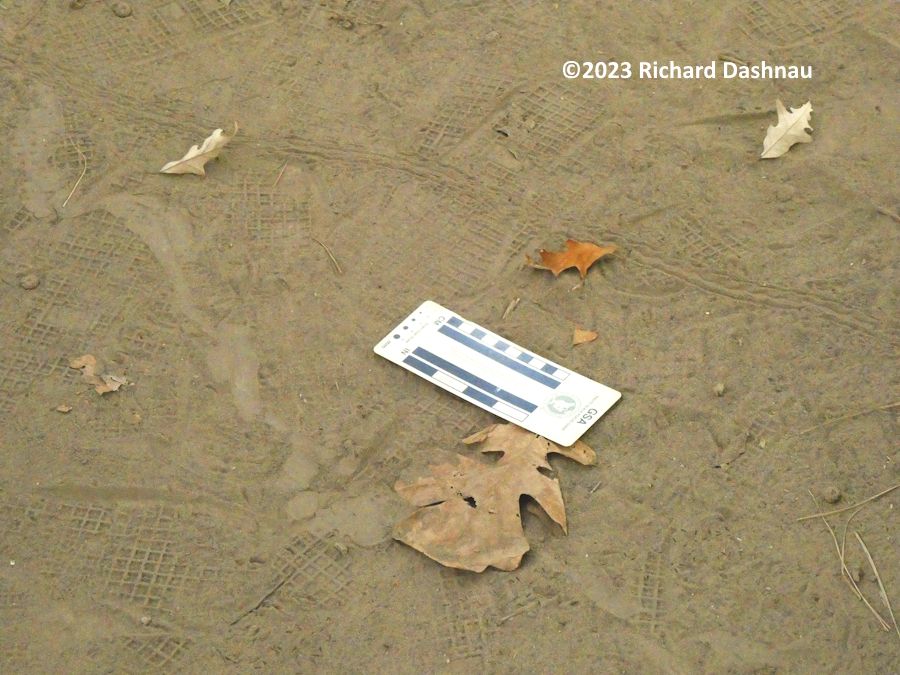
Another
line of footprints intersects the second smooth track near the outer
edge of my dirt circle. That track resembles the cicada nymph tracks
I've seen before. I know that Copperheads eat
cicadas, when the Cicada nymphs are emerging and becoming adults. But
in this case, the insect tracks were walking over the
smooth tracks. The 3rd image below shows a third track-which
I
had missed during my first inspection. This one also has a
line of
tracks next to it; along with a couple of Cicada emergence holes. While
I did my workout, I wondered if a Copperhead
might still
be around. With two tracks, I could assume that a snake might have just
crossed my circle in two places and left. But with 3...maybe the snake
had come back and was hiding on
the tree or in the grass around the base. Whatever made the track
didn't appear.
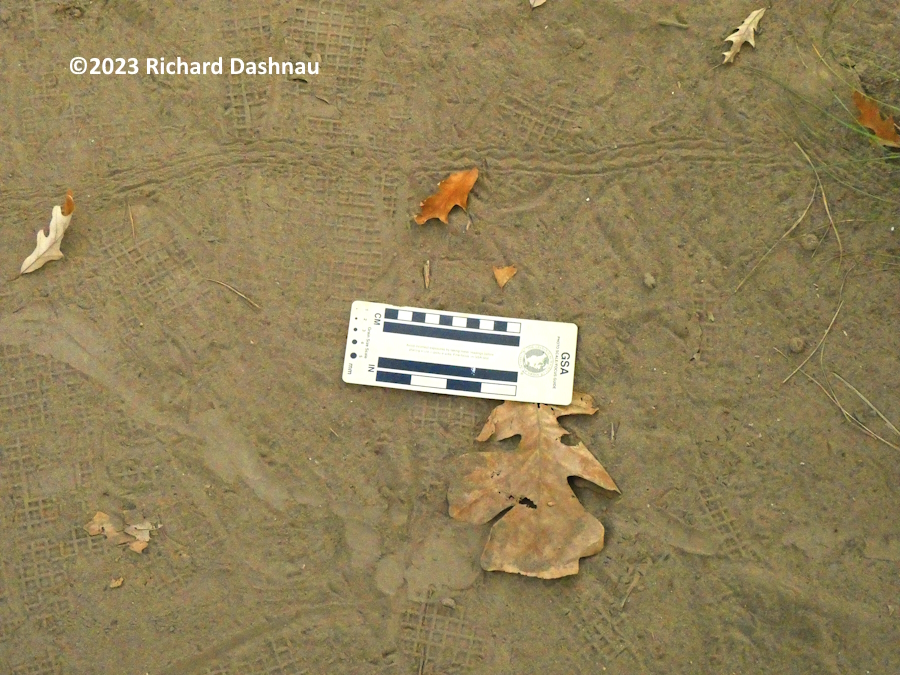
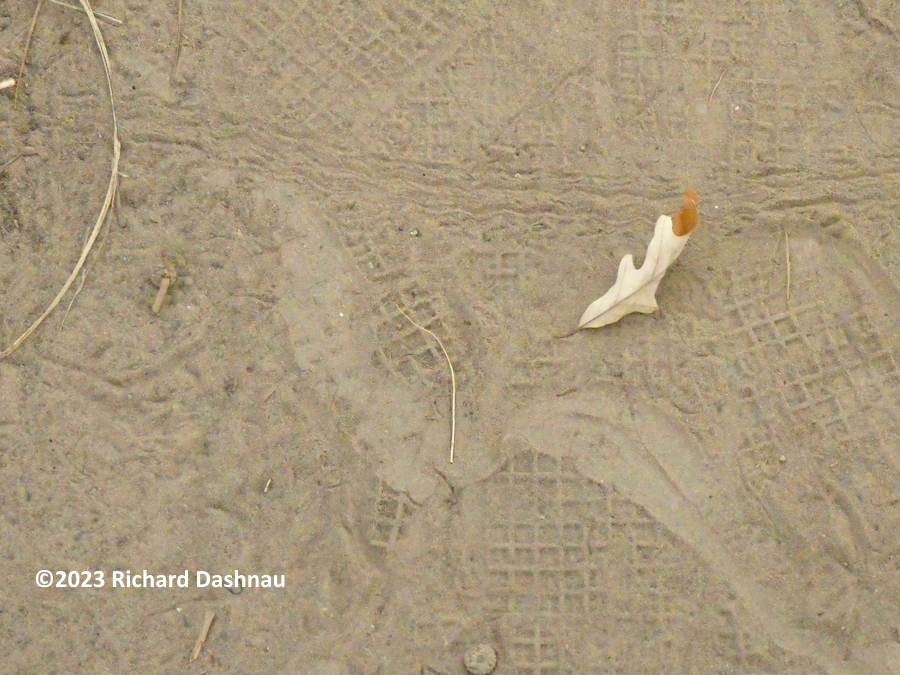
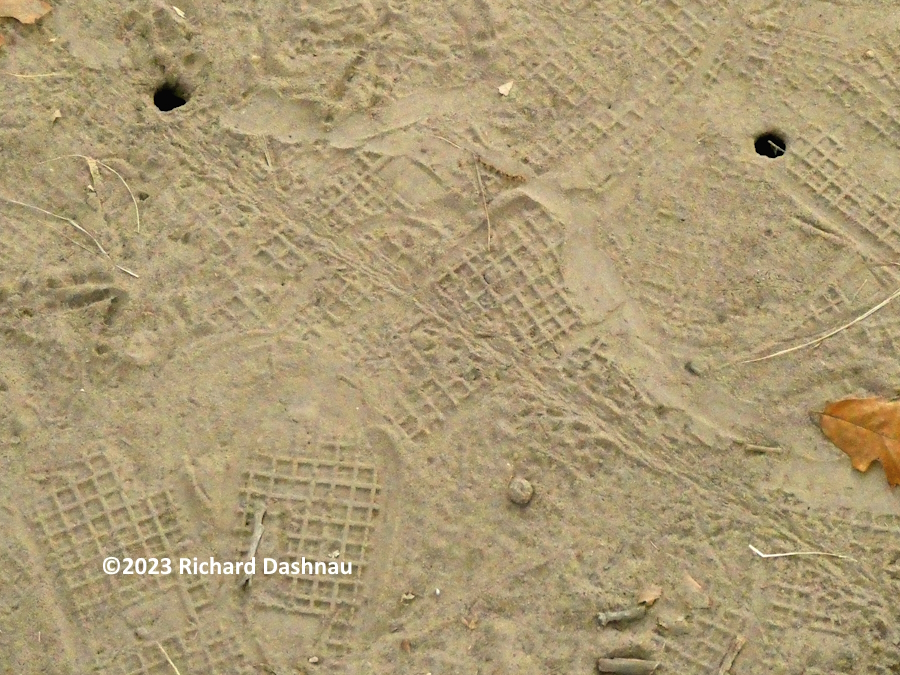
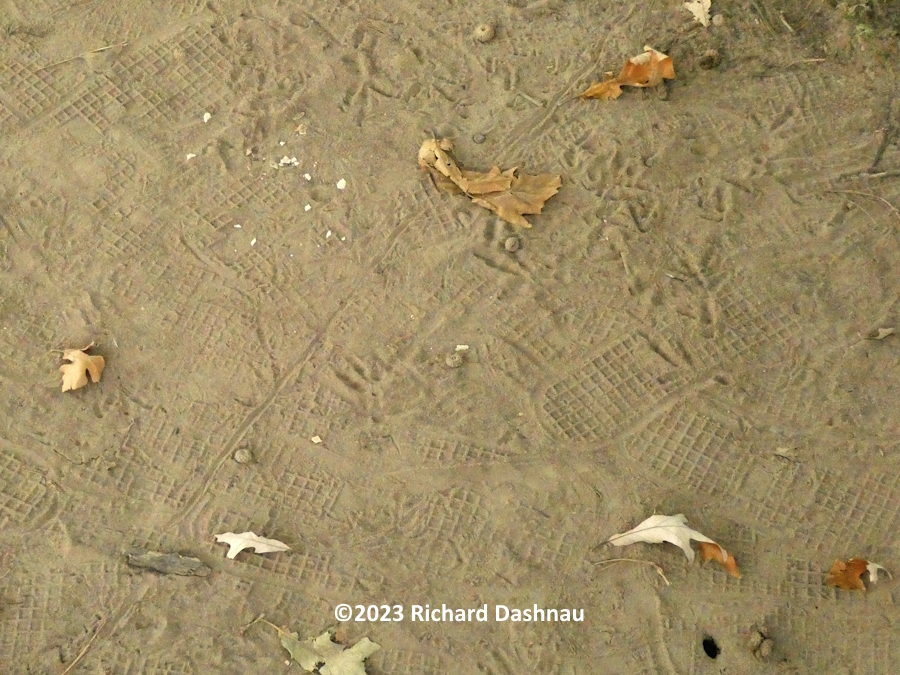
There
was another groove marked into the dirt. It was relatively straight,
but I didn't notice any footprints on either side of it (if a lizard
had made it by walking and dragging tail). Perhaps a
smaller
snake(like an Dekay's or Earth snake)? I'm including it because it
stood out. And then, there are some bird tracks--probably from Grackles
which often forage there.
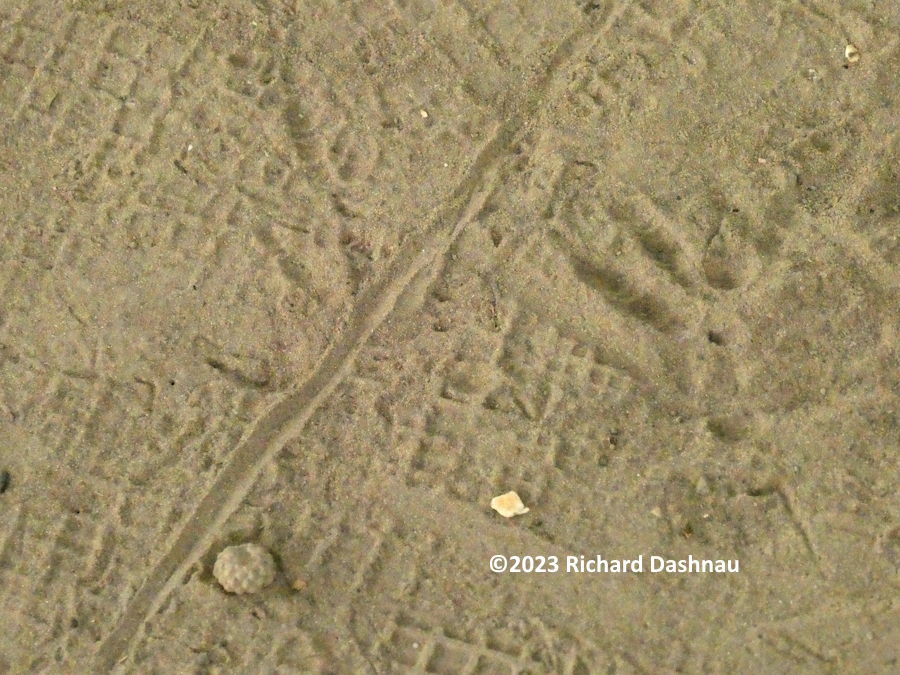
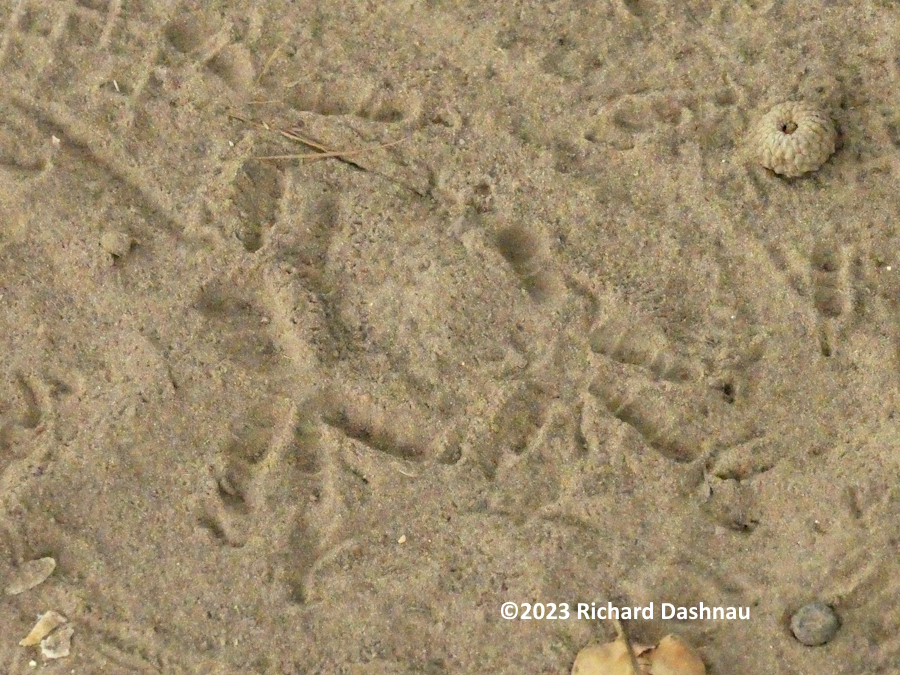
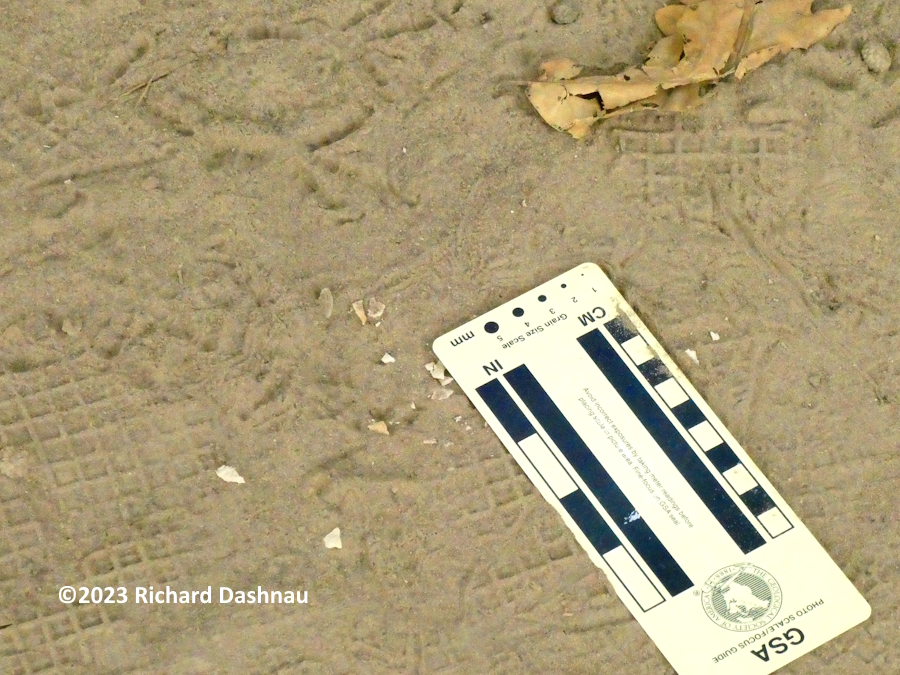
08/03/2023 (added 4/18/2024)
This Cicada nymph
crawled up the tree in the center of my circle. This nymph
(and most others here) climbed at least 8 feet up in the tree before
their final molt
into adults. I continued my exercises. But about 40
minutes later I picked up my camera for more drama.
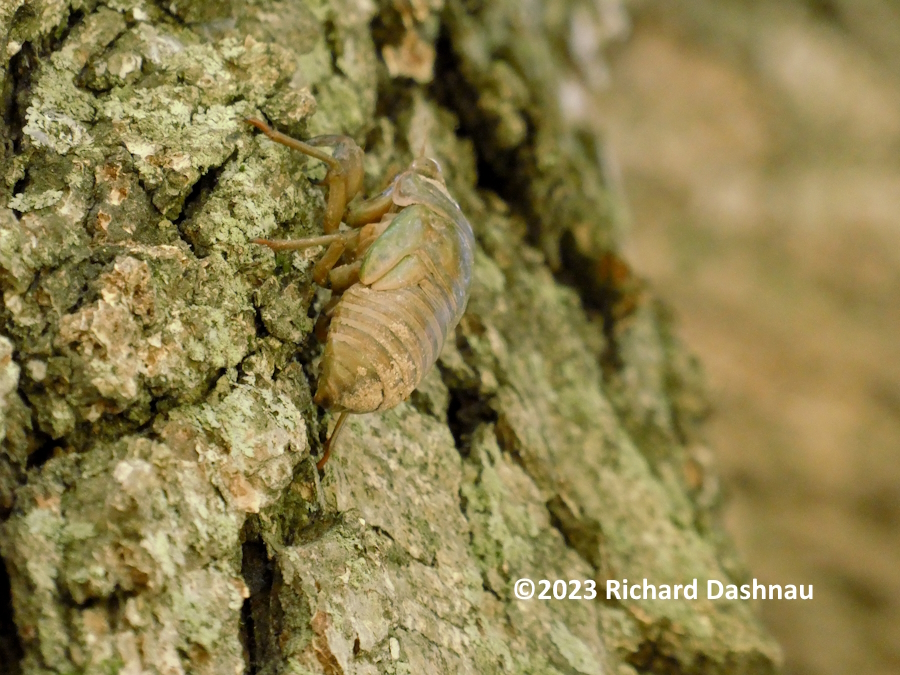
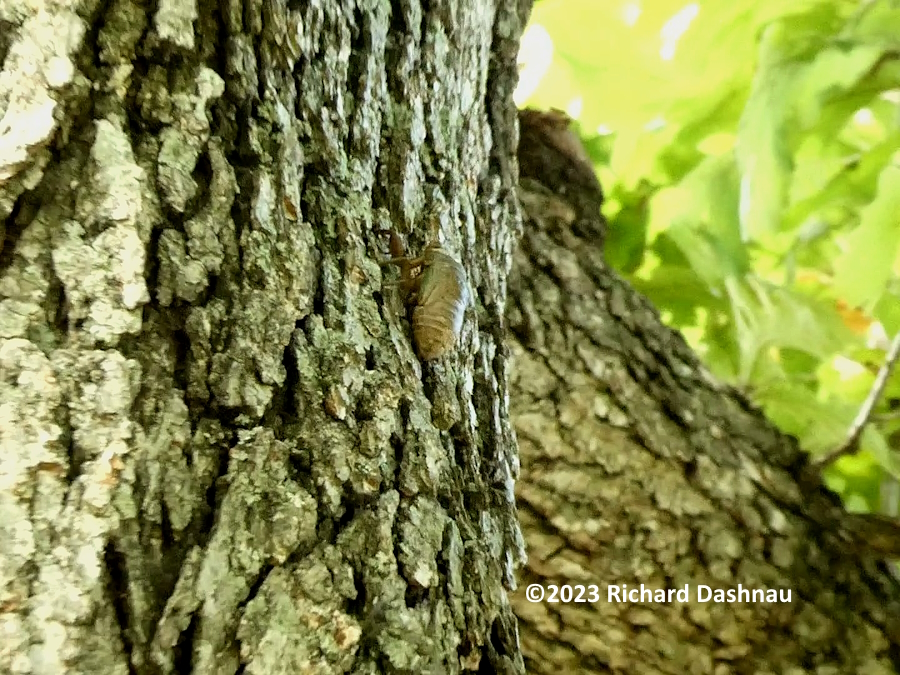
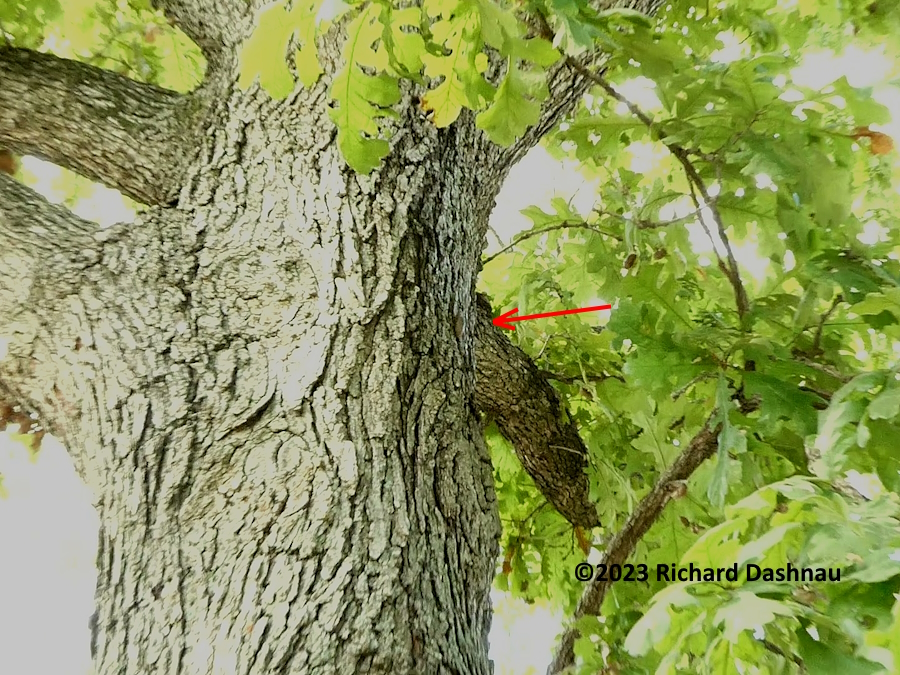
A
Cicada Killer had captured an adult Cicada, and was preparing it for
transport back to its nest! I'd never seen this event before, and
captured
what I could as it happened
about 8 feet above me. I lost sight of it
among the leaves. The stinger is stored inside the tip of the abdomen,
and extended when the female wasp uses it. The tip
of the
stinger
touched the Cicada many times, possibly probing for insertion points to
inject venom.
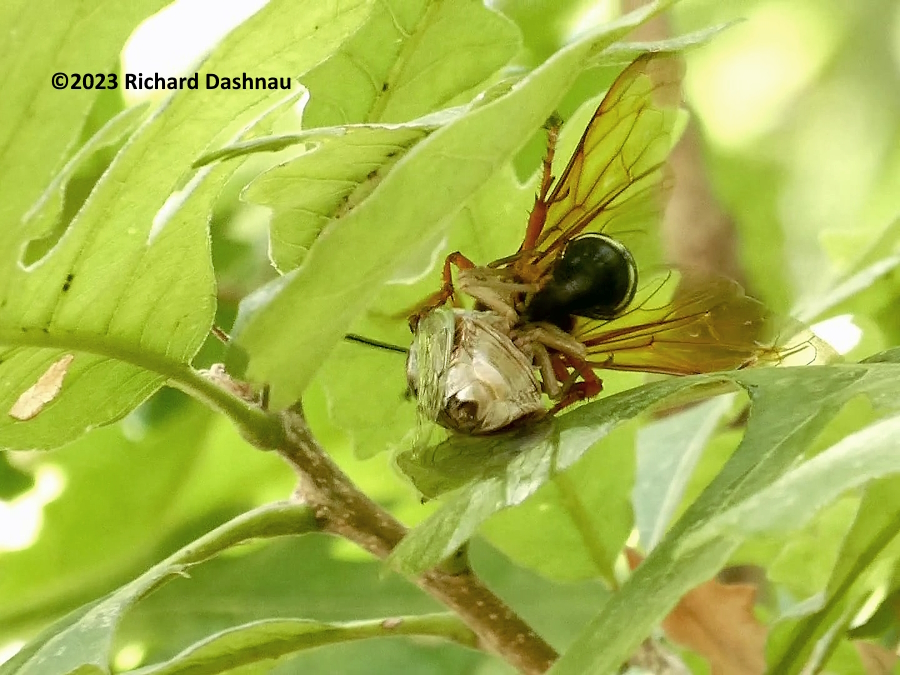
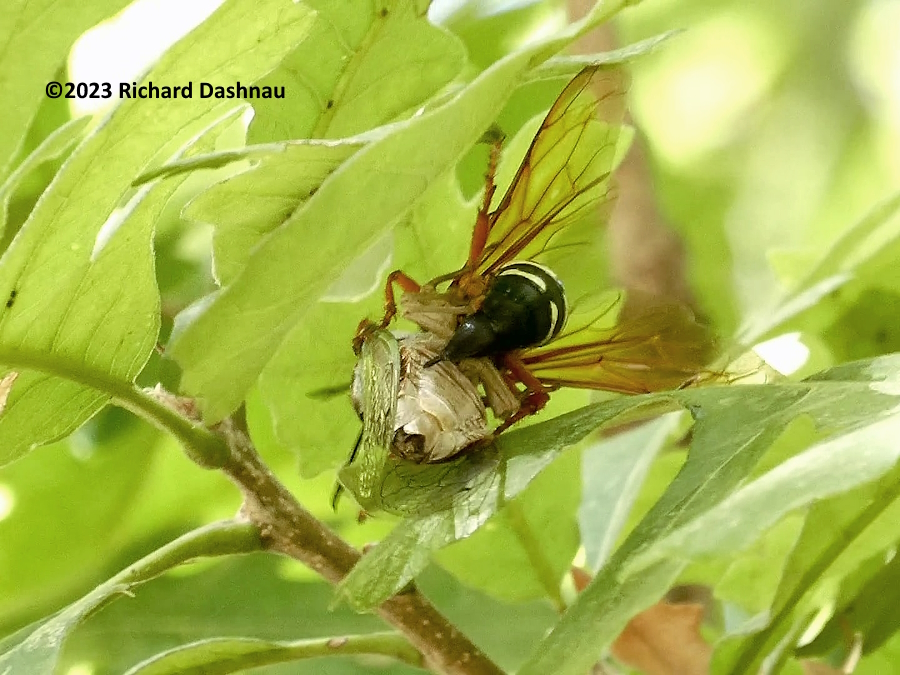
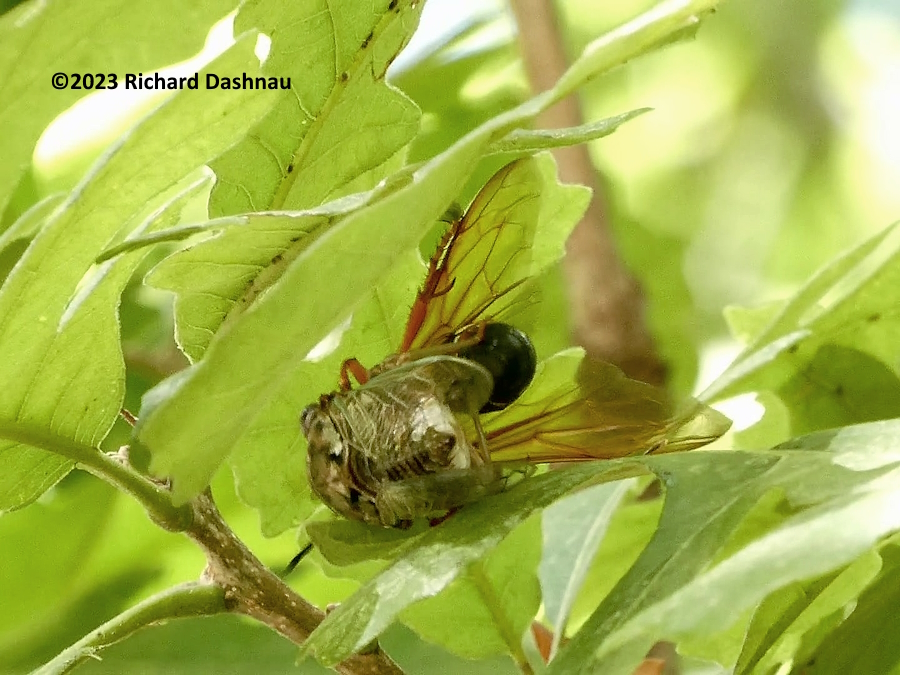
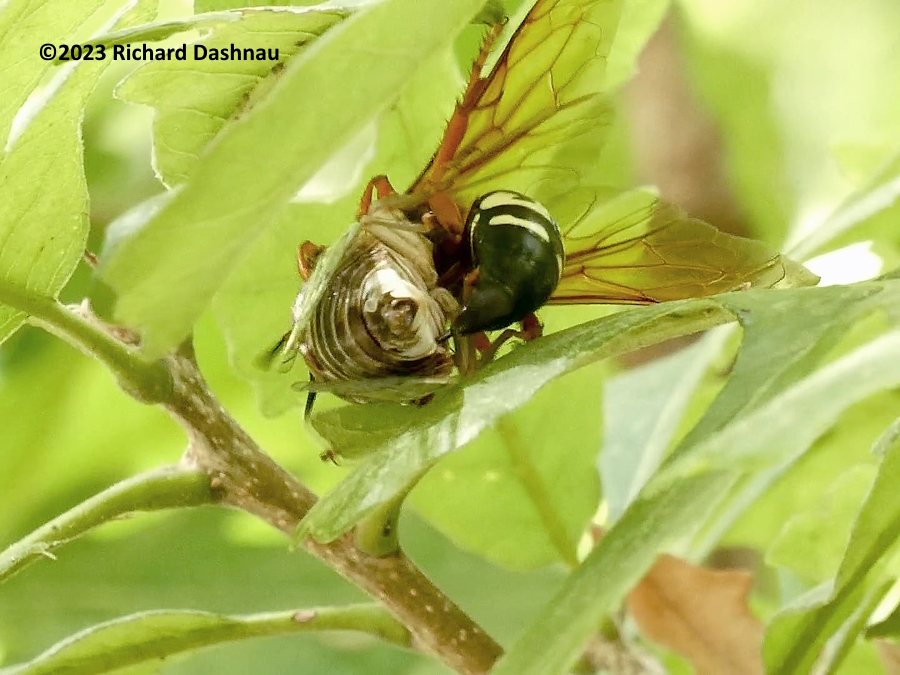
We
can see two large spurs on the rear leg. The spurs help females dig
more efficiently. Males have smaller spurs (they don't dig), and they
don't have working stingers,
but show false barbs (that don't
retract) at the end of their abdomen. More probing, and/or injection;
done to paralyze the Cicada for storage. Reminds me of a dentist
applying Novacaine. The needle is used in more than one spot. Video edited from these
events can be seen here.
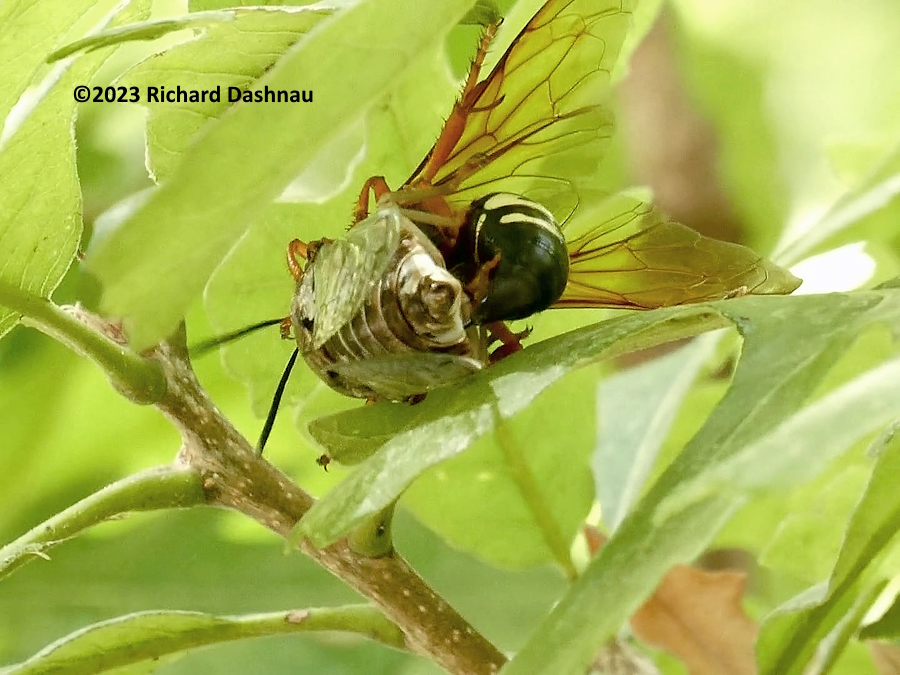
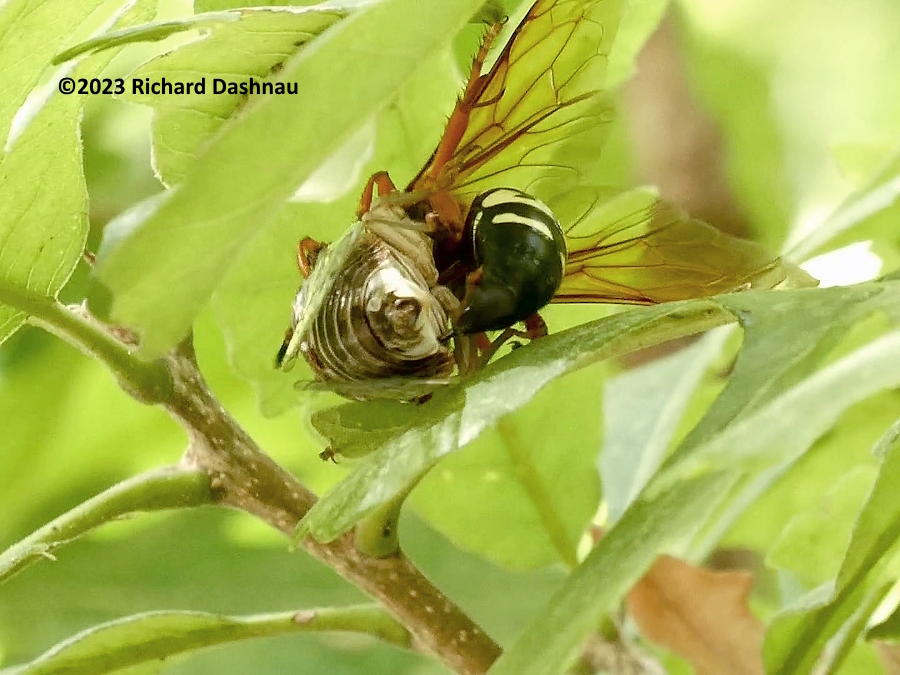
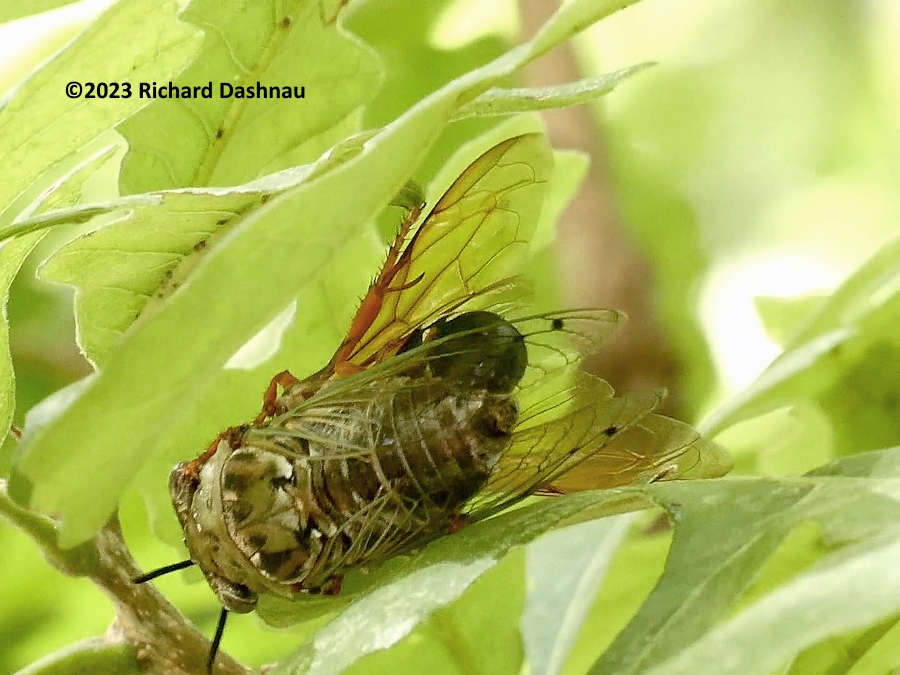
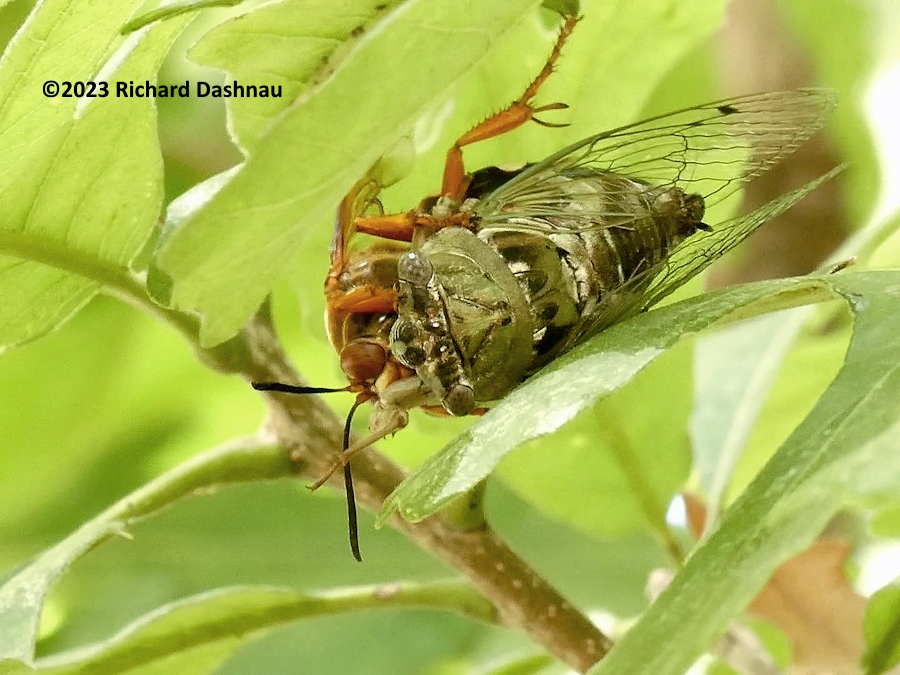
08/04/2023 (added 4/25/2024)
More new tracks from the
night before. The Sun was covered
intermittantly, making it challenging to capture the tracks in the
dirt. Not enough light doesn't give
enough contrast to show them
well, and too much light washes them out of the image. Image 2 shows
the arthropod tracks, along with some 3-toed bird tracks, and possibly,
the "3-toed" tracks
of something else, along with a Cicada emergent
hole. Image 3 shows the effect of sunlight, and how it really helps
with contrast. These are 2 more tracks. The tracks are from some pretty
large
insects-which I think are mostly Cicada nymphs. Another bird
track is at the top. Note the lack of a 4th toe impression. That helps
define the type of bird that made the track. Image 4 is a closer
view
of image 3. Tiny hole impressions in front of the bird track
(on
the arthropod track) might be impressions from the bird poking with its
beak. Image 5 is the same spot from another angle.


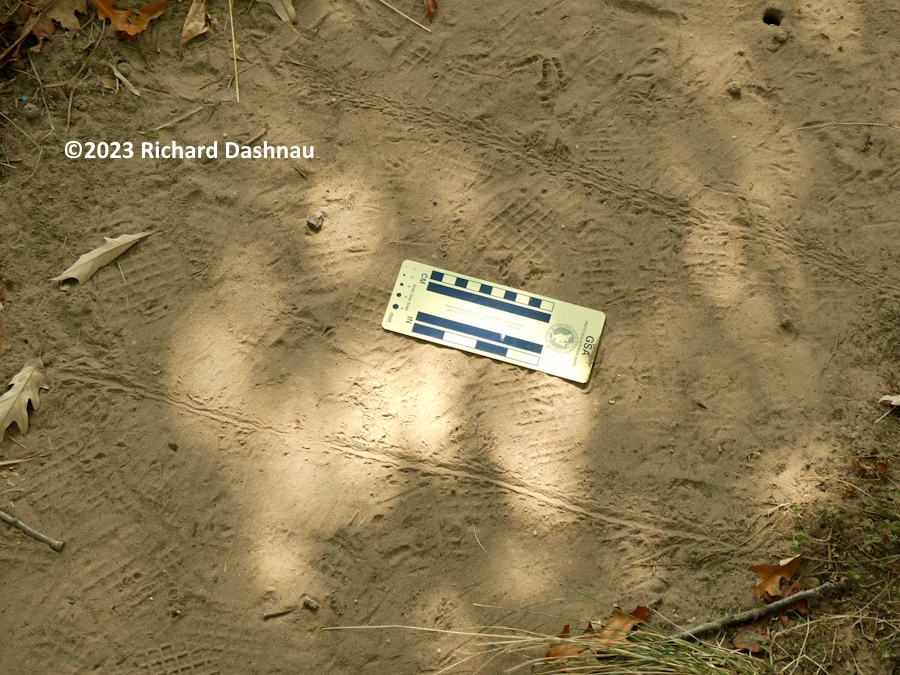
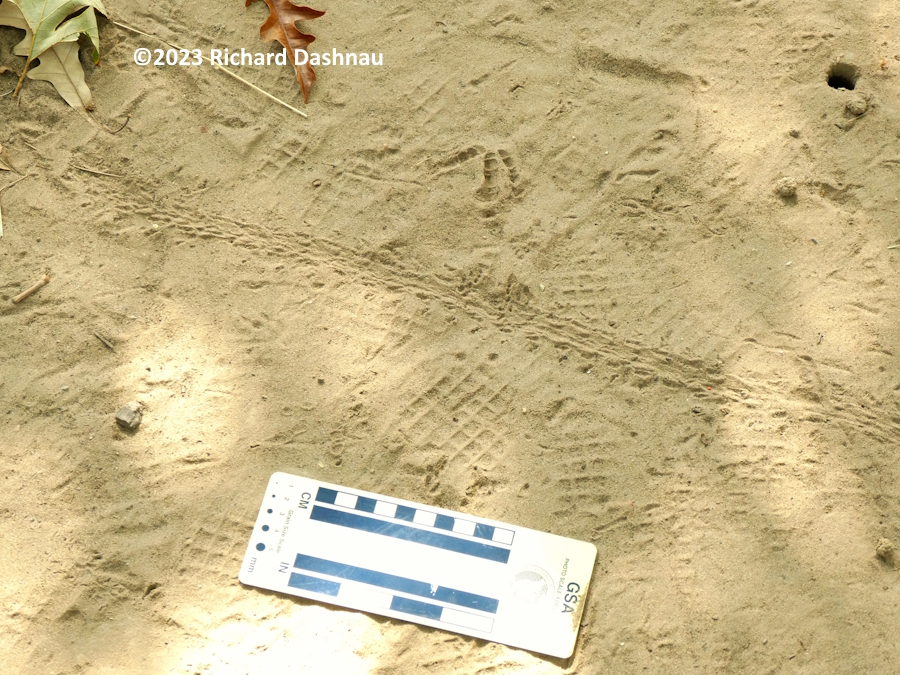
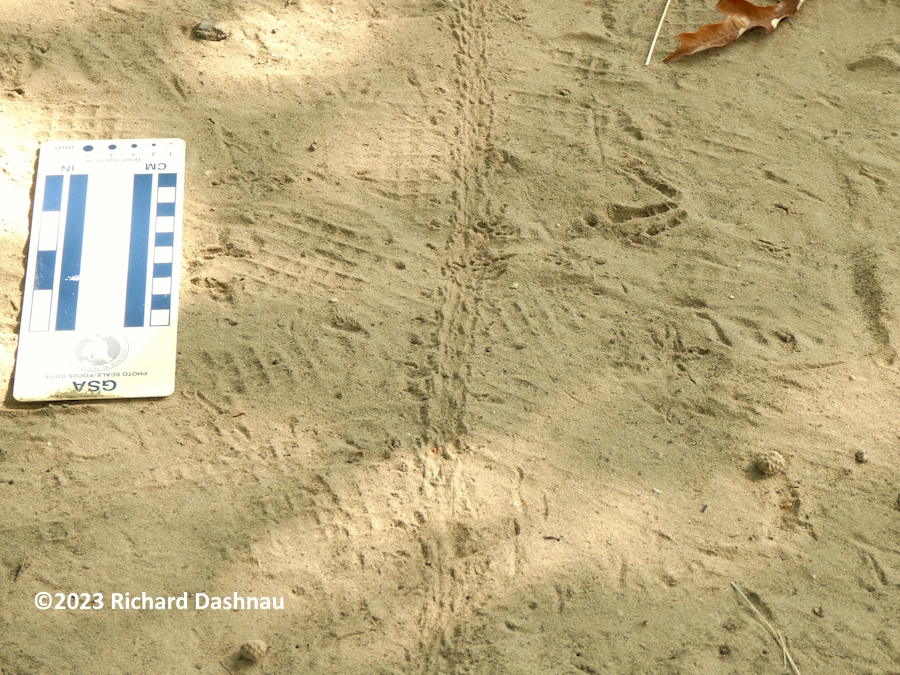
Image
6 (below left) is closeup of another track, showing the a prominent
"trench" in the center of some tracks. The one time I saw a nymph
crawling in the dirt, the trench was made by the tip of
its abdomen
dragging as it walked. Image 7 shows some very small impressions from 2
or 3 toes or claws. But they didn't seem to lead anywhere. I can think
of a large insect that might leave
such tracks--and then fly off: A Cicada Killer Wasp (Sphecius speciosus)!
But that's just a guess. Images 8,9, 10 show a different type
of
track. It's hard to tell, but I see 3 "toe" marks on some,
possible
4 on others. At maybe an inch or so across, they're large. Too big for
a squirrel (not enough toes, too.) I think that an armadillo came
through here!
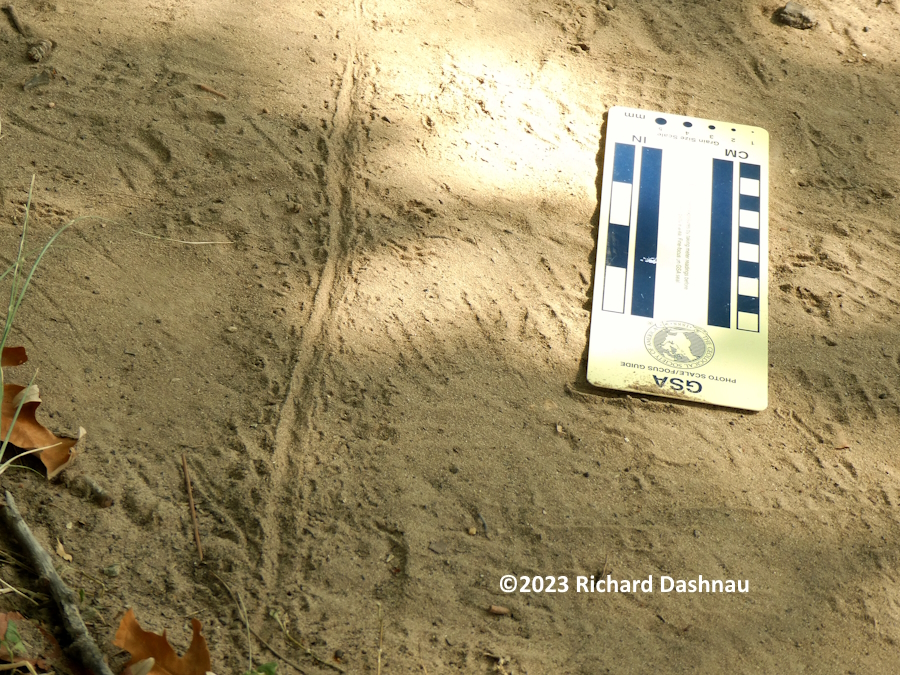
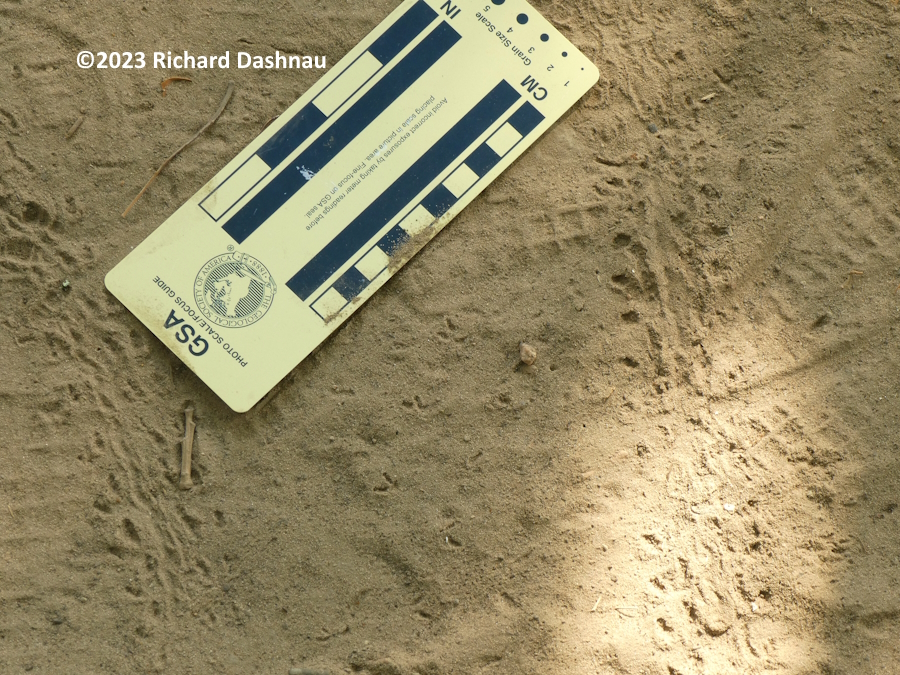
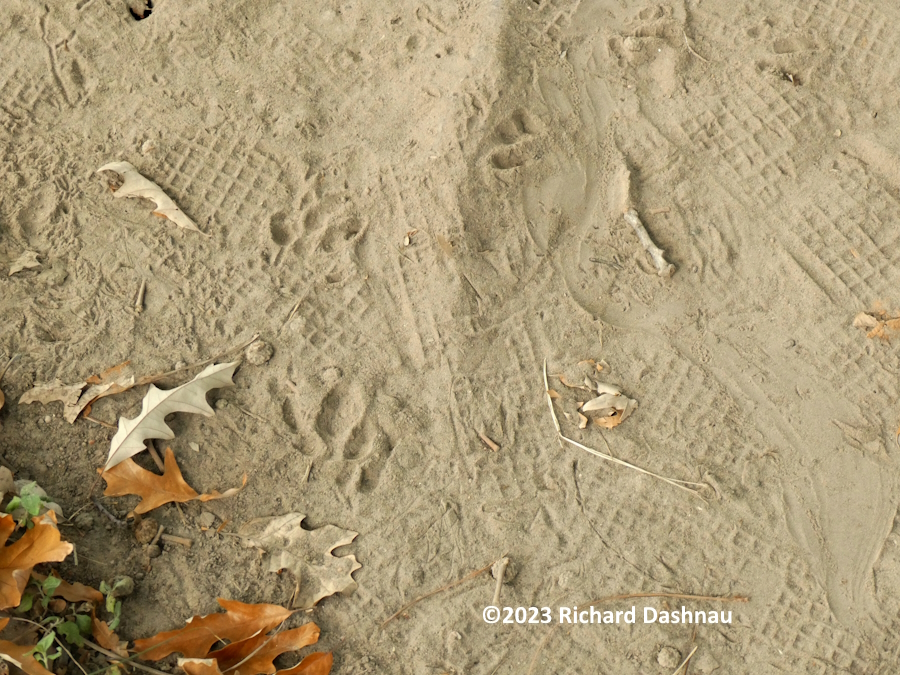
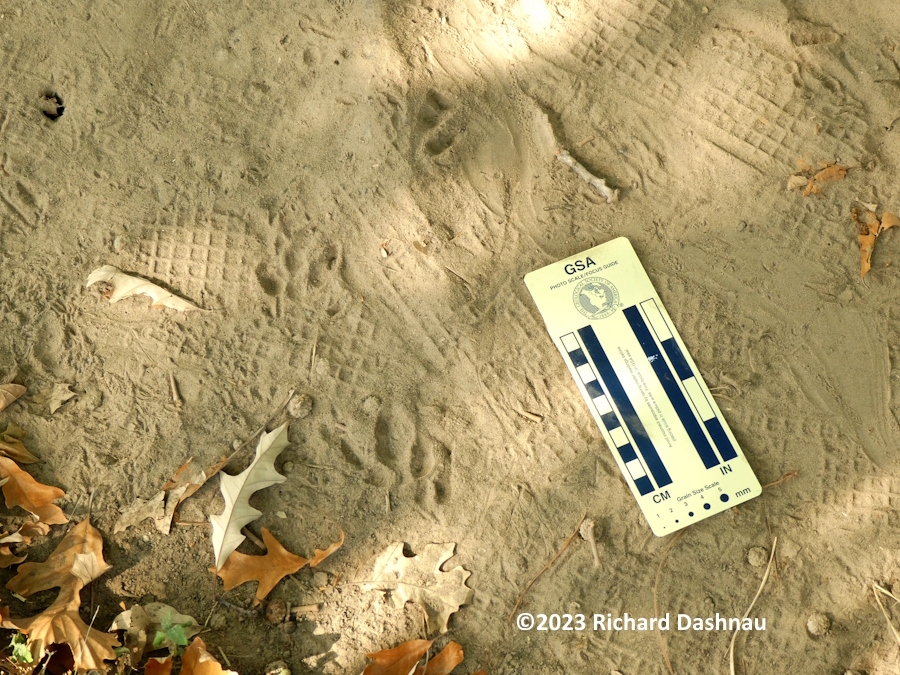
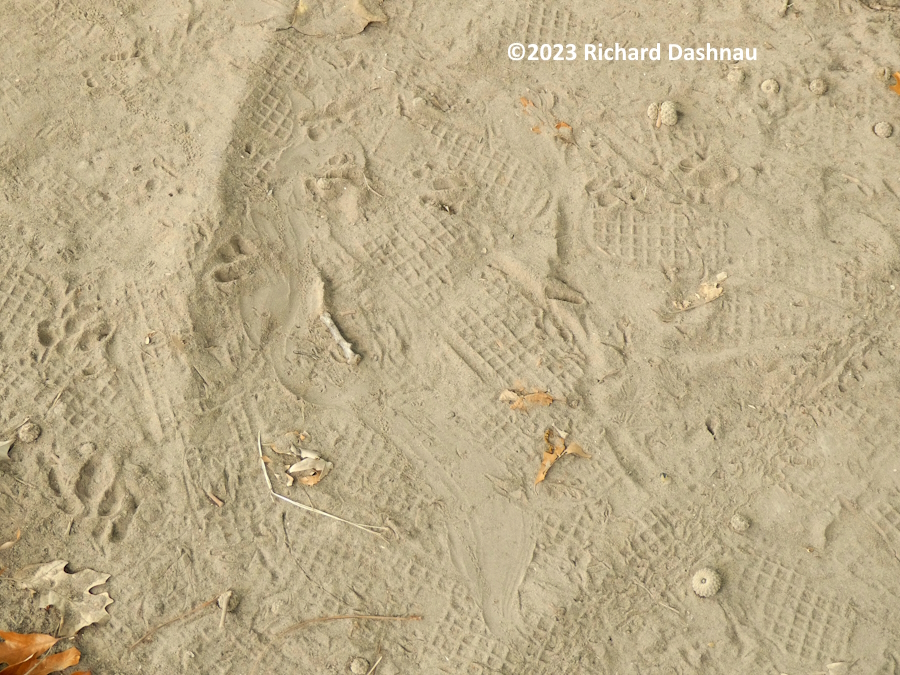
08/08/2023
(added 04\25\2024) Today, lots of bird tracks were on my trail. Just
about all the observations on this trail over the weeks were made
between 9am and 11am. Something
attracted
the birds that walked here. As in most of the images here, most of the
human footprints seem to be mine from the day (or days) before.
Pictures 3 and 4 below show an additional
"scratch" mark in the dirt. It only appeared one area, and was not
continuous.

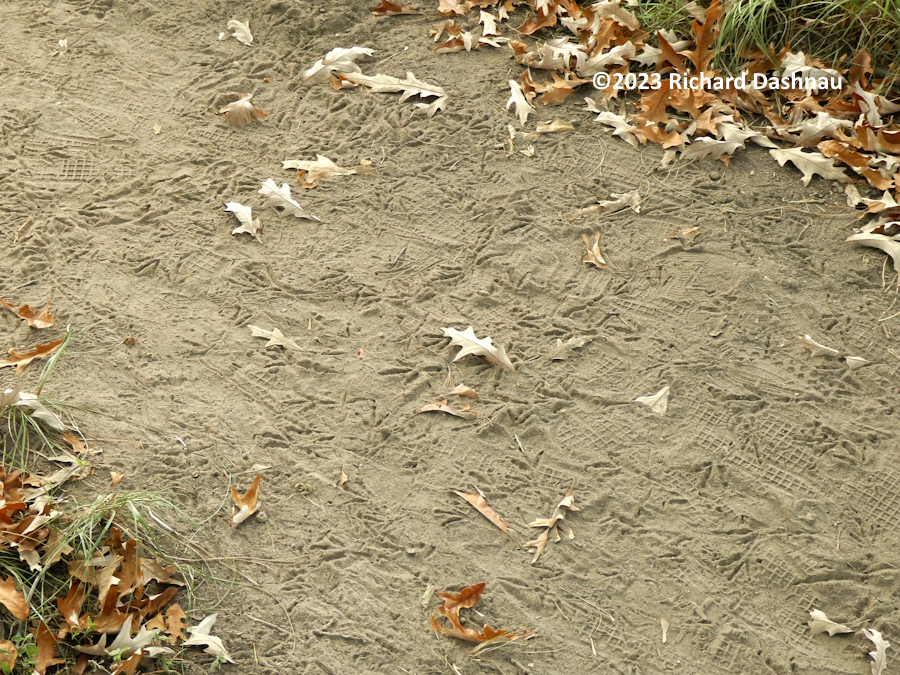
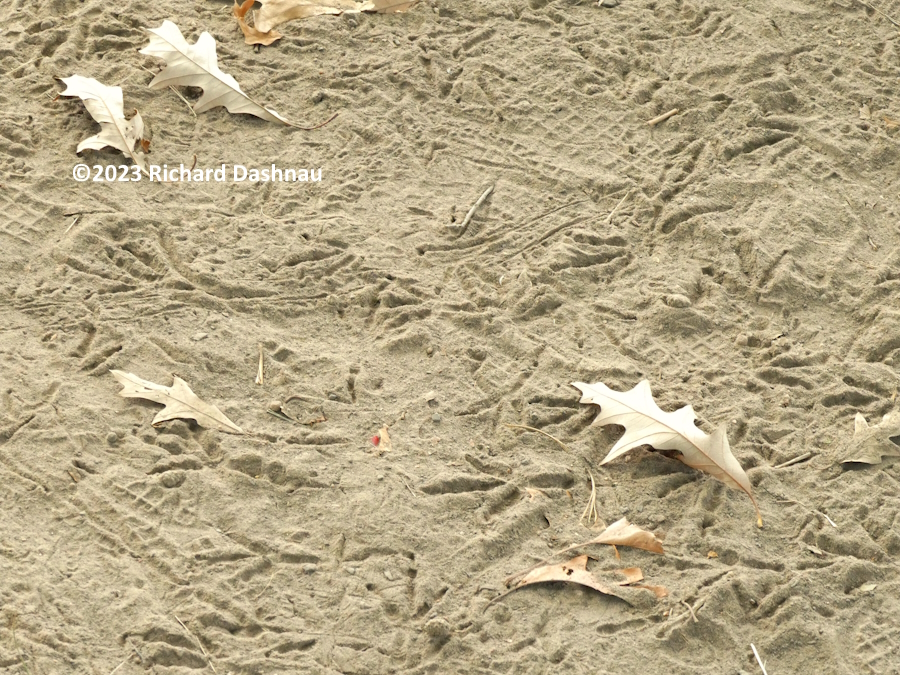
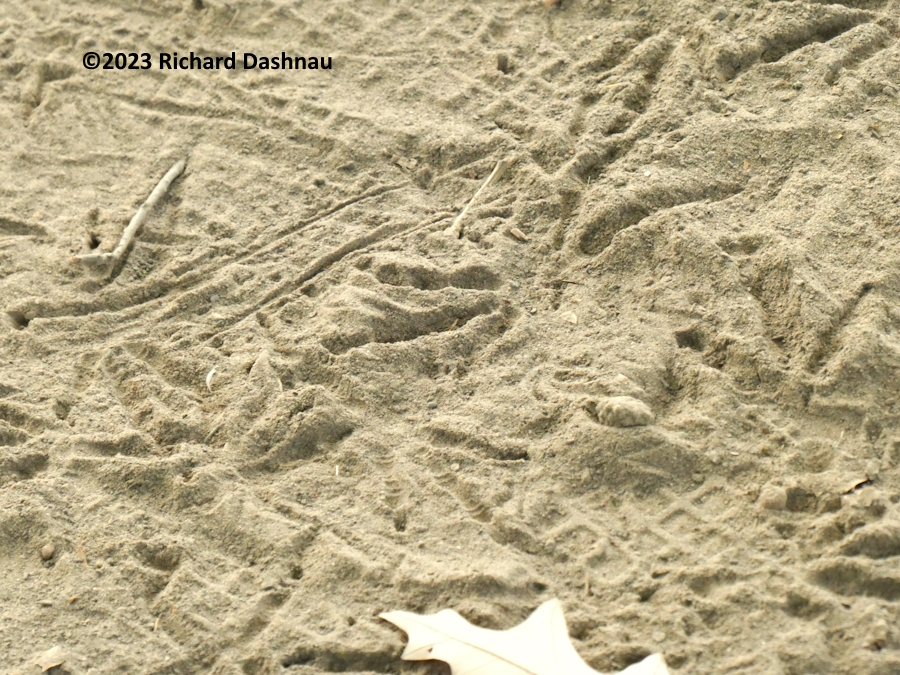
Unlike
some of the bird footprints I've shown from here, these show the 4th
toe pointing back from the front three toe impressions. These
are "anisodactyl" prints, and are the most common
type.
Perching birds (such as Grackles), and some other types (Hawks,
Vultures, Robins, etc.) leave this type of footprint.
Grackles
have often joined me during my exercises at this park,
and it's
likely they left these prints. Pictures 7 and 8 show the
prints
in closer view, and emphasize how this fine-grained dirt captured
detail. Claw marks are visible in image 8. Just another
example of the variety of animals that visit this circle.
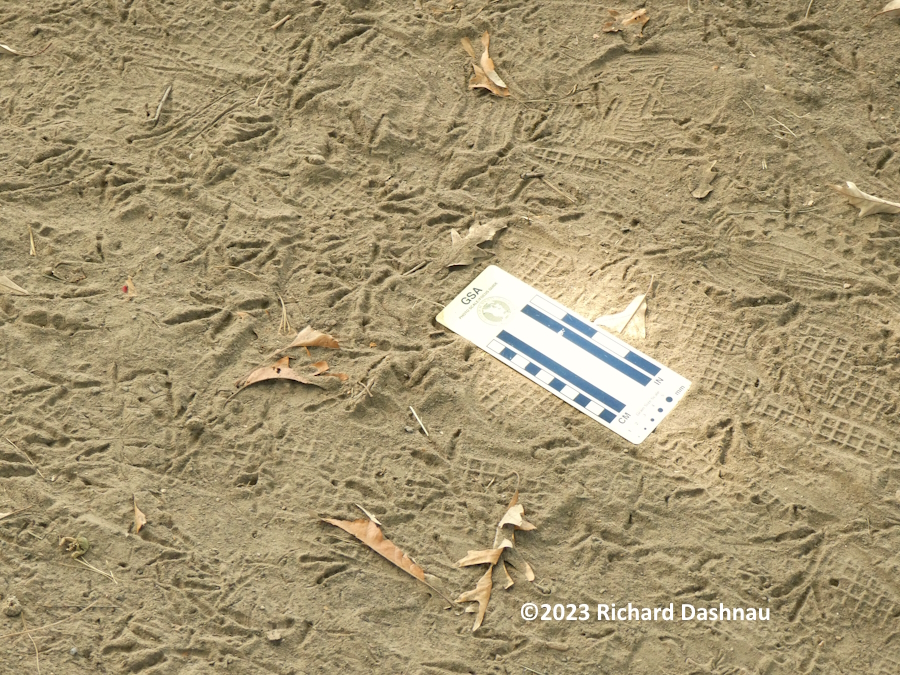
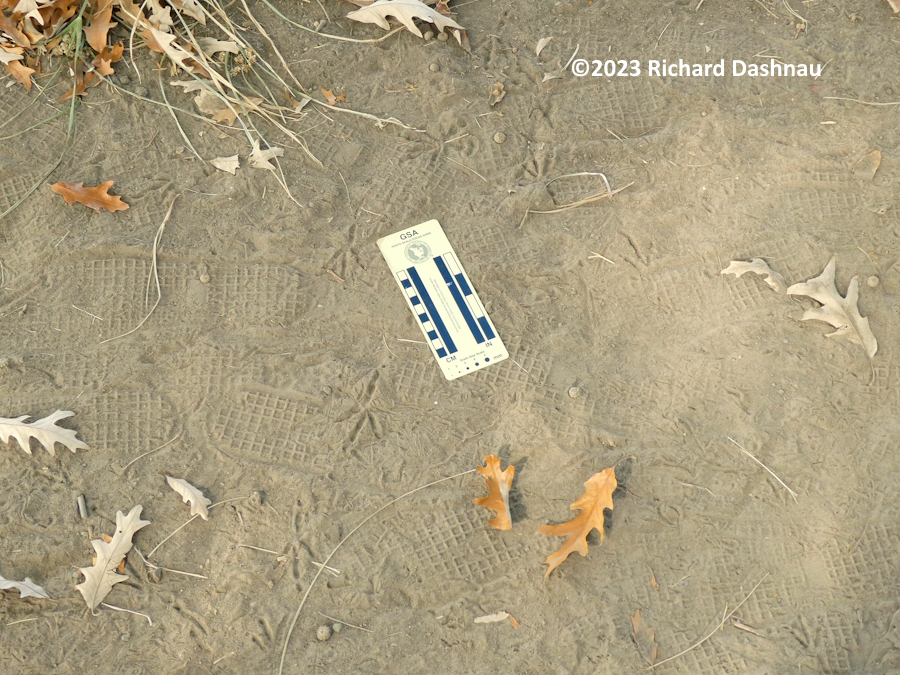
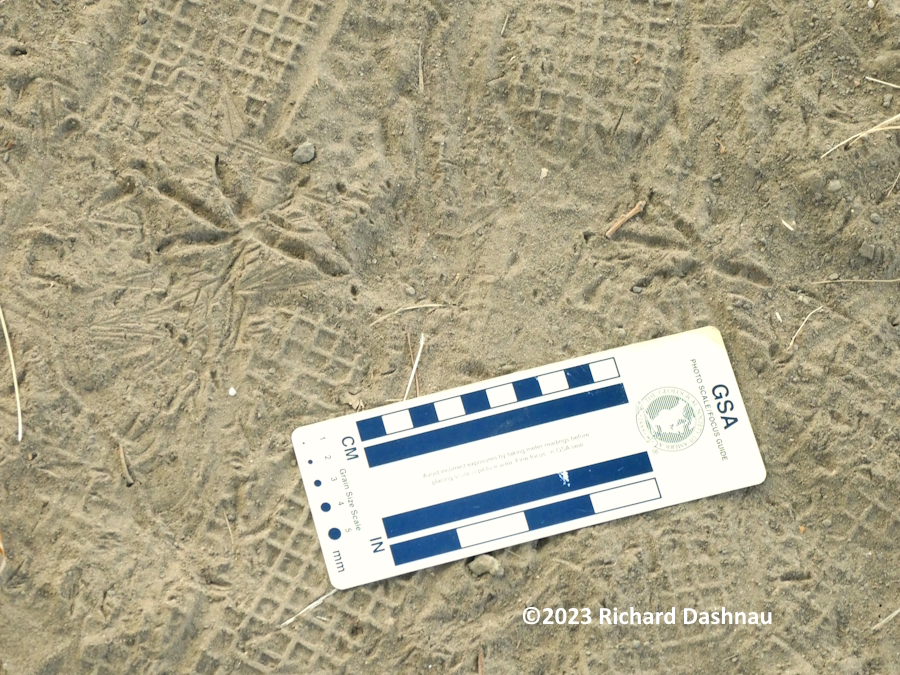
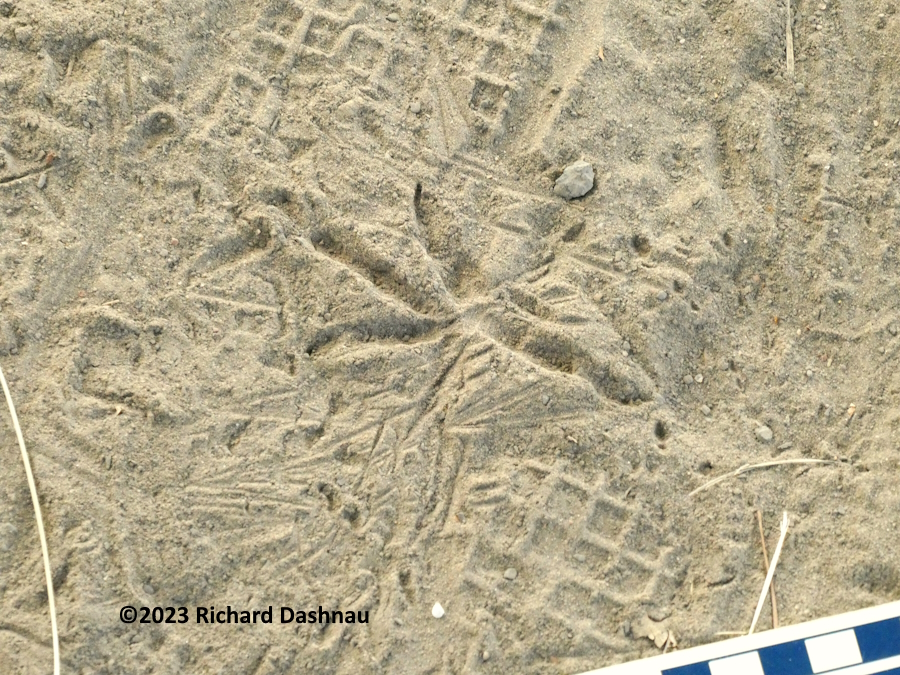
08/09/2023 (added 4/27/2024)
More
new tracks from the
night before. This morning, there were more of those marks that
flattened the dirt into irregular trails. At this time, I suspected
that a
snake
had crawled through (pictures 1-4 below). There were also more of those
arthropod tracks and of course more holes from Cicada nymph
emergence. (picture 5 below).

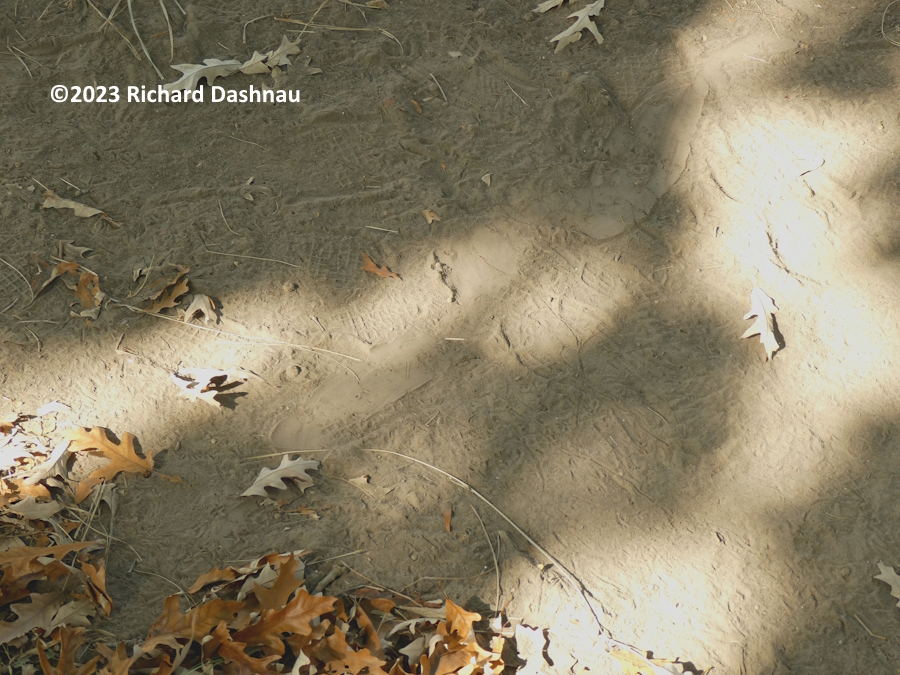

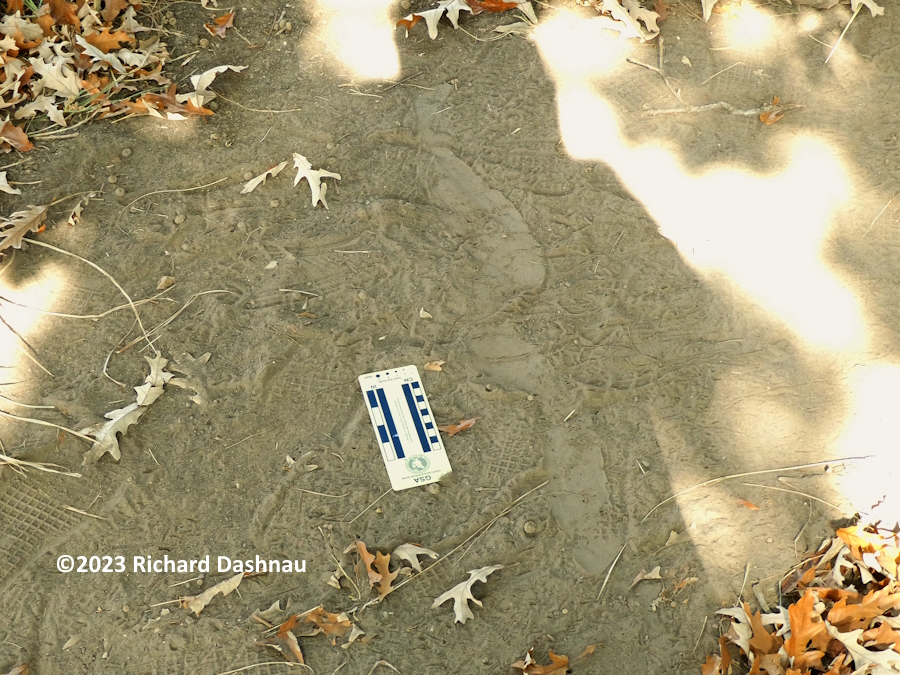
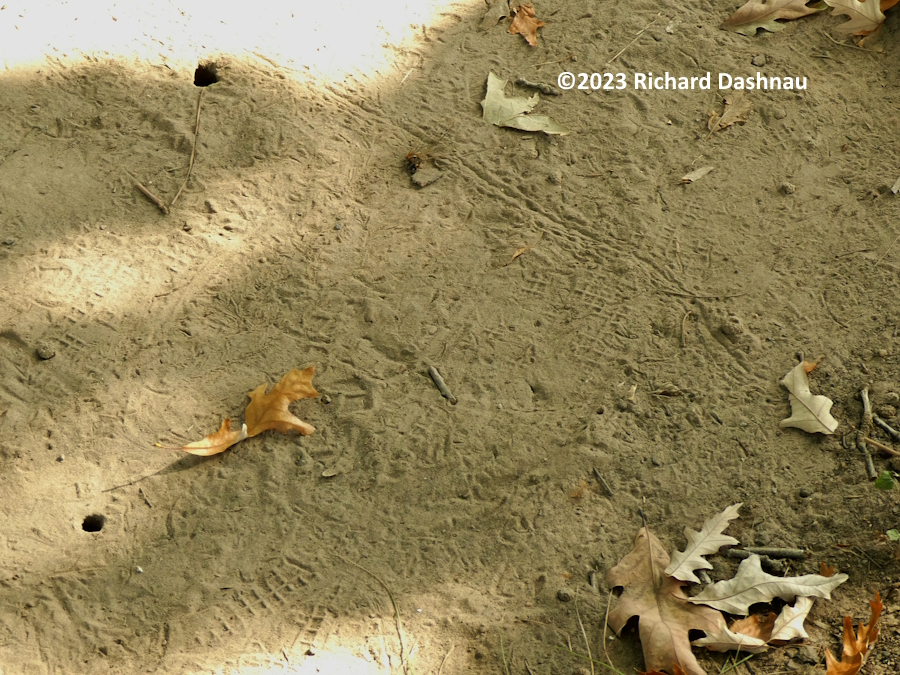
Image
6 (below left) shows at least 4 trails in the dirt. The trail that
crossed diagonally from top middle to bottom right corner seems to have
been partially blurred by another of those "snake"
trails.
Image 7 is a closer look at the trails. The scale shows that the
creatures that made them were pretty large-for insects; or at least had
a wide leg span. Images 8 and 9 are different trails.
Picture
10 shows a hole with at least one trail seeming to lead away from it.
I'm guessing, since it seems unlikely that something would have walked
straight to the hole. When I took the first few
images in July, I hadn't intended to begin this record. But, there was SO MUCH traffic;
that I recorded it.
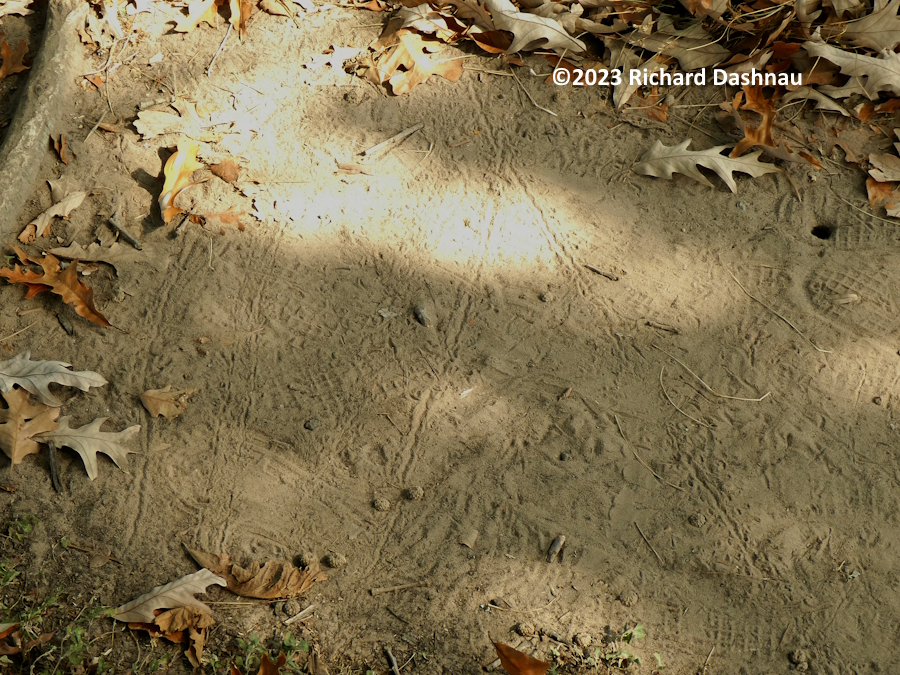
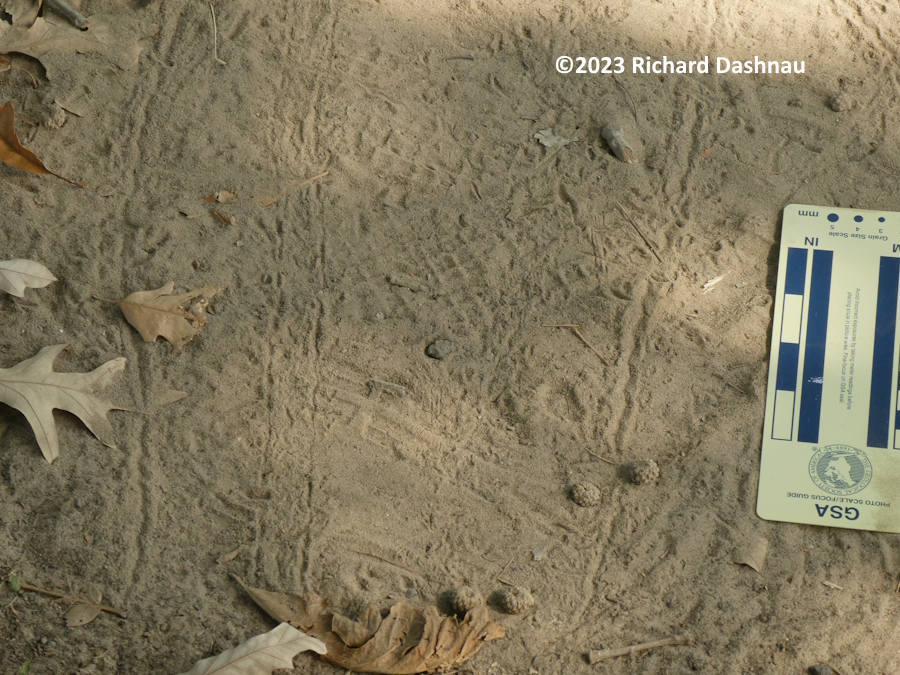
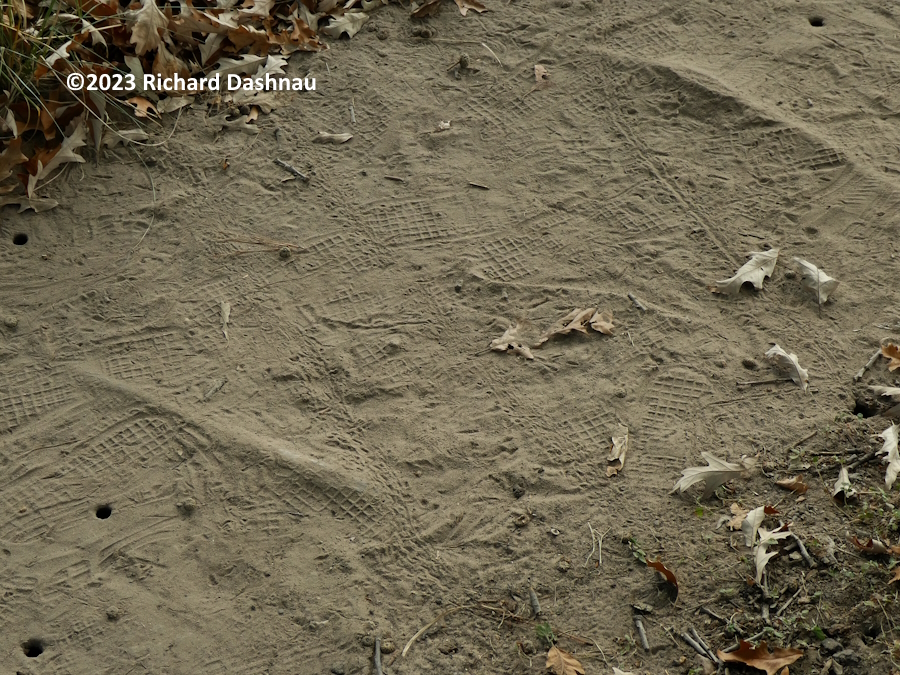

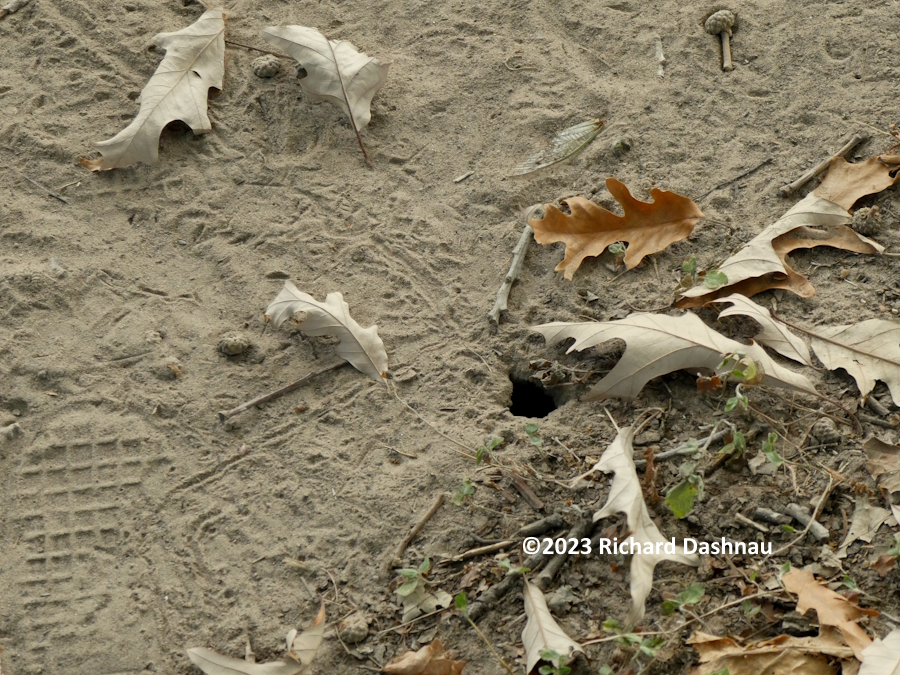
08/11/2023
(added 04\25\2024) Today, there was a deep furrow cut into the dirt. If
I was at Brazos Bend State Park, I'd have guessed an alligator at
first. The
drag mark crossed the circle
twice.
There was also another
of those sinuous, flat snake tracks (picture
2).
But, there were also some interesting footprints alongside the
furrow. (picture 4)
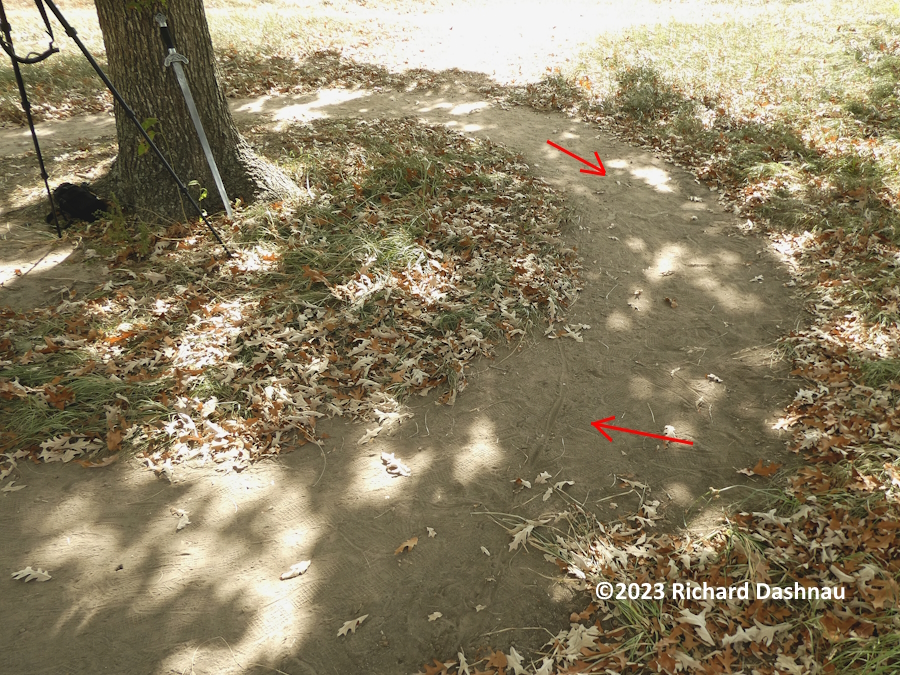
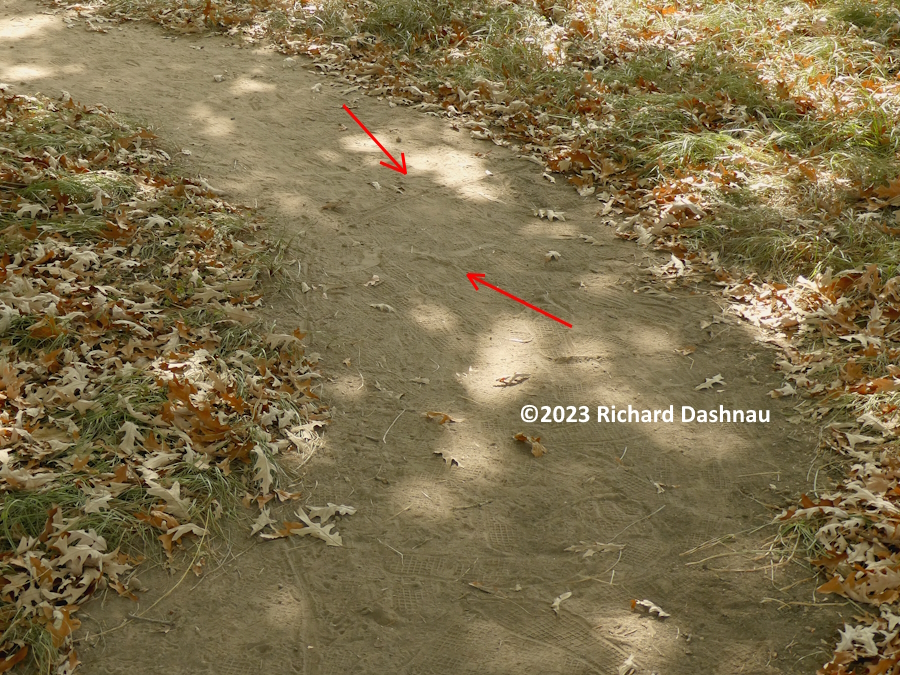
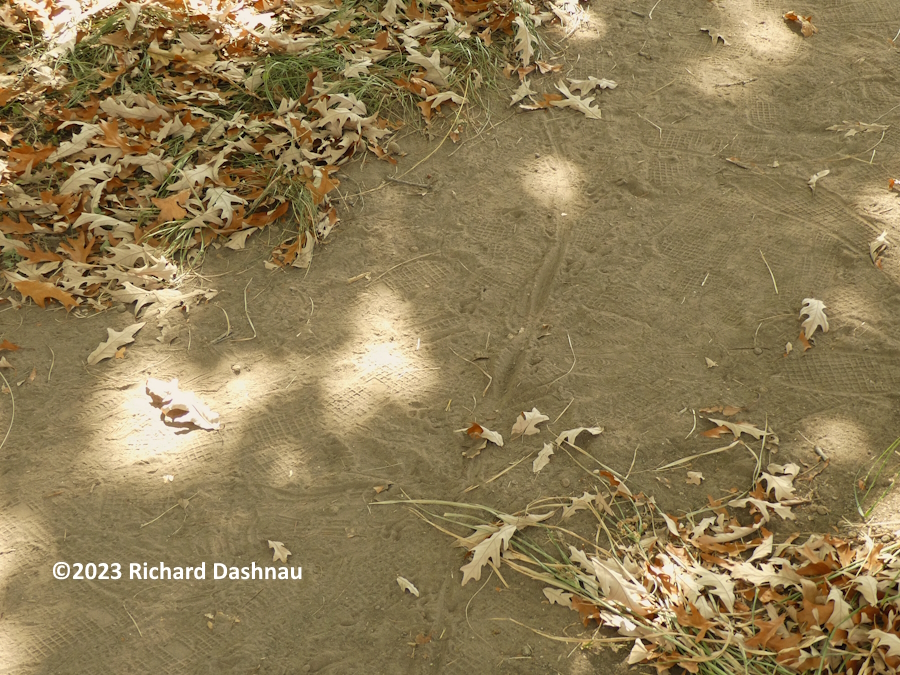
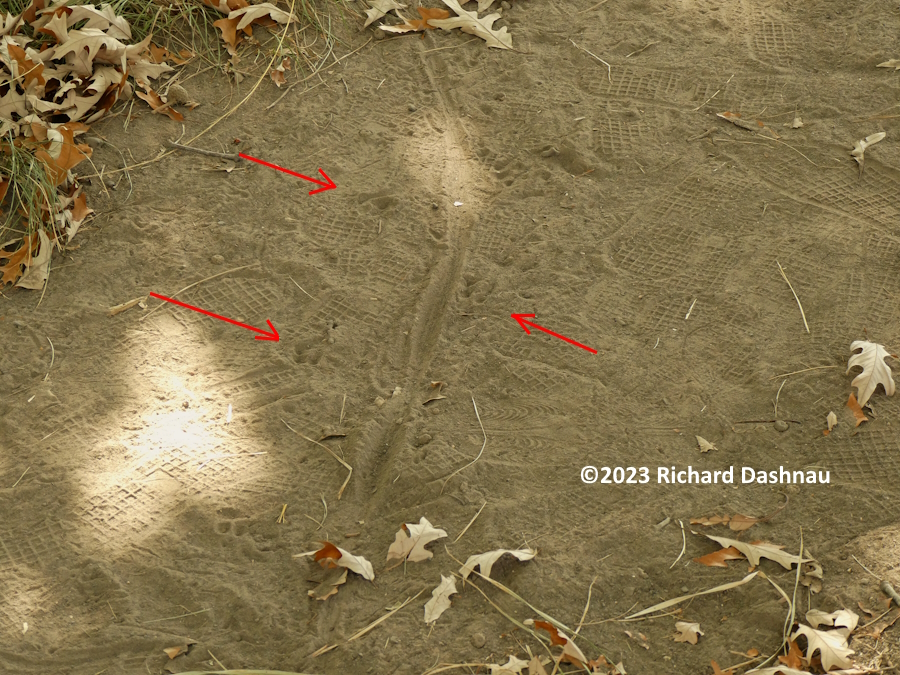
They
seemed to be impressions of just the toes. (Pictures 5,6 below)
Pictures 7 and 8 show the drag marks, along with the snake
mark, from another angle.
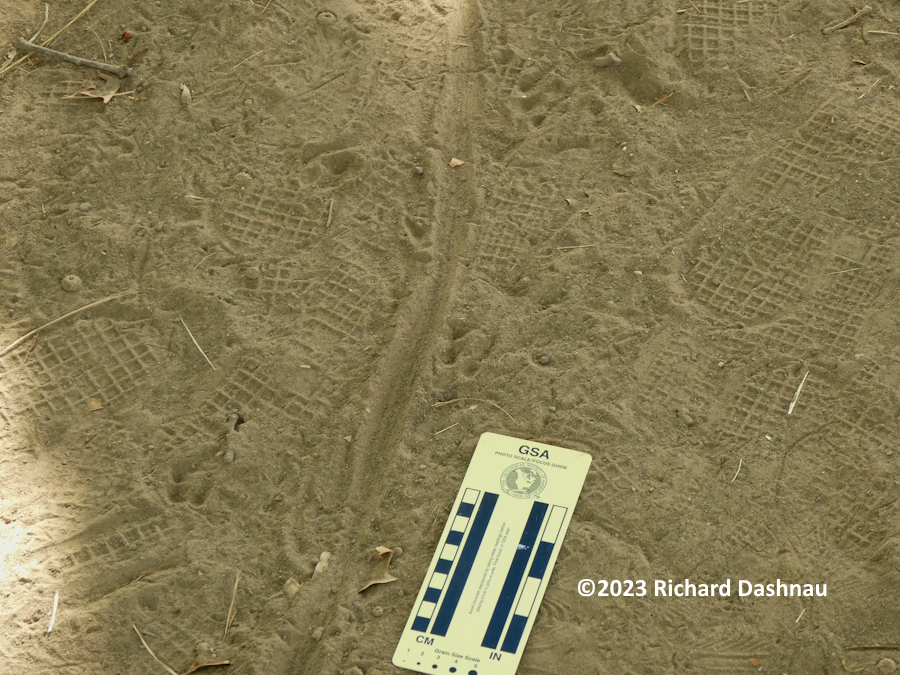
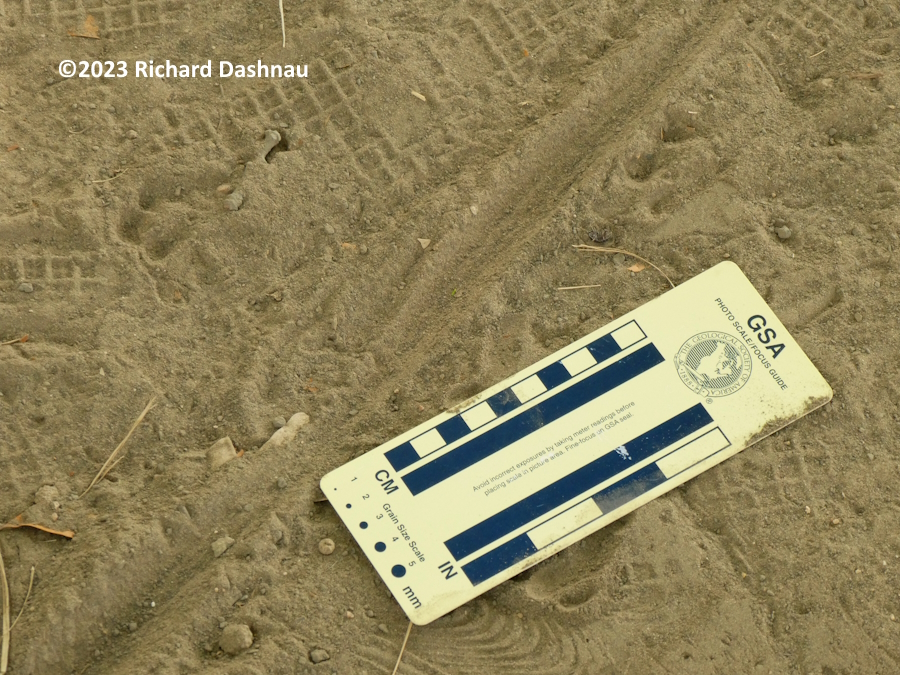
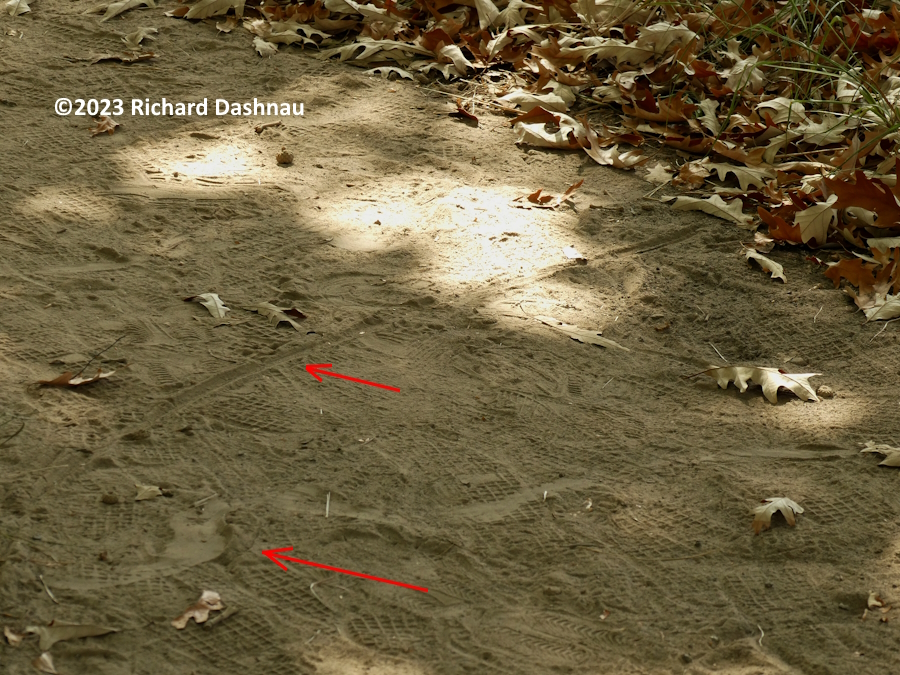
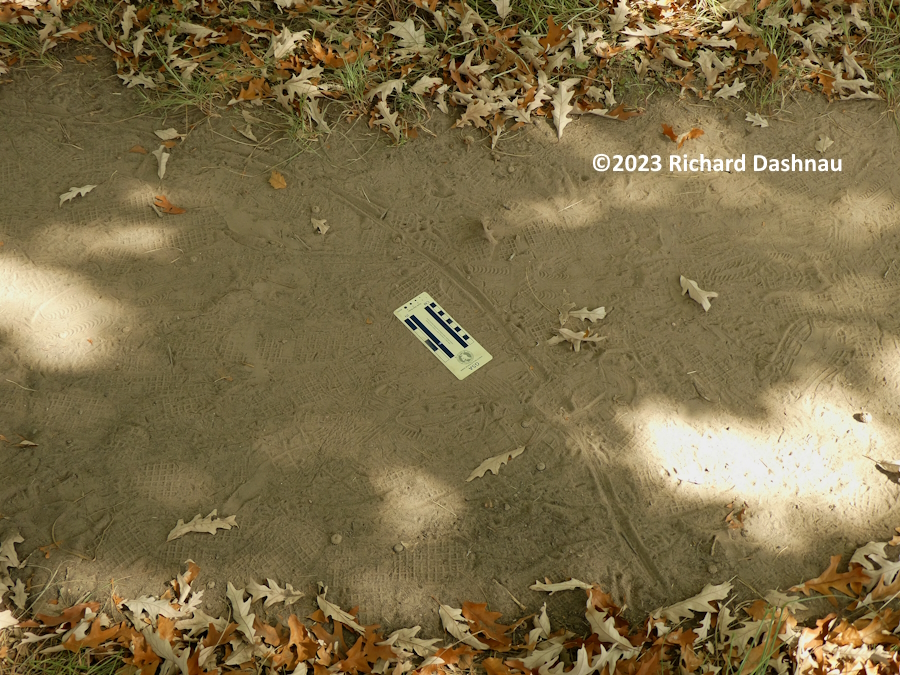
Images
9, 10 show more views of that set. Images 11 and 12 show a different
type of track. There didn't seem to be any "foot" impressions, and this
strange double track. Maybe something
dragging its feet? Like a
small lizard? And, next to that--another of those odd
flattened
trails. My guess would be that it whatever it was had crossed
the
trail more than once. Copperheads
hunt Cicadas at night. They
often catch them right after they do their "final" molt--when the adult
Cicada comes out of the nymph. At the time, the park maintenance was
not cutting the grass
in the area around the tree (and my circle),
so it was thick. A copperhead could have hidden somewhere around there,
and I searched a bit before continuing my exercises. I figured if
a
Copperhead did hunt the area at night; it would return to its
preferred den in the morning.
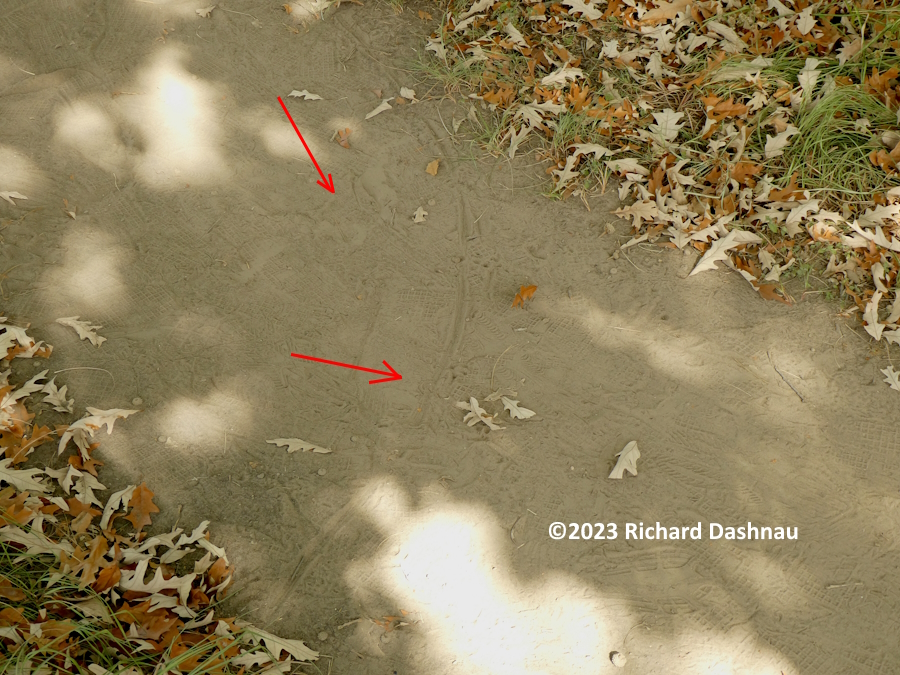
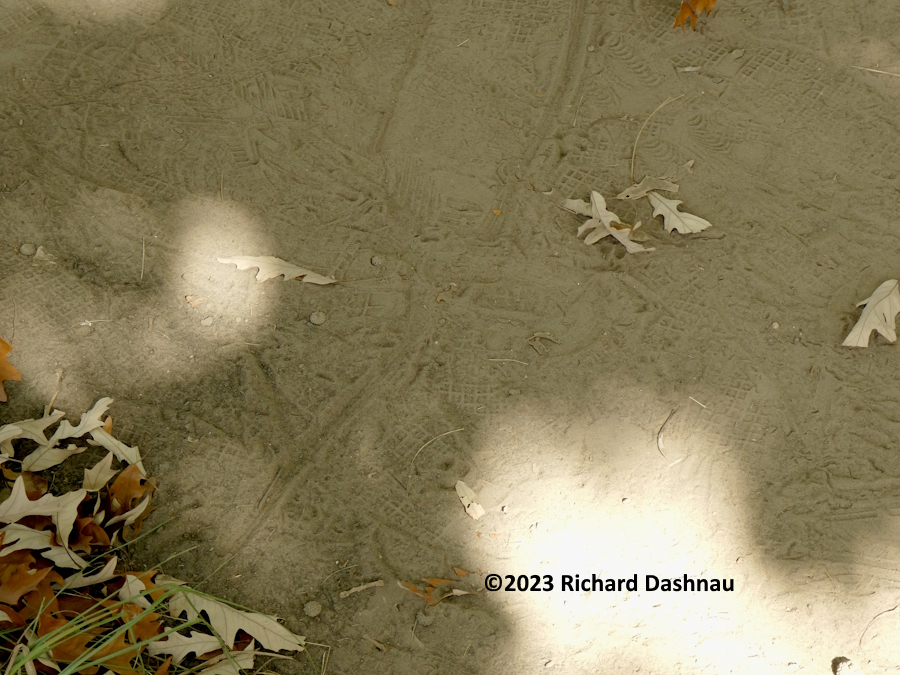
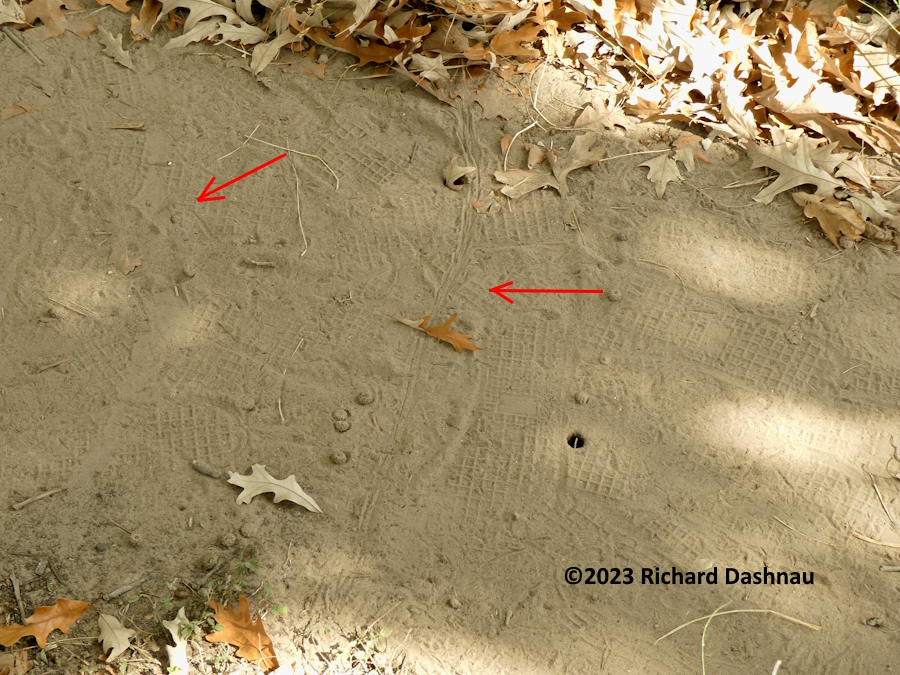
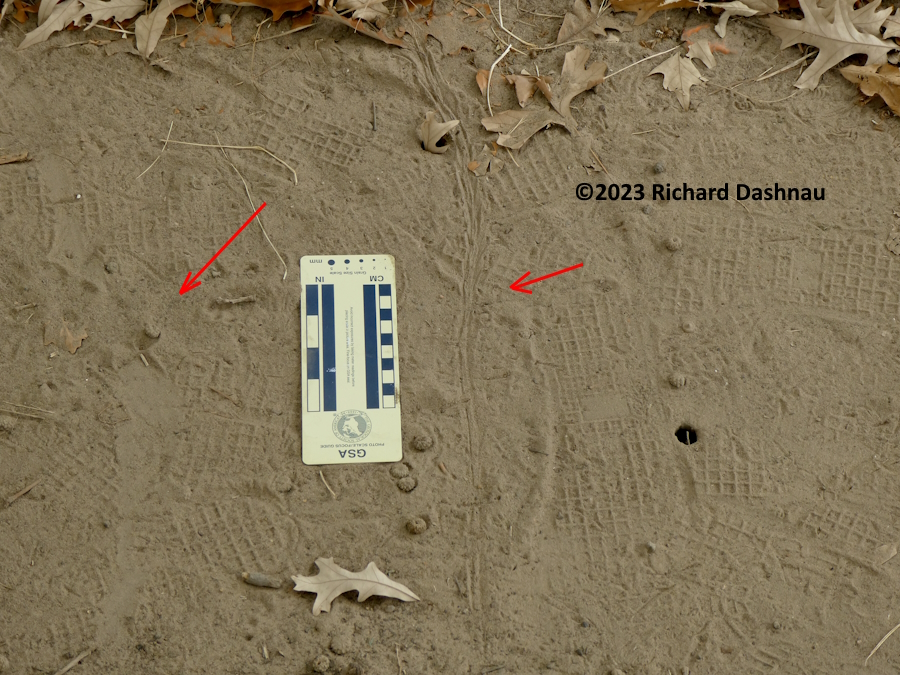
08/14/2023
(added 05\01\2024) Today, a really large (considering
it was made by some kind of arthropod)
track crossed the path. There seems to be evidence of many
structures pushing
against the dirt on either side of the meandering trench.
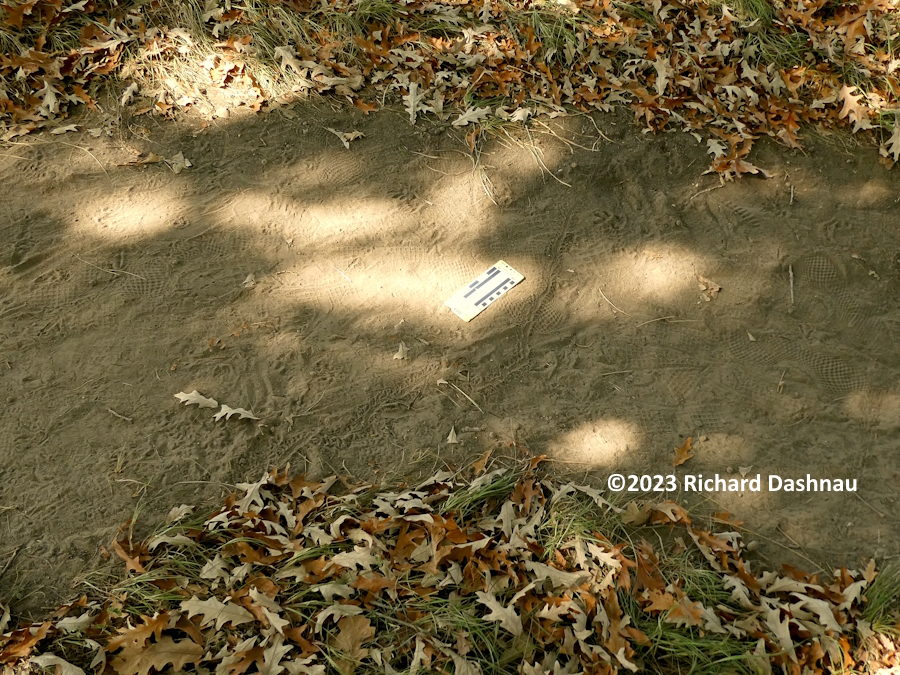
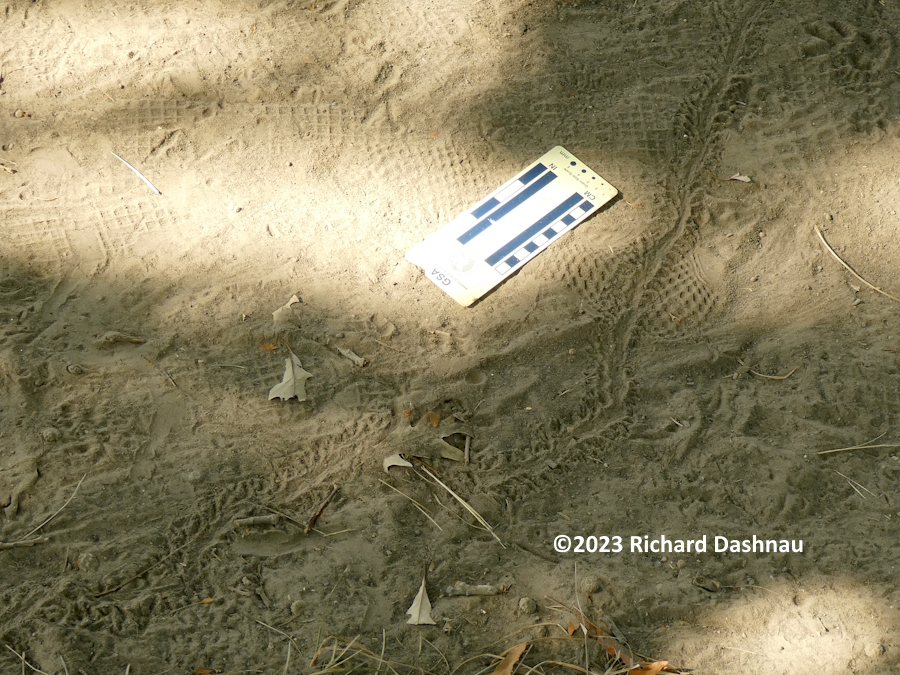
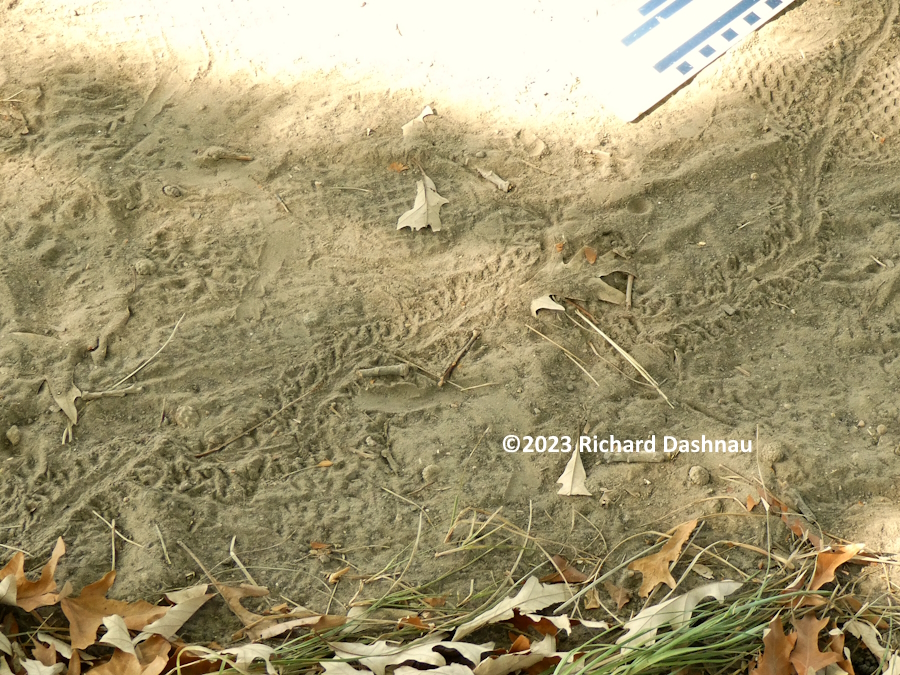
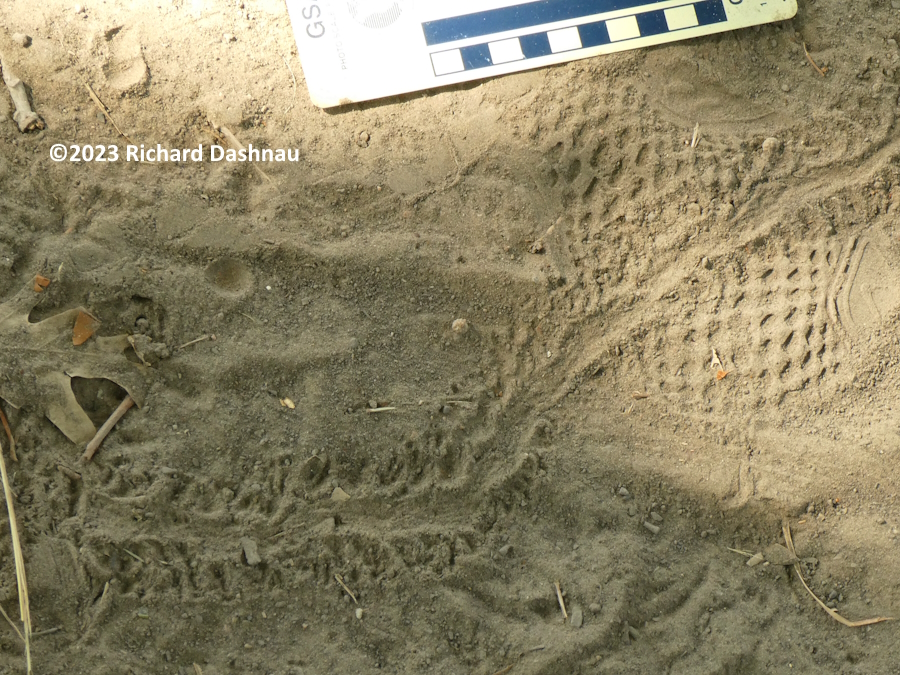
An
interesting factor of this track was the very erratic changes of
direction along the way. Changes in direction were not smooth, but
rather quick. Was the track-maker dragging something?
The
final 2 images show some three-toed tracks without the 4th rear
impression. Was the bird running? And, there seem to be a few squirrel
tracks below and to the our right of the scale.
I often see Squirrels here, crossing the trail and running up and
across the center tree, and the others around.
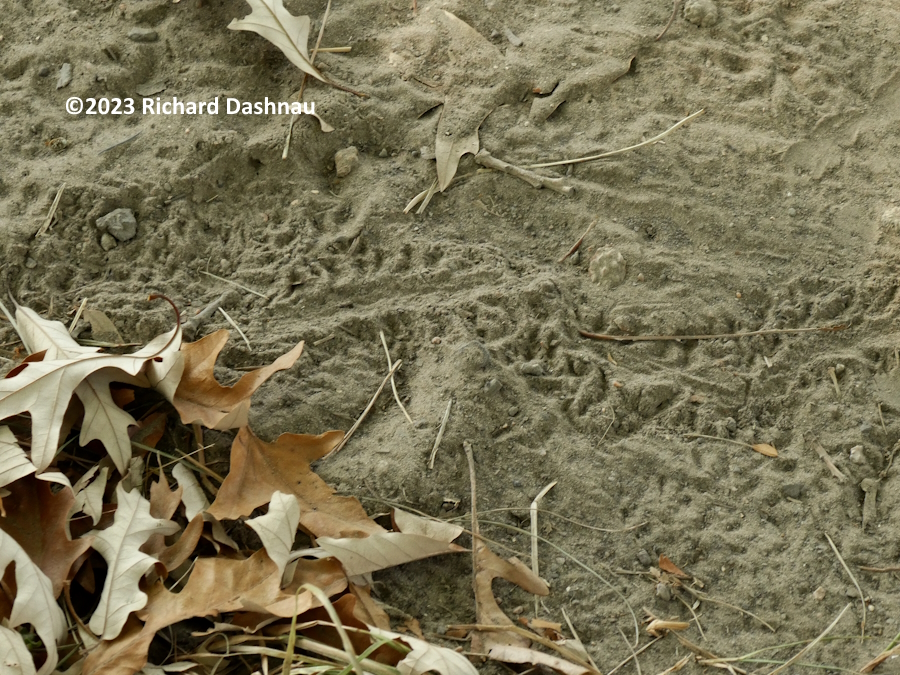
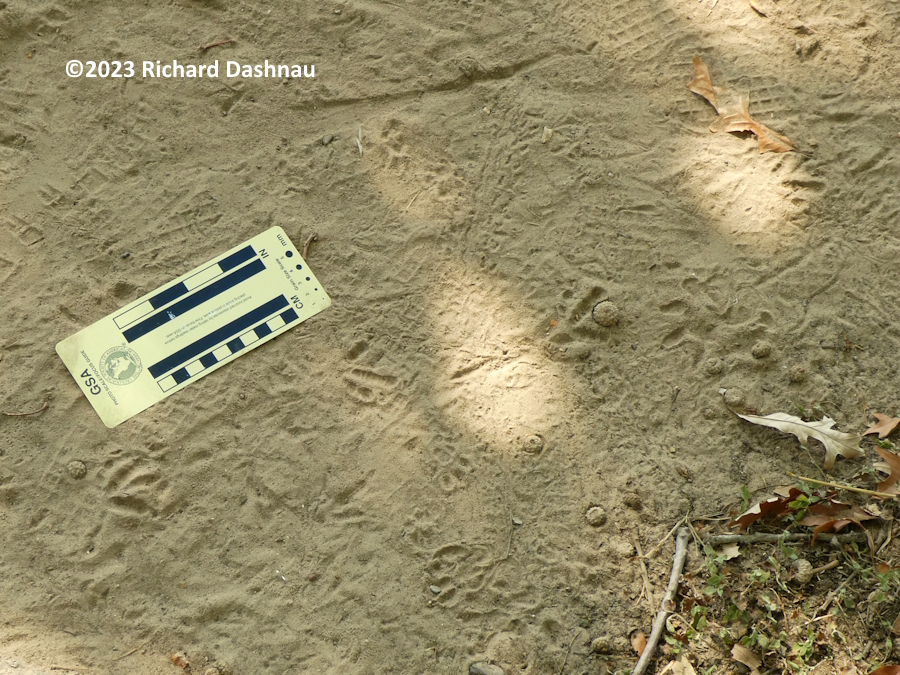
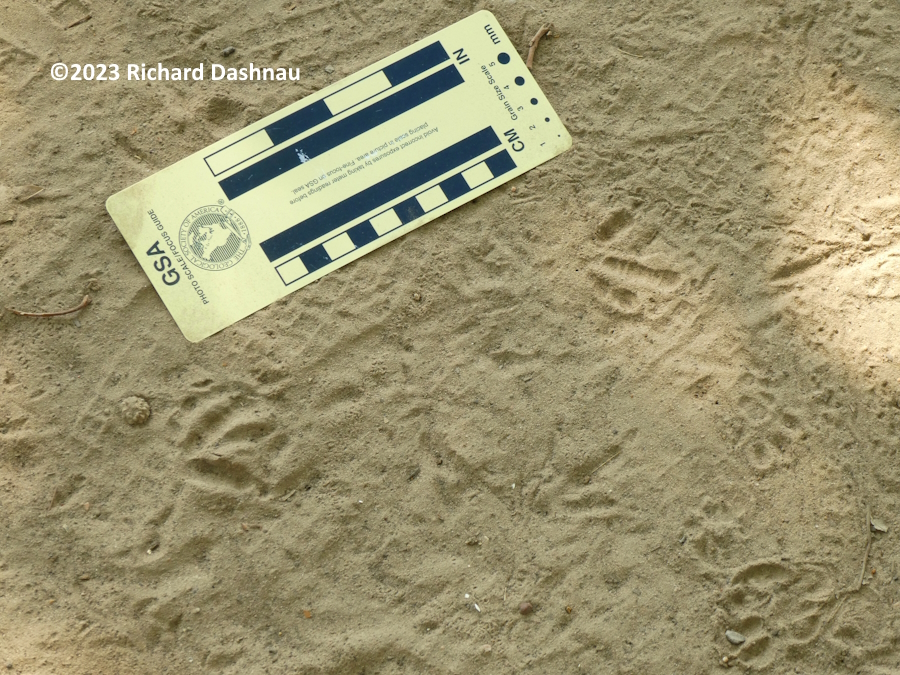
08/17/2023
(added 05\01\2024) Today, a possible solution to the "snake tracks"
I've seen on my trail. While I was doing my exercised, a large snake
crawled out from inside the 1/4-mile
track
and crossed it. It was moving towards me, so I ran for the camera
(which I'd had at the base of the tree). I wasted a few seconds trying
to shoot photos before deciding to shoot
video, instead. The
snake moved onto, then into the grass. Then I could only see it
briefly--when I could find it. I did catch a few frames of video, and
two frames are shown below. The snake
was around 36 inches long
(maybe a bit longer), dark, solid green on top, pale yellow below.
After checking various sources, I believe this was a Eastern
Yellow-Bellied Racer;
Coluber constrictor
flaviventris. From
those sources, and from this study: Natural History of the
Racer
Coluber constrictor (1963), By Henry S. Fitch , I see that
the
racers often hunt among
grass, and seem to be opportunistic
predators. Depending on where they are, they eat various
reptiles, mammals, bird, and insects. Preferred insects seem
to
be grasshoppers, or
grasshopper-like; but Racers on record as
eating Cicadas. The sighting was brief, and does not prove
that
the tracks I saw in the dirt were made by snakes...but at least I know
that they are
around. My first guess was that the trails might
have been made by Copperheads, but any snake would be possible. The
Fitch study mentions that this species has been observed eating
a
Copperhead-but rarely. (sections [398] to [399]. I was very excited to
see this snake! And, admittedly, somewhat distracted as I continued my
workout-since I was ready to run for the
camera if the snake appeared again. And, this is the video that I could collect.
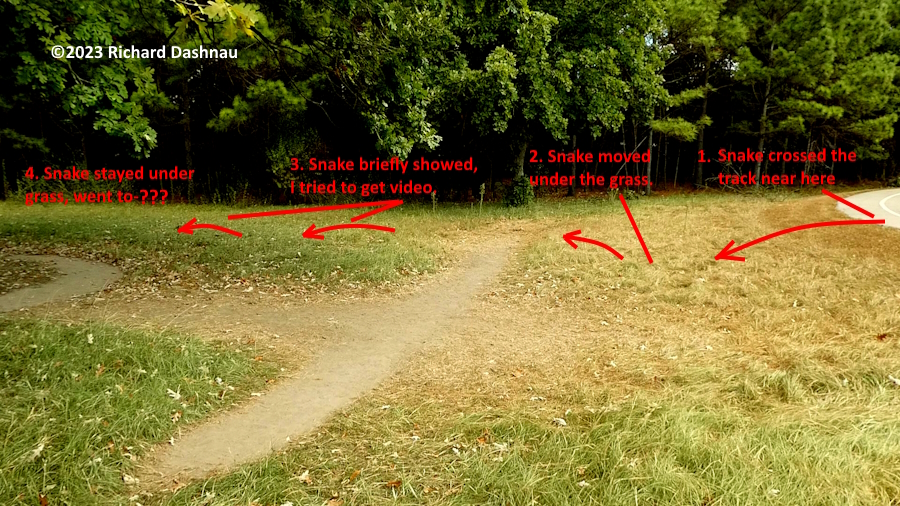
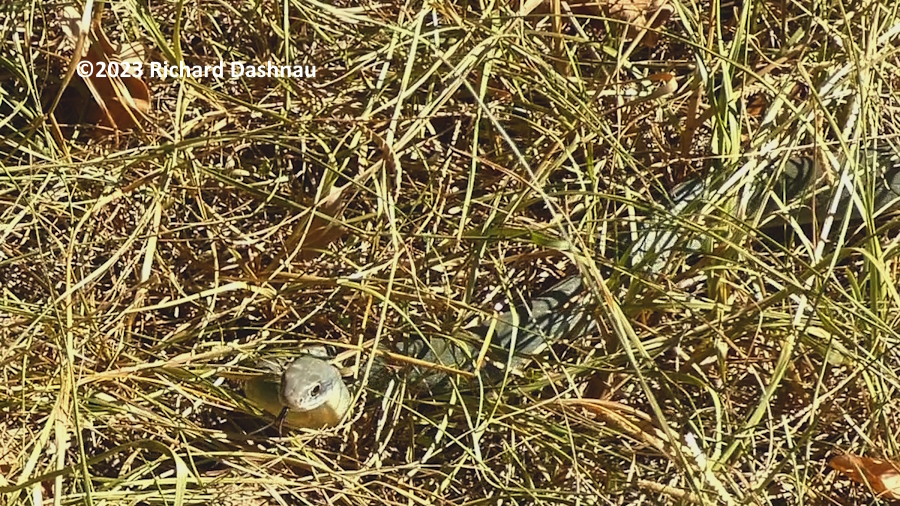
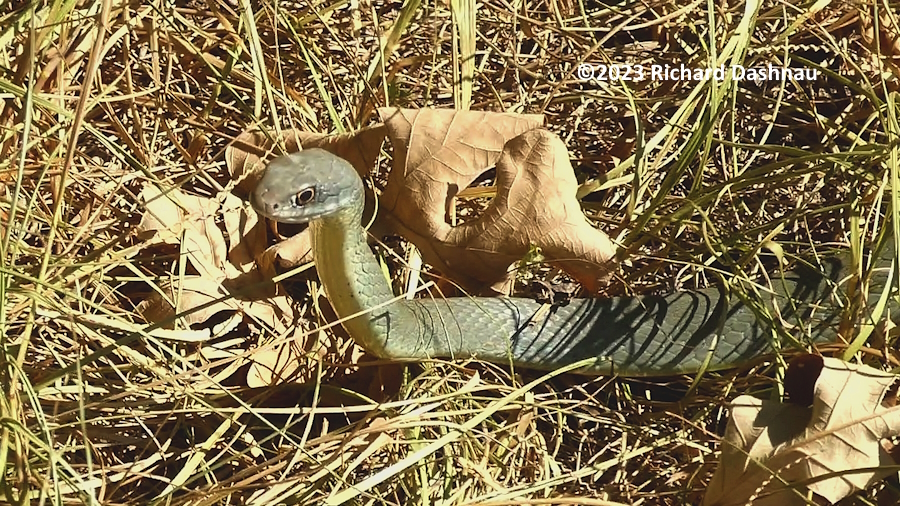
08/18/2023
(added 05\02\2024) I started today with some of the "usual" sets of tracks in the dirt.
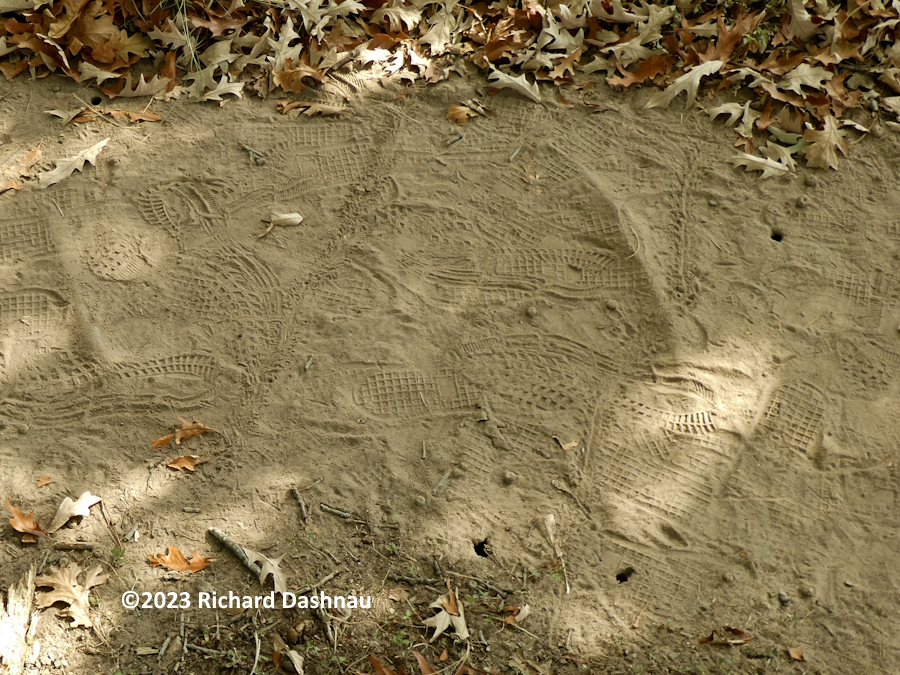
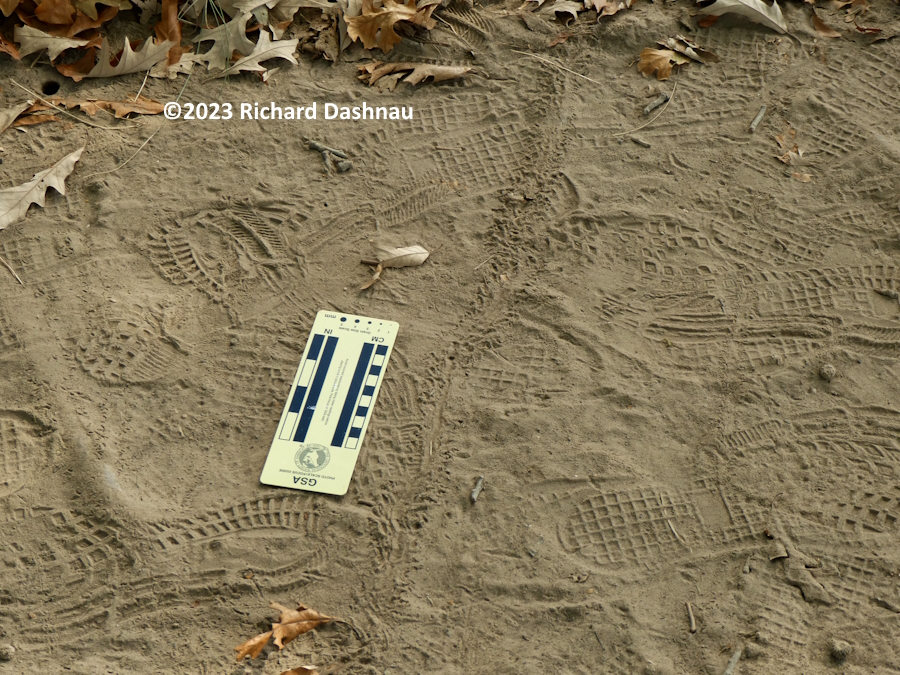
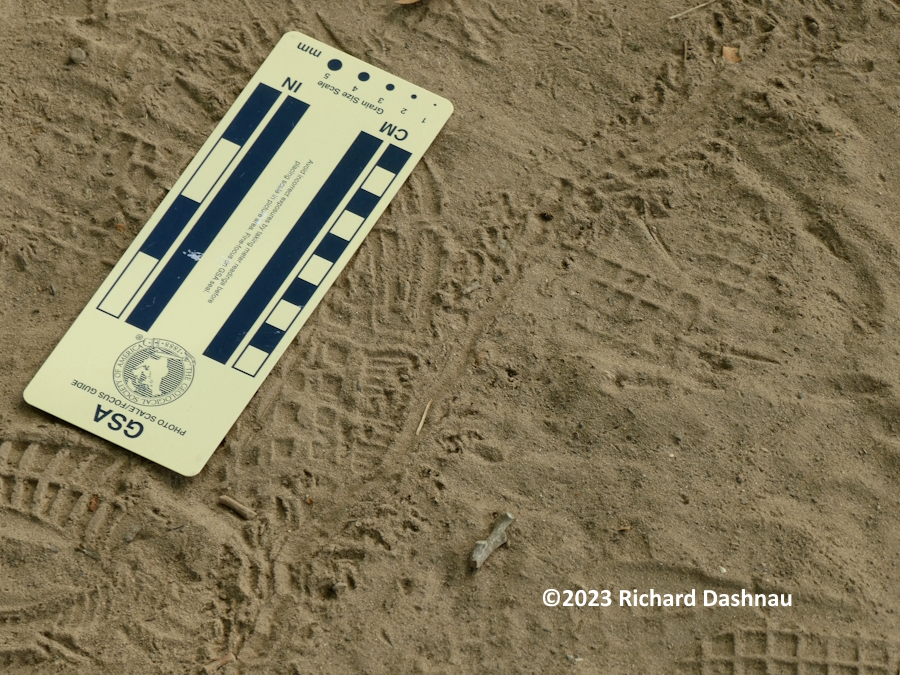

Today
I noticed a set of very very small tracks (about 5mm overall)
with...2-toed feet(?).(image 5 and 6 below). The prints didn't appear
to my untrained view as "paired"-double prints. That
would show that
something was hopping on two feet--like a very small bird. Image
7 shows an odd track that shows how something was dragged through the
dirt next to it. The bird track in
image 8 shows interesting detail because of the fine grains in the dirt.
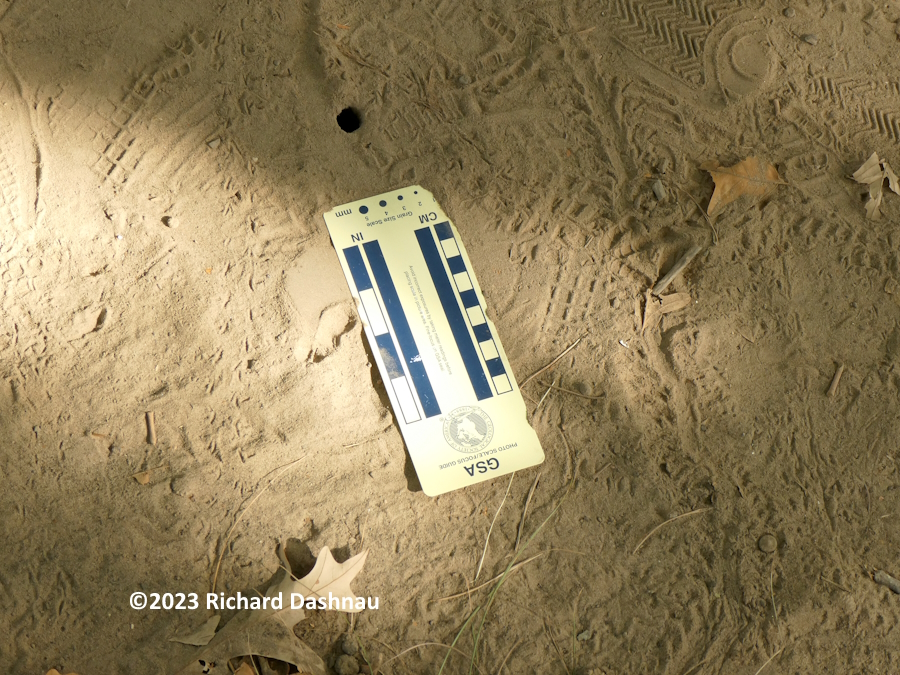
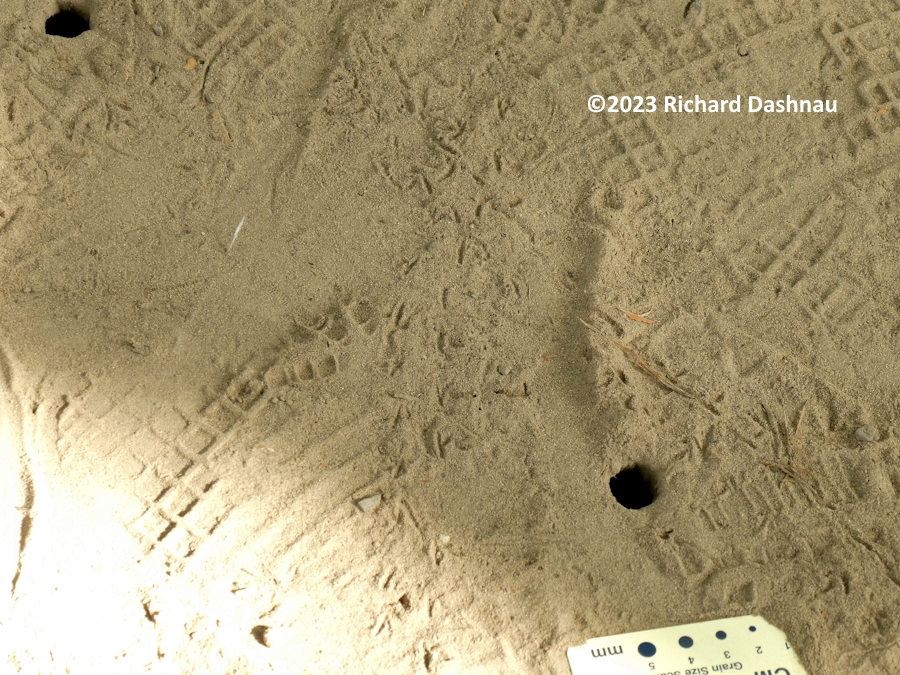
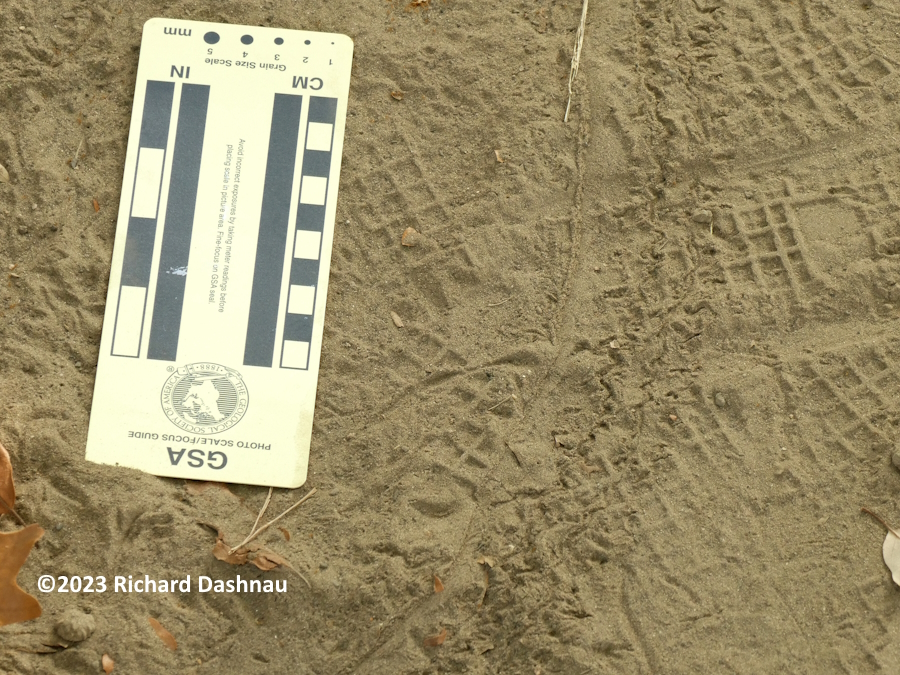
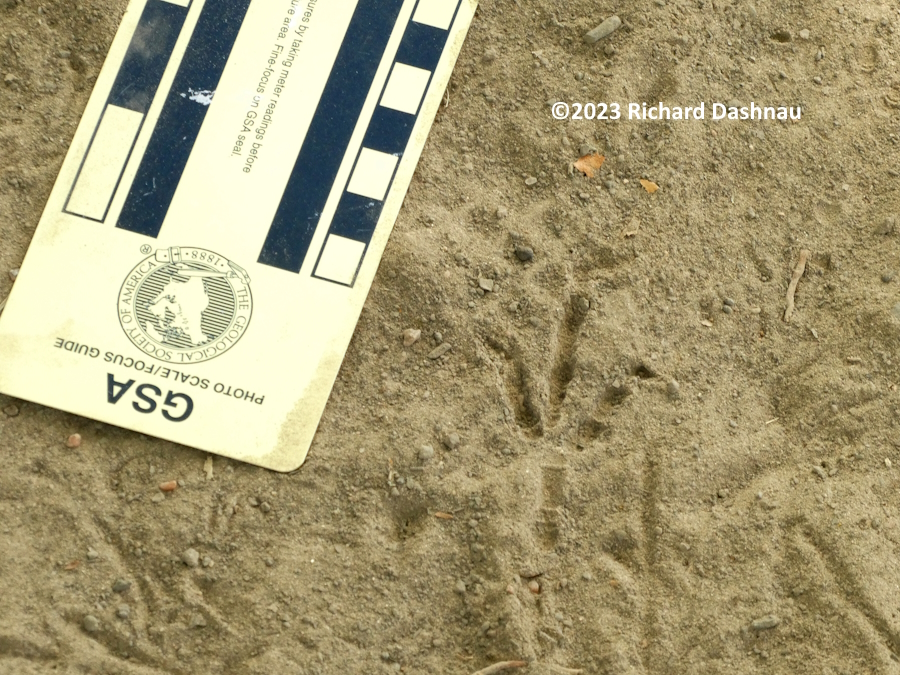
Yesterday (or the day before, anyway). I had seen a snake crawl by in the grass. That had a happened about 10:15 am. On this day, the snake reappeared! I was working out on my straight
dirt
trail, but very distracted because I was hoping to see the snake
again. I kept looking North, towards the trees. The snake appeared at
about 10:30, but on the South side of the tree, a bit
closer to me.
It was moving towards the circle, so I took a wide curve around
the tree to the base of the tree get the camera. Even though I
moved carefully, the snake moved out of range
before I could get any pictures of it. But...I did
get pictures of a fresh track the snake left in the dirt! The four
pictures below show various views of this track. It was the same
species of snake
as the day before. This was terrific luck!
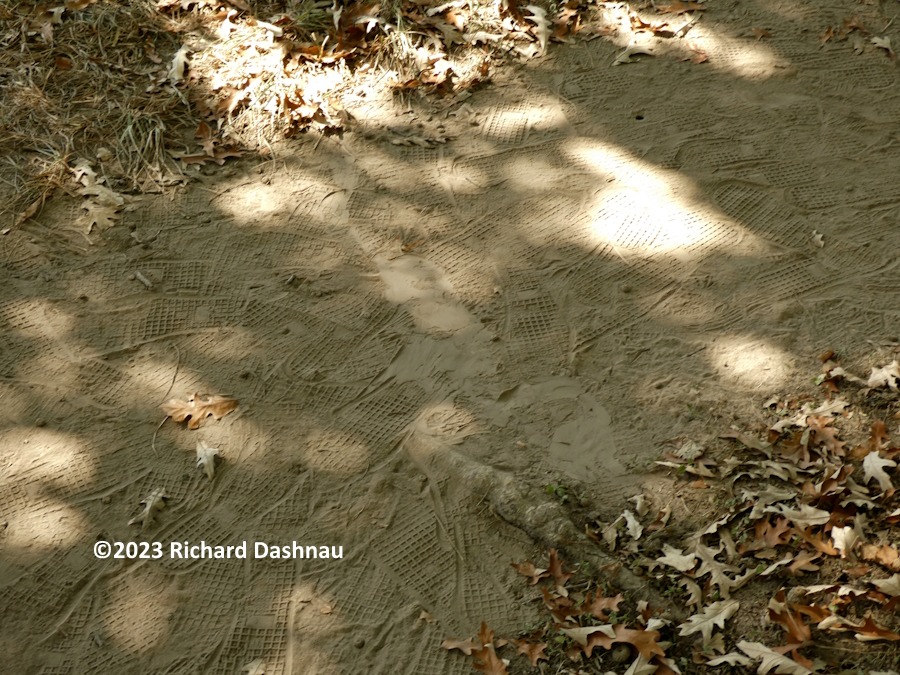
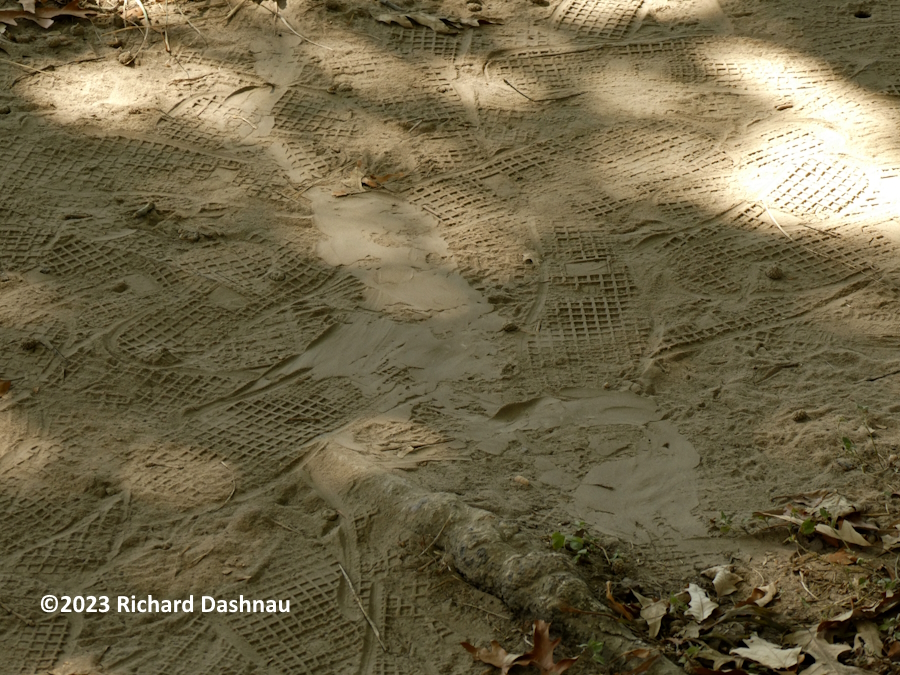
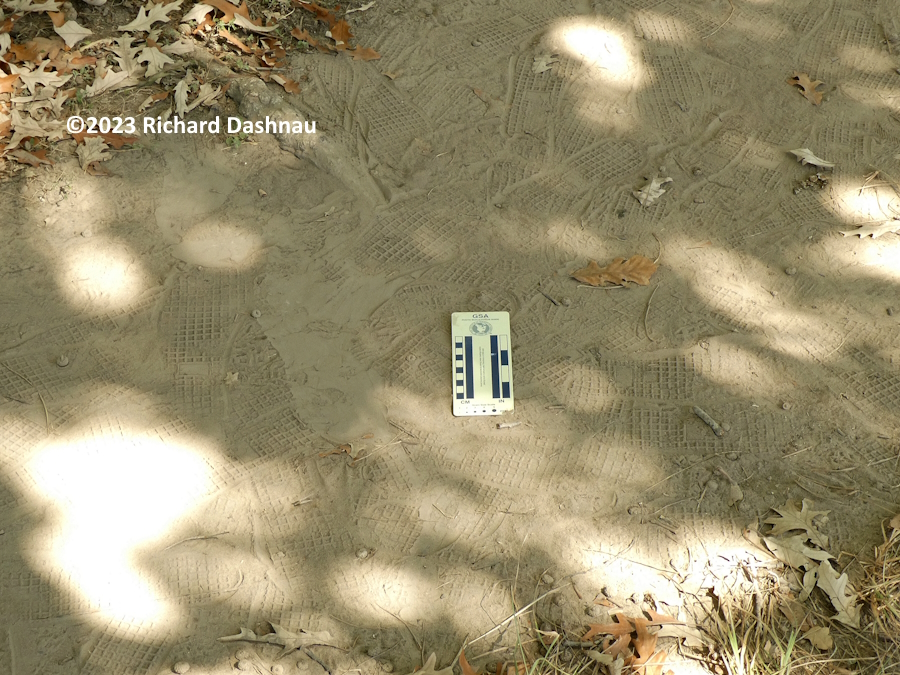
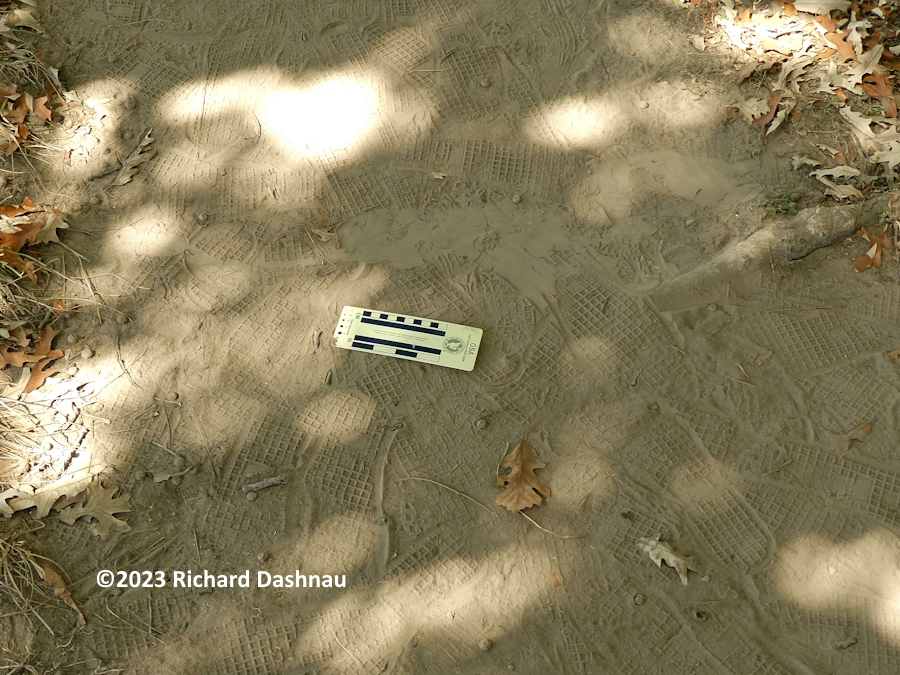
08/19/2023
(added 05\04\2024) I only had time for a brief visit to this spot.
As soon as I got to the tree, I saw something climbing the bark of the
center tree. It was a Cicada being carried by
a
Cicada Killer! It quickly moved out of sight. I thought it might be
trying to gain elevation before taking off with this burden. It
moved so fast, I couldn't maintain focus. If I hadn't already had
the
camera in my hand-looking for something else, I'd never have caught
this. Through August, many Cicada exit holes appeared in the ground,
and their husks hung from branches. There
was evidence that some
were doing final molt in the grass, without climbing anything. It was
amazing that I could see so many things, even when I wasn't
specifically looking for them.
If we watch this
wasp crawling with its burden, we can see how it is climbing/walking
with its first and third pair of legs, while the second pair seems to
be holding onto the Cicada. I also
notice that the Cicada is
carried so its legs are facing towards the wasp, and that its back
sometimes hits the bark. Even though the last is blurry, we can see how
the Cicada walks on a
horizontal surface. With the Cicada's legs
facing "up" it can't cling to anything, and its back would still
rub on the bark...or the ground. Would a Cicada Killer it leave a track
like the one I
saw on August 14th (see above) in the dirt as it dragged a Cicada? The images below are frames from the video, at this link. (and including the video from 08/03/23 (described above).
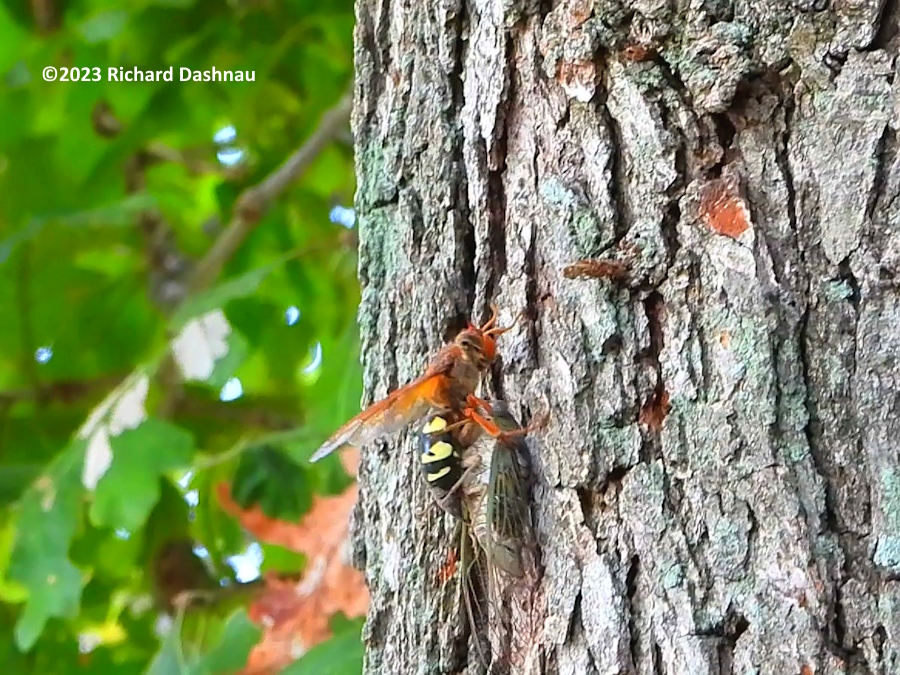
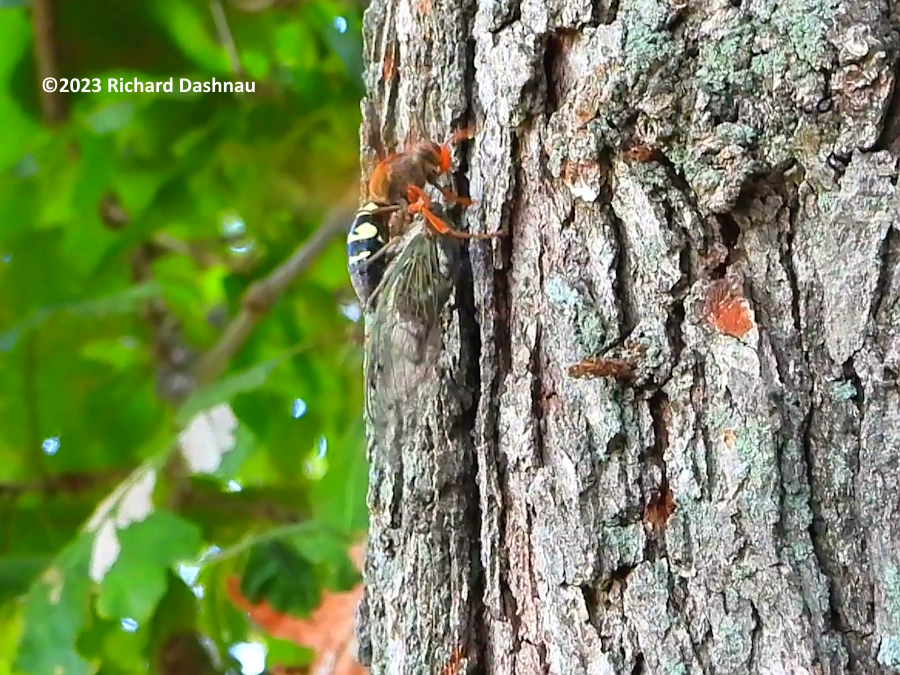
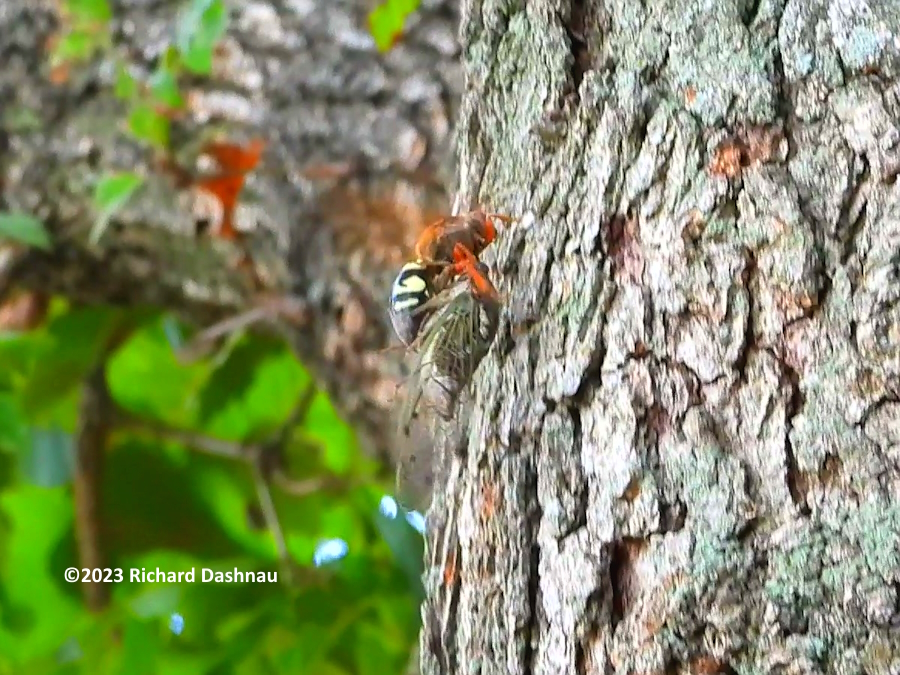
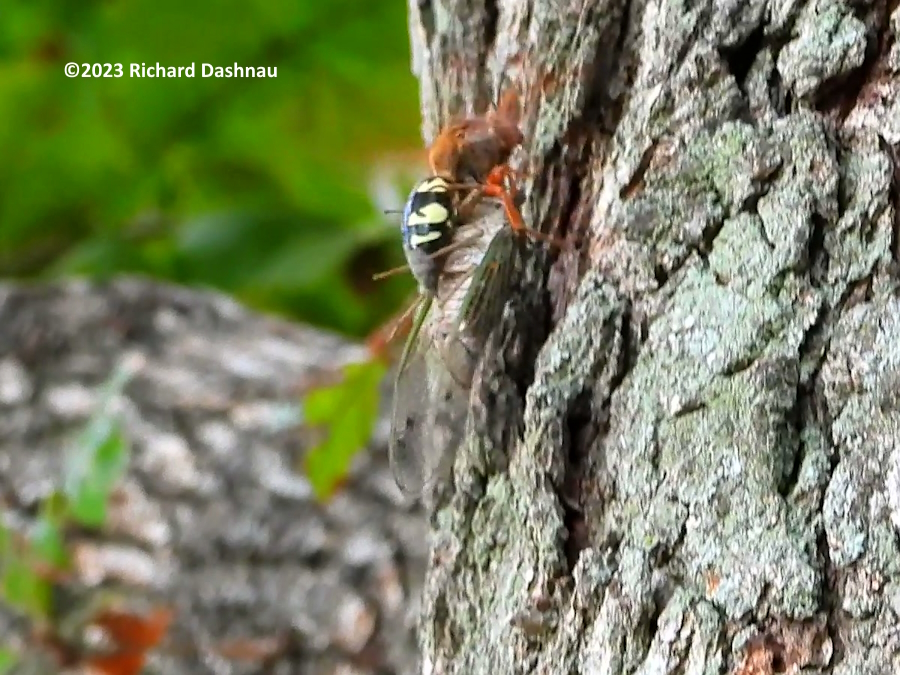
Then,
there was also a wonderful Armadillo track. The groove would have been
made by its tail, and there are the 3-toed tracks made by the longer
toes. I didn't have my geologist scale for
measurement, so I used the
lens cap for my camera.
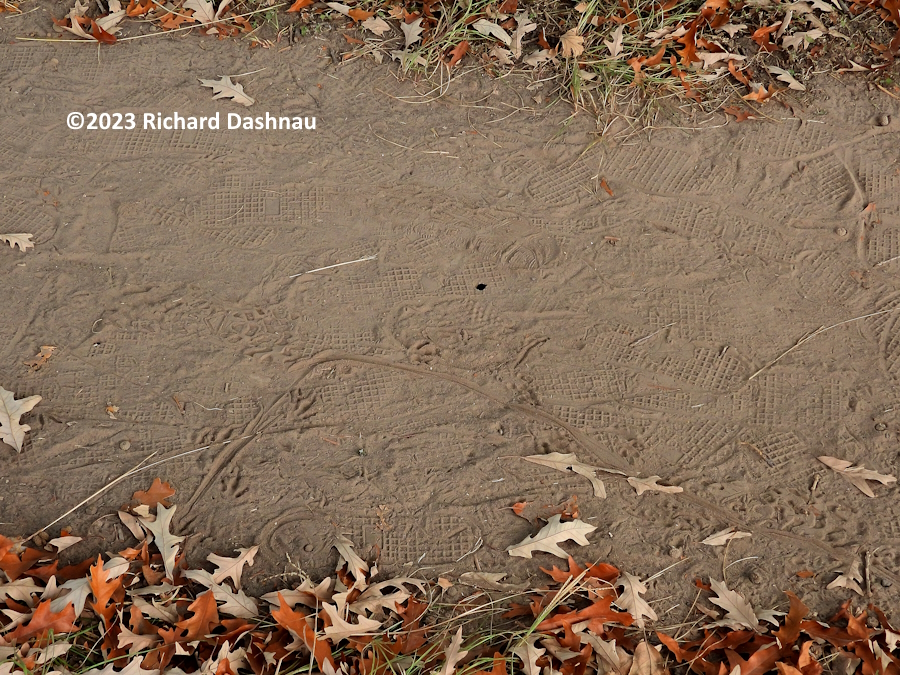
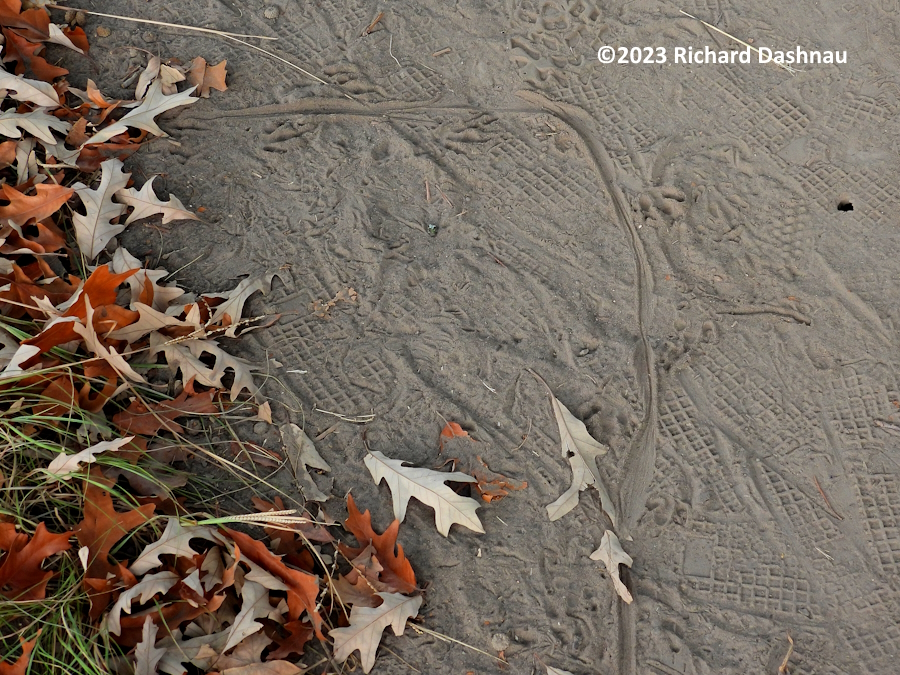
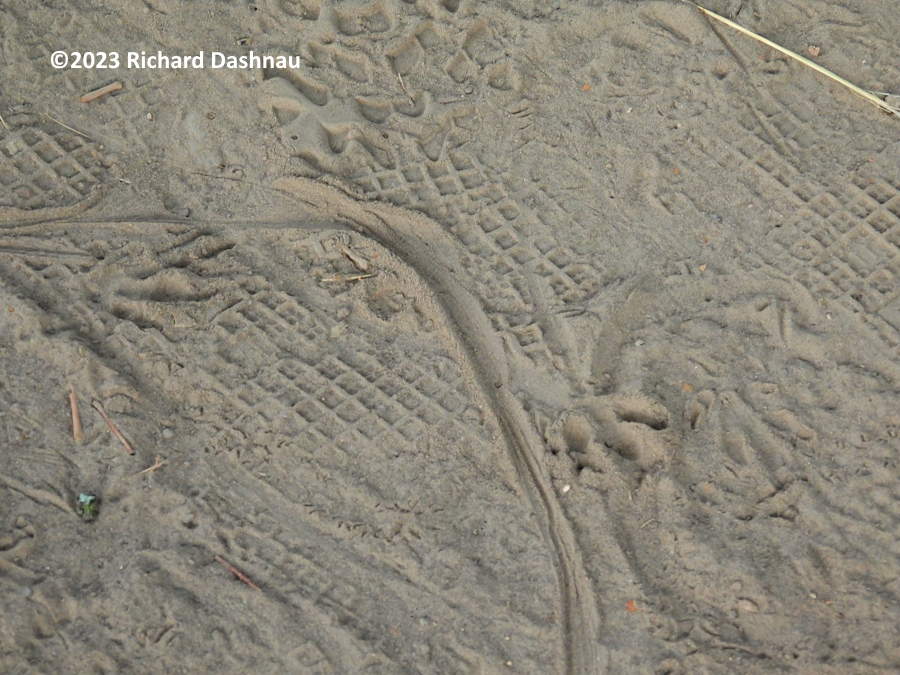
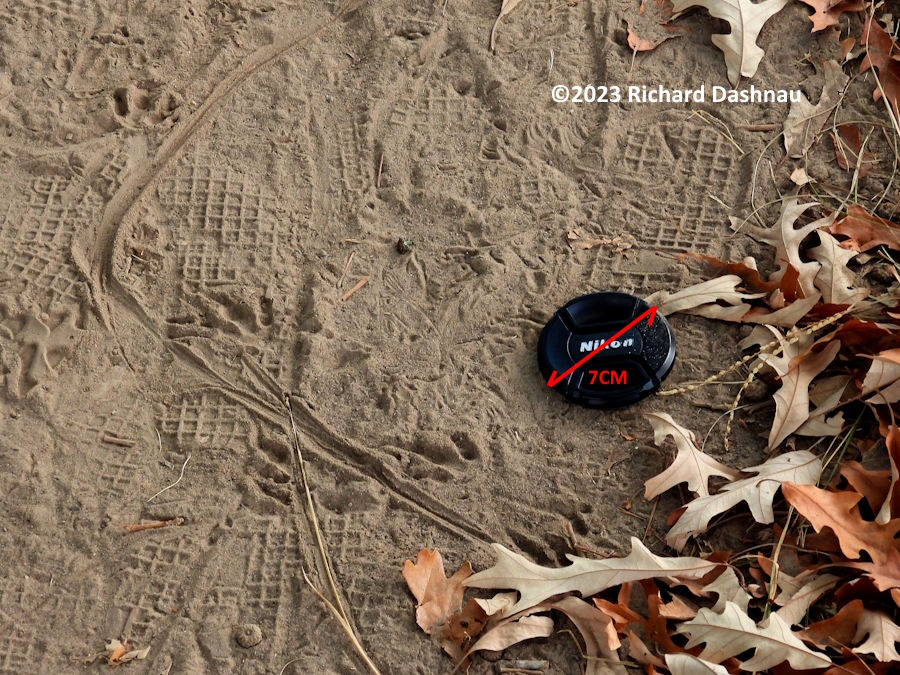
I've included a later picture that shows that lens cap on top of my scale.
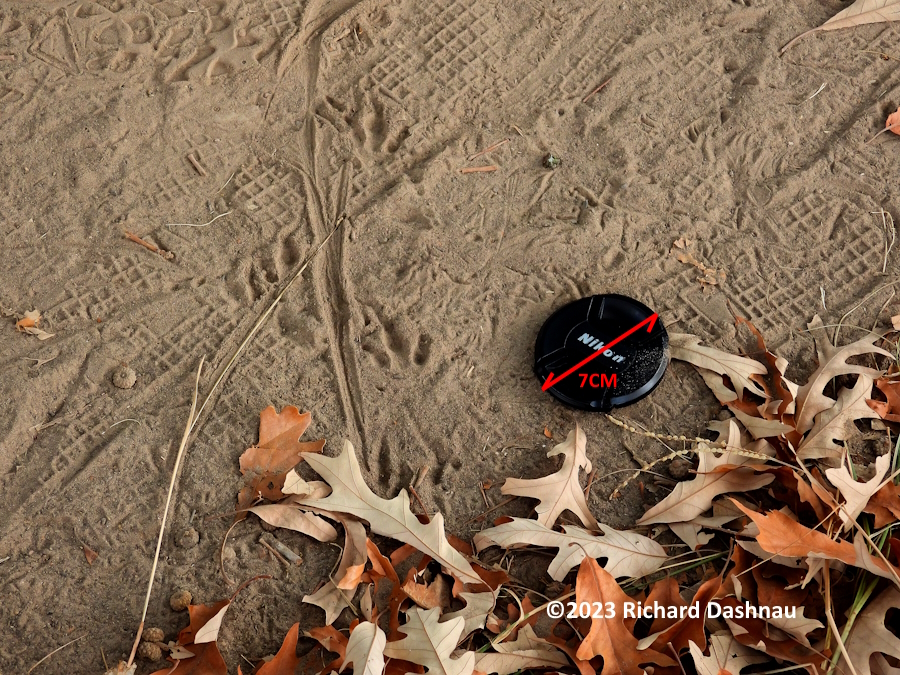
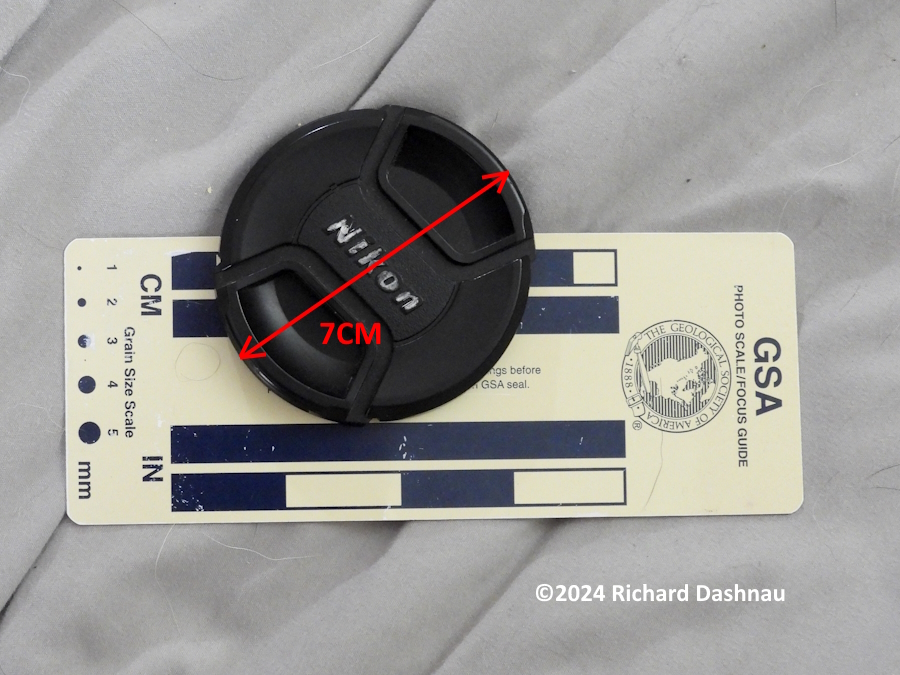
Go to Ichnology page 3
Go to Ichnology page 2
Go to Ichnology page 1
Go back to my home page, Welcome
to rickubis.com
Go
to the RICKUBISCAM
page.




















































































































